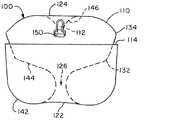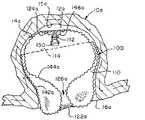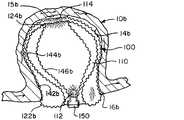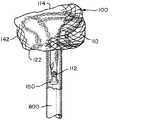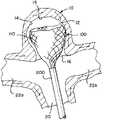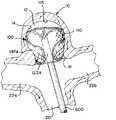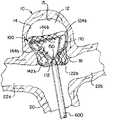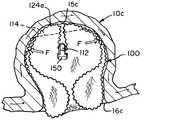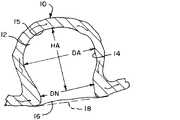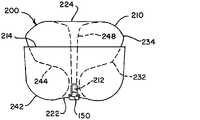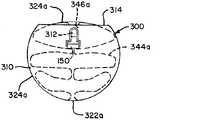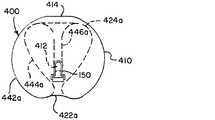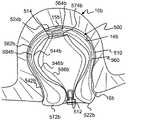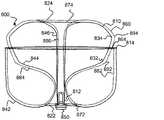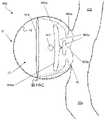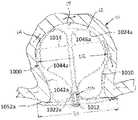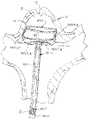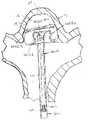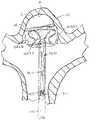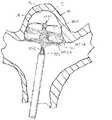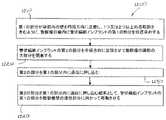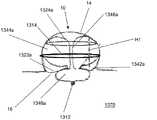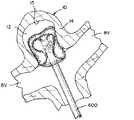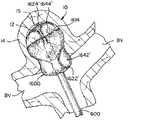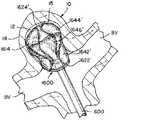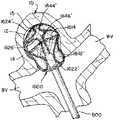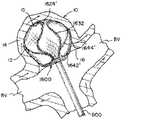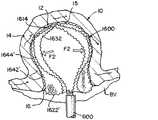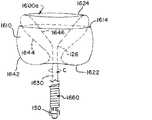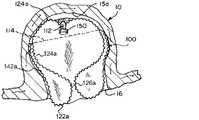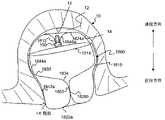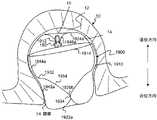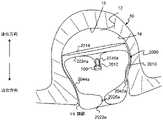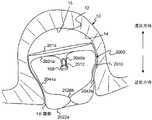JP2022065652A - Inverting braided aneurysm treatment system and method - Google Patents
Inverting braided aneurysm treatment system and methodDownload PDFInfo
- Publication number
- JP2022065652A JP2022065652AJP2021168753AJP2021168753AJP2022065652AJP 2022065652 AJP2022065652 AJP 2022065652AJP 2021168753 AJP2021168753 AJP 2021168753AJP 2021168753 AJP2021168753 AJP 2021168753AJP 2022065652 AJP2022065652 AJP 2022065652A
- Authority
- JP
- Japan
- Prior art keywords
- braid
- aneurysm
- implant
- segment
- shape
- Prior art date
- Legal status (The legal status is an assumption and is not a legal conclusion. Google has not performed a legal analysis and makes no representation as to the accuracy of the status listed.)
- Pending
Links
Images
Classifications
- A—HUMAN NECESSITIES
- A61—MEDICAL OR VETERINARY SCIENCE; HYGIENE
- A61B—DIAGNOSIS; SURGERY; IDENTIFICATION
- A61B17/00—Surgical instruments, devices or methods
- A61B17/12—Surgical instruments, devices or methods for ligaturing or otherwise compressing tubular parts of the body, e.g. blood vessels or umbilical cord
- A61B17/12022—Occluding by internal devices, e.g. balloons or releasable wires
- A61B17/12099—Occluding by internal devices, e.g. balloons or releasable wires characterised by the location of the occluder
- A61B17/12109—Occluding by internal devices, e.g. balloons or releasable wires characterised by the location of the occluder in a blood vessel
- A61B17/12113—Occluding by internal devices, e.g. balloons or releasable wires characterised by the location of the occluder in a blood vessel within an aneurysm
- A—HUMAN NECESSITIES
- A61—MEDICAL OR VETERINARY SCIENCE; HYGIENE
- A61B—DIAGNOSIS; SURGERY; IDENTIFICATION
- A61B17/00—Surgical instruments, devices or methods
- A61B17/12—Surgical instruments, devices or methods for ligaturing or otherwise compressing tubular parts of the body, e.g. blood vessels or umbilical cord
- A61B17/12022—Occluding by internal devices, e.g. balloons or releasable wires
- A61B17/12027—Type of occlusion
- A61B17/12031—Type of occlusion complete occlusion
- A—HUMAN NECESSITIES
- A61—MEDICAL OR VETERINARY SCIENCE; HYGIENE
- A61B—DIAGNOSIS; SURGERY; IDENTIFICATION
- A61B17/00—Surgical instruments, devices or methods
- A61B17/12—Surgical instruments, devices or methods for ligaturing or otherwise compressing tubular parts of the body, e.g. blood vessels or umbilical cord
- A61B17/12022—Occluding by internal devices, e.g. balloons or releasable wires
- A61B17/12131—Occluding by internal devices, e.g. balloons or releasable wires characterised by the type of occluding device
- A61B17/1214—Coils or wires
- A—HUMAN NECESSITIES
- A61—MEDICAL OR VETERINARY SCIENCE; HYGIENE
- A61B—DIAGNOSIS; SURGERY; IDENTIFICATION
- A61B17/00—Surgical instruments, devices or methods
- A61B17/12—Surgical instruments, devices or methods for ligaturing or otherwise compressing tubular parts of the body, e.g. blood vessels or umbilical cord
- A61B17/12022—Occluding by internal devices, e.g. balloons or releasable wires
- A61B17/12131—Occluding by internal devices, e.g. balloons or releasable wires characterised by the type of occluding device
- A61B17/1214—Coils or wires
- A61B17/12145—Coils or wires having a pre-set deployed three-dimensional shape
- A—HUMAN NECESSITIES
- A61—MEDICAL OR VETERINARY SCIENCE; HYGIENE
- A61B—DIAGNOSIS; SURGERY; IDENTIFICATION
- A61B17/00—Surgical instruments, devices or methods
- A61B17/12—Surgical instruments, devices or methods for ligaturing or otherwise compressing tubular parts of the body, e.g. blood vessels or umbilical cord
- A61B17/12022—Occluding by internal devices, e.g. balloons or releasable wires
- A61B17/12131—Occluding by internal devices, e.g. balloons or releasable wires characterised by the type of occluding device
- A61B17/1214—Coils or wires
- A61B17/1215—Coils or wires comprising additional materials, e.g. thrombogenic, having filaments, having fibers, being coated
- A—HUMAN NECESSITIES
- A61—MEDICAL OR VETERINARY SCIENCE; HYGIENE
- A61B—DIAGNOSIS; SURGERY; IDENTIFICATION
- A61B17/00—Surgical instruments, devices or methods
- A61B17/12—Surgical instruments, devices or methods for ligaturing or otherwise compressing tubular parts of the body, e.g. blood vessels or umbilical cord
- A61B17/12022—Occluding by internal devices, e.g. balloons or releasable wires
- A61B17/12131—Occluding by internal devices, e.g. balloons or releasable wires characterised by the type of occluding device
- A61B17/12168—Occluding by internal devices, e.g. balloons or releasable wires characterised by the type of occluding device having a mesh structure
- A—HUMAN NECESSITIES
- A61—MEDICAL OR VETERINARY SCIENCE; HYGIENE
- A61B—DIAGNOSIS; SURGERY; IDENTIFICATION
- A61B17/00—Surgical instruments, devices or methods
- A61B17/12—Surgical instruments, devices or methods for ligaturing or otherwise compressing tubular parts of the body, e.g. blood vessels or umbilical cord
- A61B17/12022—Occluding by internal devices, e.g. balloons or releasable wires
- A61B17/12131—Occluding by internal devices, e.g. balloons or releasable wires characterised by the type of occluding device
- A61B17/12168—Occluding by internal devices, e.g. balloons or releasable wires characterised by the type of occluding device having a mesh structure
- A61B17/12172—Occluding by internal devices, e.g. balloons or releasable wires characterised by the type of occluding device having a mesh structure having a pre-set deployed three-dimensional shape
- A—HUMAN NECESSITIES
- A61—MEDICAL OR VETERINARY SCIENCE; HYGIENE
- A61B—DIAGNOSIS; SURGERY; IDENTIFICATION
- A61B17/00—Surgical instruments, devices or methods
- A61B2017/00831—Material properties
- A61B2017/00867—Material properties shape memory effect
- A—HUMAN NECESSITIES
- A61—MEDICAL OR VETERINARY SCIENCE; HYGIENE
- A61B—DIAGNOSIS; SURGERY; IDENTIFICATION
- A61B17/00—Surgical instruments, devices or methods
- A61B2017/00831—Material properties
- A61B2017/00902—Material properties transparent or translucent
- A61B2017/00915—Material properties transparent or translucent for radioactive radiation
- A61B2017/0092—Material properties transparent or translucent for radioactive radiation for X-rays
- A—HUMAN NECESSITIES
- A61—MEDICAL OR VETERINARY SCIENCE; HYGIENE
- A61B—DIAGNOSIS; SURGERY; IDENTIFICATION
- A61B17/00—Surgical instruments, devices or methods
- A61B17/12—Surgical instruments, devices or methods for ligaturing or otherwise compressing tubular parts of the body, e.g. blood vessels or umbilical cord
- A61B17/12022—Occluding by internal devices, e.g. balloons or releasable wires
- A61B2017/1205—Introduction devices
- A—HUMAN NECESSITIES
- A61—MEDICAL OR VETERINARY SCIENCE; HYGIENE
- A61B—DIAGNOSIS; SURGERY; IDENTIFICATION
- A61B17/00—Surgical instruments, devices or methods
- A61B17/12—Surgical instruments, devices or methods for ligaturing or otherwise compressing tubular parts of the body, e.g. blood vessels or umbilical cord
- A61B17/12022—Occluding by internal devices, e.g. balloons or releasable wires
- A61B2017/1205—Introduction devices
- A61B2017/12054—Details concerning the detachment of the occluding device from the introduction device
Landscapes
- Health & Medical Sciences (AREA)
- Surgery (AREA)
- Life Sciences & Earth Sciences (AREA)
- Heart & Thoracic Surgery (AREA)
- Molecular Biology (AREA)
- Vascular Medicine (AREA)
- Engineering & Computer Science (AREA)
- Biomedical Technology (AREA)
- Reproductive Health (AREA)
- Medical Informatics (AREA)
- Nuclear Medicine, Radiotherapy & Molecular Imaging (AREA)
- Animal Behavior & Ethology (AREA)
- General Health & Medical Sciences (AREA)
- Public Health (AREA)
- Veterinary Medicine (AREA)
- Neurosurgery (AREA)
- Surgical Instruments (AREA)
Abstract
Description
Translated fromJapanese (関連出願の相互参照)
本出願は、各々2020年5月1日に出願された米国特許出願第16/865,116号及び米国特許出願第16/865,165号の一部継続出願であり、これらは各々、2020年1月22日に出願された米国特許出願第16/748,877号の一部継続出願及び2020年4月20日に出願された米国特許出願第16/853,135号の一部継続出願である。米国特許出願第16/748,877号及び米国特許出願第16/853,135号は各々、2019年5月21日に出願され2020年5月19日に米国特許第10,653,425号として発行された米国特許出願第16/418,199号の一部継続出願である。(Mutual reference of related applications)
This application is a partial continuation of U.S. Patent Application Nos. 16 / 856,116 and U.S. Patent Application Nos. 16 / 856,165 filed May 1, 2020, respectively, which are 2020, respectively. A partial continuation of US Patent Application No. 16 / 748,877 filed on January 22, and a partial continuation of US Patent Application No. 16 / 853,135 filed on April 20, 2020. be. U.S. Patent Application Nos. 16 / 748,877 and U.S. Patent Application No. 16 / 853,135 were filed May 21, 2019, respectively, as U.S. Patent No. 10,653,425 on May 19, 2020. This is a partial continuation of the issued US Patent Application No. 16 / 418,199.
本出願はまた、2019年12月5日に出願された米国特許出願第16/703,973号の一部継続出願である。 This application is also a partial continuation of US Patent Application No. 16 / 703,973, filed December 5, 2019.
これらすべての内容は、本明細書に記載されているかのように、その全体が参照により本明細書に組み込まれる。 All of these are incorporated herein by reference in their entirety, as described herein.
(発明の分野)
本発明は、概して、医療器具に関し、より詳細には、動脈瘤治療用塞栓インプラントに関する。(Field of invention)
The present invention relates generally to medical devices and, more particularly to, embolic implants for the treatment of aneurysms.
頭蓋動脈瘤は複雑であり、重要な脳組織に近接していることに起因して、処置するのが困難であり得る。これまでの解決策としては、動脈の血圧及び血流から動脈瘤嚢の内部容積が除去又は排除される血管内処置が挙げられる。血管内又は他の外科的手法の現行の代替法は、動脈瘤の嚢を塞栓材料で充填する又は動脈瘤の入り口若しくは頸部を塞ぐ、血管内送達処置デバイスを含むことができる。両方の手法のいずれも、動脈瘤への血液の流入を防止しようとするものである。動脈瘤嚢を充填する場合、塞栓材料は、血液を凝固させ、動脈瘤内に血栓塊を作成する。動脈瘤頸部を処置する場合、動脈瘤の入り口への血液の流入が阻止され、動脈瘤内での静脈のうっ血を誘発し、動脈瘤内での血栓塊の自然な形成を促進する。 Cranial aneurysms are complex and can be difficult to treat due to their proximity to important brain tissue. Previous solutions include intravascular procedures in which the internal volume of the aneurysm sac is removed or eliminated from the blood pressure and blood flow of the artery. Current alternatives to intravascular or other surgical procedures can include intravascular delivery treatment devices that fill the aneurysm sac with embolic material or block the entrance or neck of the aneurysm. Both methods seek to prevent the inflow of blood into the aneurysm. When filling the aneurysm sac, the embolic material coagulates blood and creates a thrombus mass within the aneurysm. When treating the aneurysm neck, the inflow of blood into the entrance of the aneurysm is blocked, inducing venous congestion within the aneurysm and promoting the natural formation of a thrombosis within the aneurysm.
現行の血管内送達デバイスは、通常、複数の塞栓用コイルを利用して、動脈瘤の嚢を充填するか、又は動脈瘤の入り口を処置するかのどちらかを行う。塞栓用コイルで入り口を処置することによって形成される自然に形成された血栓塊は、動脈壁から膨張が起こる可能性を低減させ、頸部平面に沿った元の親血管形状への再統合を容易にすることができるので、自然に形成された血栓塊は、塞栓用コイルにより包まれた動脈瘤塊と比べて、治癒の改善がもたらされ得る。しかし、動脈瘤の頸部に送達される塞栓用コイルは、特に、入り口が過剰に包まれた場合、血管に接触する際に、血液の流れを妨害するという有害作用を潜在的に有し得る。反対に、入り口が十分に包まれていない場合、血流は、動脈瘤内に残るおそれがある。ある種の動脈瘤形態(例えば、幅広の頸部、分岐など)の処置は、コイル塊を支持し、所望の充填密度を得るためにステント又はバルーンなどの補助デバイスが必要となり得る。埋め込まれると、コイルは、容易に後退又は再位置決めすることができない。更に、多数のコイルで処置された動脈瘤は、多くの場合、コイリング不良、動脈瘤頸部全体が被覆されないこと、血流又は動脈瘤のサイズが大きいために、再開通又は圧縮を起こすので、塞栓用コイルは、動脈瘤を常に効果的に処置するわけではない。 Current intravascular delivery devices typically utilize multiple embolic coils to either fill the aneurysm sac or treat the aneurysm entrance. The naturally formed thrombus clot formed by treating the entrance with an embolic coil reduces the likelihood of swelling from the arterial wall and reintegrates into the original parent vessel shape along the cervical plane. Since it can be facilitated, a naturally formed thrombus mass can result in improved healing compared to an aneurysm mass wrapped by an embolic coil. However, the embolic coil delivered to the neck of the aneurysm can potentially have the adverse effect of obstructing blood flow when contacting blood vessels, especially if the entrance is over-wrapped. .. Conversely, if the entrance is not well wrapped, blood flow can remain within the aneurysm. Treatment of certain aneurysm forms (eg, wide neck, bifurcation, etc.) may require an auxiliary device such as a stent or balloon to support the coil mass and obtain the desired filling density. Once embedded, the coil cannot be easily retracted or repositioned. In addition, aneurysms treated with multiple coils often cause recanalization or compression due to poor coiling, uncovered entire aneurysm neck, and large blood flow or aneurysm size. Embolic coils do not always effectively treat aneurysms.
塞栓用コイルの代替物が、探索されており、例えば、管状編組インプラントが、参照により本明細書に組み込まれる、米国特許第10,751,066号に開示されている。管状編組インプラントは、親血管と連通する穿通枝血管への流れを妨げることなく、動脈瘤又は親血管内の他の動静脈奇形部を、容易、正確、かつ安全に処置する可能性を有する。しかし、塞栓用コイルと比較して、管状編組インプラントは、より新しい技術であり、したがって、管状編組インプラント用の改善された幾何形状、構成、送達システムなどに改善の余地がある。 Alternatives to embolic coils are being sought, for example, tubular braided implants are disclosed in US Pat. No. 10,751,066, which is incorporated herein by reference. Tubular braided implants have the potential to treat aneurysms or other arteriovenous malformations within the parent vessel easily, accurately and safely without obstructing the flow to the perforator vessels that communicate with the parent vessel. However, compared to embolic coils, tubular braided implants are a newer technique and therefore there is room for improvement in improved geometry, composition, delivery system, etc. for tubular braided implants.
したがって、動脈瘤処置のためのインプラント向けの方法、デバイス及びシステムの改善が必要とされている。 Therefore, there is a need for improvements in methods, devices and systems for implants for the treatment of aneurysms.
例示的なシステムは、管状編組、カテーテル、及び塞栓コイルを含むことができる。管状編組は、開放端部、挟持端部、及び所定の形状を有することができる。所定の形状において、編組が、開放端部から第1の反転部まで延在する第1のセグメント、第1の反転部から第2の反転部まで延在する第2のセグメント、及び第2のセグメントに囲まれ、第2の反転部から挟持端部まで延在する第3のセグメントを有することができる。第2のセグメントは、開口部を有する袋部を第1の反転部の近くに形成することができる。カテーテルは、内部を通る管腔と、遠位端部と、袋部の開口部を通って袋部に挿入されるような大きさの、遠位端部における外径とを有することができる。塞栓コイルは、管状編組から切り離され、管腔内に位置決めされる。塞栓コイルは、カテーテルの遠位端部から出るように構成されている。 Exemplary systems can include tubular braids, catheters, and embolic coils. The tubular braid can have an open end, a pinching end, and a predetermined shape. In a given shape, the braid has a first segment extending from the open end to the first inversion, a second segment extending from the first inversion to the second inversion, and a second. It is possible to have a third segment that is surrounded by segments and extends from the second inversion to the pinching end. The second segment can form a bag with an opening near the first inversion. The catheter can have a lumen through the interior, a distal end, and an outer diameter at the distal end sized to be inserted into the bag through the opening of the bag. The embolic coil is detached from the tubular braid and positioned within the lumen. The embolic coil is configured to exit from the distal end of the catheter.
管状編組は、管状編組が実質的に球状の空洞によって収縮されるときに、所定の形状に基づく埋め込み形状で安定であり得る。埋め込み形状において、第1のセグメントの少なくとも一部が、実質的に球形の空洞の空洞壁に接触するように位置決めされ得、所定の形状の第1の反転部に対応する近位反転部が、実質的に球形の空洞への入口に位置決めされ得、袋部が、実質的に球形の空洞内に位置決めされ得、袋部の開口部が、実質的に球形の空洞への入口でアクセス可能であり得、開口部が、カテーテルの遠位端部を袋部に受容されるように構成され得る。埋め込み形状では、編組は、カテーテルの遠位端部が第1のセグメントと袋部との間に位置決めされるように、カテーテルが細孔のうちの1つを通過することができるような大きさである、近位変換の近くに細孔を有することができる。 The tubular braid can be stable in an embedded shape based on a given shape when the tubular braid is contracted by a substantially spherical cavity. In the embedded shape, at least a portion of the first segment can be positioned to contact the cavity wall of a substantially spherical cavity, with a proximal inversion corresponding to the first inversion of the given shape. The bag can be positioned at the entrance to the substantially spherical cavity, the bag can be positioned within the substantially spherical cavity, and the opening of the bag can be accessed at the entrance to the substantially spherical cavity. Possible, the opening may be configured to receive the distal end of the catheter into the bag. In the implantable shape, the braid is sized so that the catheter can pass through one of the pores so that the distal end of the catheter is positioned between the first segment and the bag. Can have pores near the proximal transformation.
埋め込み形状では、開口部は、カテーテルの遠位端部を受容するように拡張し、カテーテルが開口部から取り外されたときに収縮するように弾性であり得る。 In the implantable form, the opening can be elastic to expand to receive the distal end of the catheter and to contract when the catheter is removed from the opening.
塞栓コイルは、管状編組が埋め込み形状にあるときに袋部内に適合するようにサイズ決めされ得る。 The embolic coil can be sized to fit within the bag when the tubular braid is in the embedded shape.
所定の形状において、管状編組が、中心軸を中心に円筒対称であり、第2のセグメントが、袋部から近位方向に延在し、中心軸の周りで収縮し、袋部の開口部を画定する柱状セクションを含み得る。 In a given shape, the tubular braid is cylindrically symmetric about the central axis, with a second segment extending proximally from the sac and contracting around the central axis to open the opening of the sac. It may include a demarcating columnar section.
所定の形状において、第2のセグメントは、柱状セクションから袋部を分離するおよそ90°の屈曲部を含むことができる。 In a given shape, the second segment can include a bend of approximately 90 ° that separates the bag from the columnar section.
編組が所定の形状にあるときの柱状セクションの直径は、編組が埋め込み形状にあるときに圧潰され得る。 The diameter of the columnar section when the braid is in a given shape can be crushed when the braid is in an embedded shape.
柱状セクションは、管状編組が埋め込み形状にあるとき、柱状の形状であり得る。 The columnar section can be in a columnar shape when the tubular braid is in an embedded shape.
所定の形状の管状編組の外側輪郭は、およそ直円筒であり得る。代替的に、所定の形状の管状編組の外側輪郭は、およそ洋梨形状であり得る。 The outer contour of a tubular braid of a given shape can be approximately a straight cylinder. Alternatively, the outer contour of the tubular braid of a given shape can be approximately pear-shaped.
動脈瘤インプラントの例示的な管状編組は、開放端部及び挟持端部を有することができる。管状編組は、管状編組が実質的に球状の空洞によって収縮されたときに安定である所定の形状及び埋め込み形状を有することができる。 An exemplary tubular braid of an aneurysm implant can have an open end and a pinching end. The tubular braid can have a predetermined shape and an embedded shape that is stable when the tubular braid is contracted by a substantially spherical cavity.
所定の形状において、編組が、開放端部から第1の反転部まで延在する第1のセグメント、第1の反転部から第2の反転部まで延在し、第1の反転部の近くに開口部を含む袋部を形成する第2のセグメント、及び第2のセグメントに囲まれ、第2の反転部から挟持端部まで延在する第3のセグメントを有することができる。埋め込み形状は、所定の形状に基づくことができる。所定の形状において、管状編組が、中心軸を中心に円筒対称であり、第2のセグメントが、袋部から近位方向に延在し、中心軸の周りで収縮し、袋部の開口部を画定する柱状セクションを含み得る。 In a given shape, the braid extends from the open end to the first inversion, the first segment, from the first inversion to the second inversion, near the first inversion. It is possible to have a second segment that forms a bag portion including an opening, and a third segment that is surrounded by the second segment and extends from the second inversion portion to the pinching end portion. The embedded shape can be based on a predetermined shape. In a given shape, the tubular braid is cylindrically symmetric about the central axis, with a second segment extending proximally from the sac and contracting around the central axis to open the opening of the sac. It may include a demarcating columnar section.
埋め込み形状において、第1のセグメントの少なくとも一部が、実質的に球形の空洞の空洞壁に接触するように位置決めされ得る、埋め込み形状であって、所定の形状の第1の反転部に対応する近位反転部が、実質的に球形の空洞への入口に位置決めされ、袋部が、実質的に球形の空洞内に位置決めされ、袋部の開口部が、ねじれており、それによって開口部を介した袋部へのアクセスを阻止することができる。埋め込み形状において、柱状セクションは、中心軸の周りでねじれることができる。 In the embedded shape, at least a portion of the first segment is an embedded shape that can be positioned to contact the cavity wall of a substantially spherical cavity, corresponding to a first inverted portion of a predetermined shape. The proximal inversion is positioned at the entrance to the substantially spherical cavity, the bag is positioned within the substantially spherical cavity, and the opening of the bag is twisted, thereby opening the opening. It is possible to prevent access to the bag portion through the bag. In the embedded shape, the columnar section can be twisted around the central axis.
動脈瘤を治療する例示的な方法は、以下のように提示されるステップの任意の組み合わせを特定のものではなく、本明細書に提示されない追加のステップを含むことができる。編組は、送達構成において、送達システムへの取り付けを介して、カテーテルを通して送達され得る。編組は、送達構成の外側表面を含むことができる。編組された袋部は、編組された袋部が送達構成における編組の外部表面に対応する内部表面を含むように、動脈瘤嚢内に編組された袋部を作成することができる。編組は、送達システムから切り離すことができ、それによって編組を動脈瘤嚢内で埋め込み形状に埋め込むことができる。編組を送達システムから取り外した後、塞栓コイルを編組された袋部に挿入することができる。 An exemplary method of treating an aneurysm is not specific to any combination of steps presented as follows and may include additional steps not presented herein. The braid can be delivered through a catheter in a delivery configuration via attachment to a delivery system. The braid can include the outer surface of the delivery configuration. The braided bag can create a braided bag within the aneurysm sac such that the braided bag contains an inner surface that corresponds to the outer surface of the braid in the delivery configuration. The braid can be detached from the delivery system, thereby implanting the braid in an implantable shape within the aneurysm sac. After the braid is removed from the delivery system, the embolic coil can be inserted into the braided bag.
本方法は、編組の第1の部分を動脈瘤壁に並置することを更に含むことができる。本方法は、動脈瘤頸部の近くで編組を反転させることによって近位反転部を作成することを更に含むことができる。本方法は、編組された袋部が近位反転部と遠位反転部との間に延在するように、動脈瘤嚢内で編組を反転させることによって遠位反転部を作成することを更に含むことができる。 The method can further include juxtaposing the first portion of the braid on the aneurysm wall. The method can further include creating a proximal inversion by inversion of the braid near the aneurysm neck. The method further comprises creating a distal inversion by inverting the braid within the aneurysm sac such that the braided pouch extends between the proximal and distal inversions. be able to.
本方法は、編組が埋め込み形状の動脈瘤嚢内にある間に、編組された袋部を第1の部分の開放端部で取り囲むことを更に含むことができる。 The method can further comprise enclosing the braided pouch with the open end of the first portion while the braid is in the implantable aneurysm sac.
編組は、埋め込み形状が、編組の所定の形状に部分的に基づいて、動脈瘤嚢の形状に部分的に基づくように埋め込まれることができる。 The braid can be implanted so that the implant shape is based in part on the shape of the aneurysm sac, based in part on the predetermined shape of the braid.
編組が所定の形状にあるとき、近位反転部及び遠位反転部が編組のそれぞれの反転部に対応するように、編組を埋め込むことができる。 When the braid is in a predetermined shape, the braid can be embedded so that the proximal inversion and the distal inversion correspond to the respective inversions of the braid.
本方法は、編組を送達システムから取り外した後に、編組を動脈瘤内で自己固定させることを更に含むことができる。 The method can further include self-fixing the braid within the aneurysm after removing the braid from the delivery system.
本方法は、編組された袋部を塞栓コイルと共に拡張することを更に含むことができる。 The method can further include expanding the braided bag with an embolic coil.
編組を送達システムから取り外すことは、挟持された端部が編組された袋部内に懸架されるように、送達システムから編組の挟持端部を解放することを更に含むことができる。代替的に、送達システムから編組を取り外すことは、送達システムから編組の挟持端部を解放することを更に含むことができ、これにより、挟持端部は、動脈瘤頸部によって画定される平面の近くに位置決めされる。 Removing the braid from the delivery system can further include releasing the braided pinch end from the delivery system such that the pinched end is suspended within the braided bag. Alternatively, removing the braid from the delivery system can further include releasing the pinch end of the braid from the delivery system, whereby the pinch end is in the plane defined by the aneurysm neck. Positioned close.
編組は、編組の挟持端部が送達システムと接触し、編組が、編組の挟持端部から遠位の開放端部まで遠位方向に単層管状形状で延在するように、送達構成で送達することができる。 The braid is delivered in a delivery configuration such that the pinching end of the braid contacts the delivery system and the braid extends distally in a single layer tubular shape from the pinching end of the braid to the distal open end. can do.
本発明の上記及び更なる態様は、添付の図面と併せて以下の説明を参照して更に考察され、様々な図面において、同様の数字は、同様の構造要素及び特徴を示す。図面は、必ずしも縮尺どおりではなく、代わりに、本発明の原理を例示することに主眼が置かれている。図は、限定としてではなく単なる例示として、本発明のデバイスの1つ又は2つ以上の実装形態を描写している。
本明細書に提示されている例は、概して、動脈瘤嚢内に固定し、動脈瘤頸部の大部分を閉塞することができる編組インプラントを含む。本インプラントは、所定の形状に硬化されて、マイクロカテーテルを介して送達するよう圧縮され、所定の形状及び編組が埋め込まれる動脈瘤の幾何形状に基づいた少なくとも1つの埋め込み位置に埋め込まれ得る、管状編組を含むことができる。 The examples presented herein generally include braided implants that can be immobilized within the aneurysm sac and occlude most of the aneurysm neck. The implant is tubular, cured to a given shape, compressed for delivery via a microcatheter, and may be placed in at least one implant location based on the geometry of the aneurysm in which the given shape and braid is implanted. Can include braids.
図1A~図1Cは、図1Aに例示されている所定の形状、並びに図1B及び図1Cに例示されている2つの個別の埋め込み形状を有することができる、例となる編組インプラント100の例示である。インプラント100は、図1Bに例示されている大きい方の動脈瘤10a、及び図1Cに例示されている小さい方の動脈瘤10bを含む、ある範囲のサイズの動脈瘤を処置することができる。インプラント100は、大きい方の動脈瘤10aの処置に貢献することができる第1の埋め込み形状(図1B)、及び小さい方の動脈瘤10bの処置に貢献することができる第2の埋め込み形状(図1C)を有することができる。インプラント100は、開放端部114及び挟持端部112を有する管状編組110を含むことができる。インプラント100は、挟持端部112において、編組110に取り付けられた脱着機構部150を含むことができる。管状編組110は、所定の形状に形成され得(図1A)、マイクロカテーテルを介して送達するために圧潰され、脱着機構部150において送達システムに取り付けられ、2つの埋め込み形状の一方又は他方に類似した形状で埋め込まれ得る(図1B又は図1C)。 1A-1C are illustrations of an
図1Aを参照すると、管状編組110が所定の形状にあるとき、編組110を3つのセグメント142、144、146に分割する、2つの反転部122、124を含むことができる。所定の形状では、編組110は、編組110の開放端部114から反転部122の一方まで延在している外側セグメント142、編組110の挟持端部112から反転部124の他方まで延在している内側セグメント146、及び2つの反転部122、124の間に延在する中間セグメント144を有することができる。管状編組110は、所定の形状にある場合、中心縦軸yを中心に、実質的に半径方向に対称となり得る(図6Aを参照されたい)。図1Aは、各セグメント142、144、146の輪郭を例示しており、脱着機構部150は、機械式インプラント送達システム(例示せず)と共に使用され得る平坦鍵部として例示されている。 Referring to FIG. 1A, when the
管状編組110は、編組を外側方向に最初に反転させて、内側セグメント146と、反転部124を備える中間セグメント144とを分離することにより所定の形状に形成することができ、次に、中間セグメント144は、例示されている実質的に「S」形状の輪郭を生成する形態の上に成形することができ、最後に、編組110を、やはり外側方向に反転させて、中間セグメント144と別の反転部122を備える外側セグメント142とを分離することができる。必要な場合、編組は、開放端部114において整えることができる。開放端部114は、中間セグメント144を囲むよう位置決めされ得る。開放端部114は、例示されているとおり、編組の高さの中間の第3の区域内に位置決めされ得る。 The
インプラント100が埋め込まれたとき、動脈瘤頸部の閉塞を最大化するために、中間セグメント144の「S」形状の伸張をより低くすることによって、頸部開口部126を最小化するのが有利となり得る。中間セグメント144は、1つ又は2つ以上の屈曲部132、134を有することができる。この屈曲部132、134は、編組110が図1Cに例示されている第2の埋め込み形状へと移動するのを容易にするよう位置決めされ得、屈曲部132、134は、第1及び/又は第2の埋め込み形状にある編組110を安定化するよう位置決めされ得る。 When
管状編組110は、所定の形状に熱硬化して、カテーテルを介して送達するよう変形され得、所定の形状に基づいて埋め込み形状に自己拡張することができる記憶形状材料を含むことができ、埋め込まれた動脈瘤の解剖学的構造によって留め置かれる。 The
図1Bに例示されているとおり、編組110は、第1の埋め込み形状にあるとき、動脈瘤壁14aに接触する外側層142a、外側層142a内に入れ子にされた袋部144a、動脈瘤頸部16aに位置決めされた近位反転部122a、及び動脈瘤壁14aの遠位部分15aの近傍に位置決めされている遠位反転部124aを有することができる。第1の埋め込み形状において、編組110の脱着機構部150及び挟持端部112は、袋部144a内に吊り下げられ得る。 As illustrated in FIG. 1B, the
図1A及び図1Bに例示されているとおり、第1の埋め込み形状にある管状編組110は、所定の形状に比べて、半径方向に圧縮されて、垂直方向に延在され得る。第1の埋め込み形状にある外側層142aは、所定の形状にある外側層142に相当することができ、第1の埋め込み形状にある近位反転部122aは、所定の形状にある外側層142に隣接する反転部122に相当することができ、第1の埋め込み形状にある袋部144aは、所定の形状にある中間セグメント144に相当することができ、第1の埋め込み形状にある遠位反転部124aは、所定の形状にある内側セグメント146に隣接する反転部124に相当することができ、第1の埋め込み形状にある脱着機構部150を吊り下げている内側編組セグメント146aは、所定の形状にある内側セグメント146に相当することができる。第1の埋め込み形状では、袋部144aは、所定の形状にある、頸部開口部126に相当する頸部開口部126aを有することができる。 As illustrated in FIGS. 1A and 1B, the
図1Cに例示されているとおり、編組110は、第2の埋め込み形状にあるとき、動脈瘤壁14bに接触する外側層142b、動脈瘤頸部16bに位置決めされている近位反転部122b、外側層142b内に延在し、外側層142bを押し込む中間層144b、編組110の開放端部114の近傍に位置決めされた遠位反転部124b、及び中間層144b内に延在しており中間層144bを押し込む内側層146bを有することができる。第2の埋め込み形状では、編組110の脱着機構部150及び挟持端部112は、近位反転部122bの近傍の動脈瘤頸部16bに位置決めされ得る。 As illustrated in FIG. 1C, the
図1A及び図1Cに例示されているとおり、第2の埋め込み形状にある管状編組110は、所定の形状に比べて、半径方向に圧縮され得、所定の形状の中間セグメント144は、折り重ねられることができ、その結果、管状編組110の高さは、所定の形状に比べて、第2の埋め込み形状に圧縮される。代替的に、第2の埋め込み形状は、動脈瘤の高さよりも著しく小さい直径を有する動脈瘤に、第2の埋め込み形状で埋め込まれると、所定の形状に比べて、半径方向に圧縮され得、第2の埋め込み形状にある編組の高さは、所定の形状にある編組の高さよりも高くあることができる。 As illustrated in FIGS. 1A and 1C, the
第2の埋め込み形状にある外側層142bは、所定の形状にある外側層142に相当することができ、第2の埋め込み形状にある近位反転部122bは、所定の形状にある外側層142に隣接する反転部122に相当することができ、第2の埋め込み形状にある中間層144b及び内側層146bは、所定の形状にある中間セグメント144に相当することができ、第2の埋め込み形状にある遠位反転部124bは、所定の形状にある中間セグメント144における屈曲部134に相当することができ、第2の埋め込み形状にある内側層146bを形成する脱着機構部150の近傍の編組110の一部は、所定の形状にある内側セグメント146に相当することができる。 The
図2A~図2Hは、編組110がマイクロカテーテル600を出ると、所定の形状まで拡張する編組110を有する、例となるインプラント100の例示である。インプラント100は、図1Aに例示されているものに類似した所定の形状を有する。図2Aに例示されているとおり、編組110は、マイクロカテーテル600を介して送達されるサイズの圧縮された円周/直径及び長さLを有する管状編組の単層に拡張される送達形状に成形され得る。例示のインプラント100は、約22mm~約25mmの長さLを有する。当業者によって認識され理解されるように、特定の編組110の長さLは、治療される動脈瘤のサイズ及び形状に基づいて調整することができる。 2A-2H are illustrations of an
マイクロカテーテル600を介する送達の間に、脱着機構部150は、インプラント100の近位端部において送達システムに取り付けることができ、挟持端部112は、インプラント100の近位端部の近傍に位置決めされ得、開放端部114は、インプラント100の遠位端部を画定することができる。編組110が単層チューブに圧潰されると、マイクロカテーテルを介して送達されるとき、編組110への摩擦力の作用を緩和するのに十分に小さい直径及び十分に短い長さLを有する編組110をもたすことができ、これにより、編組110は、一部の用途において脱被覆状態で送達されることが可能となり得る。 During delivery via the
図2Bに例示されているとおり、開放端部114は、編組110の他の任意の部分がマイクロカテーテルを出る前に、マイクロカテーテル600を出るよう位置決めされ得る。開放端部114がマイクロカテーテル600を出ると、開放端部114は拡張することができる。開放端部114が、例示されているとおり、動脈瘤により拘束されていない場合、開放端部は、所定の形状で、その円周にまで拡張することができる。 As illustrated in FIG. 2B, the
図2Cに例示されているとおり、編組110の遠位部分は、これがマイクロカテーテル600を出ると、半径方向への拡張を継続することができる。 As illustrated in FIG. 2C, the distal portion of the
図2Dに例示されているとおり、編組110は、編組110が、マイクロカテーテル600から更に押されると、外側セグメント142を画定する反転部122を形成することができる。 As illustrated in FIG. 2D, the
図2E~図2Gに例示されているとおり、中間セグメント144の「S」形状は、編組110が、マイクロカテーテル600から更に押されると、形成を開始することができる。 As illustrated in FIGS. 2E-2G, the "S" shape of the
図2Hに例示されているとおり、編組110のすべて又はほぼすべてが、マイクロカテーテル600を出ると、動脈瘤によって留め置かれていない編組110は、図1Aに例示されている形状に類似した所定の形状に拡張することができる。所定の形状では、例示されたインプラントの編組110は、約6mm~約6.5mmの直径及び約5mm~約5.5mmの高さを有する。 As illustrated in FIG. 2H, when all or almost all of the
図2Hに例示されている所定の形状にある編組110の最外径と、図2Aに例示されている送達形状にある編組110の長さとの比は、約0.3~約0.24である。 The ratio of the outermost diameter of the
図3A~図3Hは、2つの異なる埋め込み形状にある動脈瘤10内で拡張する、図2A~図2Hに例示されているインプラント100の例示である。動脈瘤10は、高さが約6mm、直径が約6mm、頸部の直径が約4mmである。動脈瘤10の寸法を、図2Hに例示される所定の形状の編組110と比較すると、編組110は、わずかに大きい直径及びわずかに小さい高さを有し、動脈瘤10の内部は、実質的に球形であるが、編組110の外側寸法は、より円筒形である(測定方向については図6A及び図6Bを参照のこと)。したがって、インプラント100の編組110が動脈瘤10によって留め置かれていると、編組110は、半径方向に拘束される。 3A-3H are illustrations of the
図3Aに例示されているとおり、インプラント100は、図2Aに関連して記載されているとおり、マイクロカテーテル600を介して、動脈瘤10へと送達され得る。管状編組110の開放端部114がマイクロカテーテル600を出ると、これは、動脈瘤10内で拡張することができる。例示されている動脈瘤10は、幹血管20及び2本の分岐血管22a、22bを含む分岐部に位置決めされ、マイクロカテーテル600は、幹血管20を通って送達されているように例示されている。インプラントは、湾曲したマイクロカテーテルを介して血管の側壁上の動脈瘤へと送達され得、このような手技は、本開示の範囲によって包含されることが意図されることが企図されている。 As illustrated in FIG. 3A, the
図3Bに例示されているとおり、編組110が、マイクロカテーテル600から遠位に更に押されると、編組110は、拡張して動脈瘤壁14に並置し、動脈瘤頸部16に形状を合わせることができる。処置される動脈瘤10は、所定の形状にある管状編組110の外径より小さい直径を有することができ、その結果、編組110は、外側方向に拡張する傾向があり、動脈瘤壁14への力、及び動脈瘤頸部16の外周周りの封止をもたらす。編組110によってもたらされる動脈瘤壁14及び頸部16の外周に対する半径方向の力は、幅広い頸部動脈瘤におけるインプラント100の固定と動脈瘤10の頸部16の封止の両方を行うのに十分となり得るので、インプラント100は、分岐部において一般に発生するなどの、幅広い頸部動脈瘤を処置するのに特に好適となり得る。 As illustrated in FIG. 3B, when the
図3Cに例示されているとおり、編組110が、マイクロカテーテル600から遠位に更に押されると、近位反転部122aが形成され得る。 As illustrated in FIG. 3C, when the
図3Dに例示されているとおり、マイクロカテーテル600は、動脈瘤頸部16に、近位反転部122aを留置するよう操作され得る。近位反転部122aは、動脈瘤10と分岐血管22a、22bとの間の境界18(図6Bを参照されたい)を画定する平面の近位側面に留置され得る。一部の用途では、平面18から近位方向に十分に離して近位反転部122aを留置し、その結果、編組110の外側層142aが、動脈瘤頸部16の外周の周りを封止するが、インプラント100が血管22a、22b、20への閉塞となるほどかなり近位に留置されない。 As illustrated in FIG. 3D, the
図3Eに例示されているとおり、編組110は、動脈瘤嚢12の内部で拡張することができ、かつ延在して、編組110の外側層142aの内側表面に並置することができる。外側層142aへの並置は、外側層142aを動脈瘤壁14に固定する更なる力をもたらすことができる。 As illustrated in FIG. 3E, the
図3Fに例示されているとおり、動脈瘤10は、図1Bに例示されているものに類似した第1の埋め込み形状にある管状編組110を収容することが可能な高さを有する。編組110は、半径方向に拘束されて、動脈瘤が実質的に球形状をしていることに比べて、一層円筒の形状を有するので、編組110は、所定の形状よりも高い動脈瘤を収容するよう、所定の形状の高さを超えて延在することができる。例示では、所定の形状にあるインプラント100の管状編組110は、動脈瘤の高さよりも約0.5mm~1mm分短い高さを有するか、又は言い換えると、インプラントは、所定の形状に比べて、第1の埋め込み形状において、約10%~約20%の高さの分、延在する。 As illustrated in FIG. 3F, the
編組は、図3Gに例示されているとおり近位に引っ張られて、図1Cに例示されている第2の埋め込み形状に類似した図3Hに例示されている第2の埋め込み形状を形成することができるが、図1Cに例示されている動脈瘤10bは、図3Hに例示されている疑似動脈瘤10よりも小さい(編組110に比べて比例的に)という点で異なる。インプラント100は、送達システムから放出される前に、インプラント100は、マイクロカテーテル600に一部又は完全に後退して、第1の埋め込み形状又は第2の埋め込み形状のどちらか一方で再位置決めされ得る。更に又は代替的に、マイクロカテーテル600は、遠位に移動されて、図3Hに例示されている第2の埋め込み形状から、図3Fに例示されている第1の埋め込み形状まで編組110を移動させることができる。一部の用途では、医師は、インプラント100を位置決めしながら、第1の埋め込み形状又は第2の埋め込み形状が、動脈瘤の解剖学的構造及び処置部位に一層好適となるかどうかを選択することができる。図3A~図3Hに例示されている動脈瘤10及びインプラント100に類似した形状の動脈瘤及びインプラントを含む処置に関し、この例の実装形態における第1の埋め込み形状は、動脈瘤壁14と接触してより大きい表面積の編組110を実現するので、(図3Gに例示されている第2の埋め込み形状よりもむしろ)図3Fに例示されている第1の埋め込み形状にある編組110を成形するのが一層有利となり得る。 The braid can be pulled proximally as illustrated in FIG. 3G to form the second embedding shape exemplified in FIG. 3H, which is similar to the second embedding shape exemplified in FIG. 1C. However, the
図4A及び図4Bは、図2A~図2H及び図3A~図3Hに例示されている例となるインプラントの編組110の例示であり、これらは、管状編組110が、チューブ内で拡張されて、例となるインプラント100のその寸法を有するインプラント100が処置に好適となると思われる、動脈瘤直径及び動脈瘤高さの範囲が決まることを示している。図4Aは、5mmの直径を有するチューブ中の編組110を例示している。編組110は、第1の埋め込まれた形状であり、約8mmの高さを有する。したがって、編組110は、その所定の形状から直径約1mm~1.5mm、又は約17%~23%で半径方向に拘束され、高さが約2.5mm~3mm、又は約45%~60%で垂直方向に拡張される。 4A and 4B are illustrations of the
図4Bは、4mmの直径を有するチューブ中の編組110を例示している。編組110は、第2の埋め込まれた形状であり、約6mmの高さを有する。したがって、編組は、その所定の形状から直径約2mm~2.5mm、又は約33%~38%の間で半径方向に拘束され、約0.5mm~1mm、又は約10%~20%で垂直方向に拡張される。 FIG. 4B illustrates a
図2Hに関連して例示及び記載されているような所定の形状及び寸法を有するインプラントは、したがって、直径が約4mm~約5mmであり、高さが約6mm~約8mmである動脈瘤を治療するのに好適であり得る。図3Fに例示されているとおり、インプラントはまた、直径6mm及び高さ6mmを有する動脈瘤を治療するのに好適であり得る。当業者によって認識され理解されるように、所定の形状にある管状編組の寸法は、本明細書に記載の原理に従って本明細書に具体的に概説されていないサイズの範囲内の動脈瘤を治療するように調整することができる。そのように成形されたインプラントのコレクションは、医師が入手可能となり得、医師は、動脈瘤の高さ、直径、頸部直径及び/又は他の解剖学的特徴に基づいて、コレクションから好適なインプラントを選択することができる。 Implants having predetermined shapes and dimensions as exemplified and described in connection with FIG. 2H therefore treat aneurysms having a diameter of about 4 mm to about 5 mm and a height of about 6 mm to about 8 mm. May be suitable for As illustrated in FIG. 3F, implants may also be suitable for treating aneurysms having a diameter of 6 mm and a height of 6 mm. As will be recognized and understood by those skilled in the art, the dimensions of the tubular braid in a given shape will treat aneurysms within the size range not specifically outlined herein according to the principles described herein. Can be adjusted to. A collection of such molded implants may be available to the physician, who will be suitable implants from the collection based on the height, diameter, cervical diameter and / or other anatomical features of the aneurysm. Can be selected.
それぞれが特有の形状をしている管状編組を有するインプラントのコレクションが作成されて、直径及び高さが様々な動脈瘤を処置するためのインプラントのカタログを提供することができる。このカタログは、直径が3mm~15mmの範囲、及び高さが3mm~15mmの範囲、又は別の例では、直径が3~11mmの範囲、及び高さが3~7mmの範囲の動脈瘤を処置するのに好適なインプラントを含むことができる。当業者により認識及び理解されているとおり、一部の動脈瘤の寸法は、かなり稀であり、カタログは、大きい高さ:直径の比、又は大きい直径:高さの比を有する動脈瘤を処置するためのインプラントを含むことを必要としない。 A collection of implants, each with a tubular braid having a unique shape, can be created to provide a catalog of implants for treating aneurysms of various diameters and heights. This catalog treats aneurysms in the range of 3 mm to 15 mm in diameter and 3 mm to 15 mm in height, or in another example, in the range of 3 to 11 mm in diameter and 3 to 7 mm in height. Suitable implants can be included. As recognized and understood by those of skill in the art, the dimensions of some aneurysms are fairly rare and the catalog treats aneurysms with large height: diameter ratios or large diameter: height ratios. It is not necessary to include an implant to do so.
コレクション中の各インプラントは、部分範囲の直径及び部分範囲の高さを有する動脈瘤を処置するのに好適となり得る。例となるカタログは、以下に限定されないが、以下のサイズの部分範囲(直径範囲(mm)、高さ範囲(mm)):(3~5、3~5)、(6~8、4~5)及び(9~11、5~7)のうちの1つ又は2つ以上の動脈瘤を処置するためのインプラントのリストを含むことができる。 Each implant in the collection may be suitable for treating an aneurysm with a partial range diameter and partial range height. The example catalog is not limited to the following, but is a partial range of the following sizes (diameter range (mm), height range (mm)): (3 to 5, 3 to 5), (6 to 8, 4 to). 5) and (9-11, 5-7) can include a list of implants for treating one or more aneurysms.
一部の例では、サイズの部分範囲の各々は、その部分範囲内にある動脈瘤を処置するのに好適な特有のサイズ及び形状をしている管状編組を有する単一インプラントによって処置され得る。いくつかの例において、カタログ中の部分範囲は、約10mm、約40mmである(編組が、マイクロカテーテルを介して送達するよう圧潰されたときの長さ)、及び/又はその間の長さを含む送達長さを有する管状編組を有する各インプラントによって表示され得る。 In some examples, each of the subranges of size can be treated with a single implant with a tubular braid having a unique size and shape suitable for treating an aneurysm within that subrange. In some examples, the partial range in the catalog is about 10 mm, about 40 mm (the length when the braid is crushed to deliver via a microcatheter), and / or includes lengths in between. It can be indicated by each implant with a tubular braid having a delivery length.
当業者によって認識及び理解されるとおり、動脈瘤の高さ及び直径は、ある程度の誤差範囲を伴って測定される。そのため、所与のインプラントに関するカタログ中に含まれるサイズの部分範囲は、インプラントにより処置され得る動脈瘤サイズの一部を表示することができ、インプラントは、列挙した部分範囲を外れた動脈瘤を処置することができる。例えば、高さa~高さbの間の高さ、及び直径x~直径yの間の範囲の直径を有する動脈瘤を処置するために列挙されているインプラントは、動脈瘤の直径が、この範囲の下限値(直径は約x)に近い場合、最大値と列挙されている高さbよりもわずかに高い動脈瘤を処置するのに好適となり得、動脈瘤の高さが、高さ範囲の下限値(高さは約a)に近い場合、本インプラントは、直径yよりもわずかに大きい直径を処置するのに好適となり得る。 As recognized and understood by those skilled in the art, the height and diameter of an aneurysm are measured with some margin of error. Therefore, a partial range of sizes contained in the catalog for a given implant can display a portion of the aneurysm size that can be treated by the implant, and the implant treats an aneurysm outside the listed partial range. can do. For example, implants listed for treating an aneurysm having a height between heights a and b, and a diameter in the range x to y in diameter have an aneurysm diameter that is this. If it is close to the lower limit of the range (diameter is about x), it may be suitable for treating an aneurysm slightly higher than the height b listed as the maximum value, and the height of the aneurysm is the height range. When close to the lower limit of (height is about a), the implant may be suitable for treating diameters slightly larger than diameter y.
図5A~図5Dは、様々なサイズの動脈瘤に、第1の埋め込み形状又は第2の埋め込み形状のどちらか一方で、埋め込まれた、図1A~図1Cに例示されている、例となるインプラント100の例示である。図5Aは、大きい動脈瘤10aを例示し、図5B及び図5Cは、中程度の動脈瘤10cを例示し、図5Dは、小さい動脈瘤10bを例示している。インプラント100は、有利には、所定の形状にある編組110の直径にほぼ等しい、又はこれより小さい直径を有する、動脈瘤10a、10b、10cに埋め込まれ、その結果、編組110は、埋め込まれると、動脈瘤壁14に対して外向きの力Fをもたらす。編組110は、1つ又は2つ以上の外側層に対して押し込む内側層を有し、力Fに寄与することができる。 5A-5D are exemplary, exemplified in FIGS. 1A-1C, implanted in aneurysms of various sizes, either in the first implant or the second implant. It is an example of the
図5Aに例示されているとおり、インプラント100が処置するのに好適となり得る動脈瘤10aの最大サイズは、編組110が第1の埋め込み形状をとり得る寸法によって決まり得る。挟持端部112及び脱着機構部150は、図1Bに同様に例示されているとおり、動脈瘤壁14aの遠位部分15aの近傍に位置決めされ得る。 As illustrated in FIG. 5A, the maximum size of the
図5Bに例示されているとおり、インプラント100はまた、第1の埋め込み形状の、図5Aに例示されている動脈瘤10aよりも小さい、中程度のサイズの動脈瘤10cを処置するのに好適となり得る。第1の埋め込み形状にある中程度の動脈瘤10c内に適合させるため、挟持端部112及び脱着機構部150は、大きい動脈瘤10aにおける挟持端部112及び脱着機構部150の位置に比べて、動脈瘤壁の遠位部分15cから離れて位置決めされ得る。所定の形状(図1Aを参照されたい)では、中間セグメント144は、図5Bに例示されている中程度の動脈瘤10cにおける第1の埋め込み形状にある管状編組110を安定化させるための屈曲部134を含むことができる。 As illustrated in FIG. 5B, the
図5Cに例示されているとおり、インプラント100はまた、第2の埋め込み形状にある中程度のサイズの動脈瘤10cを処置するのに好適となり得る。所定の形状にある編組の中間セグメント144(図1Aを参照されたい)は、折り重ねられて、図1Cに関連して記載されているものと類似した中間層144b及び内側層146bを形成することができる。一部の用途では、いずれかの埋め込み形状は、動脈瘤10cを処置するのに有効となり得、医師は、処置の間に、好ましい形状を選択することができる。例えば、医師は、インプラントを伸長するため、第1の埋め込み形状(図5B)の使用を決めることができ、その結果、近位折り重ね部122aは、動脈瘤頸部の外側の近位に配置され得るか、又は医師は、頸部開口部16cを塞栓するために動脈瘤頸部にあるより多くの層の編組を設けるよう、第2の埋め込み形状(図5C)の使用を決めることができる。 As illustrated in FIG. 5C, the
図5Dに例示されているとおり、インプラント100が処置するのに好適な動脈瘤10bの最小サイズは、編組110が第2の埋め込み形状をとり得る寸法によって決まり得る。開放端部114及び/又は遠位折り重ね部124bは、第2の埋め込み形状にある動脈瘤壁の遠位部分15bの近傍で圧潰され得る。 As illustrated in FIG. 5D, the minimum size of an
図6Aは、所定の形状にある例となるインプラント100の高さHI、及び直径D1、D2の測定の例示である。所定の形状では、例となるインプラント100の編組110は、垂直軸yを中心に実質的に半径方向に対称となり得、したがって、その直径によってそれぞれが描写可能な実質的に同心円断面を有することができる。図6Aは、反転部122、124の間で測定される、所定の形状にあるインプラント100の高さHI、開放端部114の直径に相当する外側セグメント142の外径D1、及び中間セグメントD2の外径D2を強調している。図6Aは、たった一例の所定の形状を例示しているに過ぎないが、本明細書に記載されている例となるインプラント100、200、300、400及びそれらの部分の高さ及び直径が、図6Aに例示されているものと同様に測定され得ることを理解すべきである。 FIG. 6A is an example of measuring the height HI and the diameters D1 and D2 of an
図6Bは、動脈瘤10の高さHA、嚢直径DA及び頸部直径DNの測定の例示である。動脈瘤10及び血管との間の境界を画定する平面18の位置もまた、例示されている。 FIG. 6B is an example of the measurement of height HA, sac diameter DA and cervical diameter DN of
図7Aは、代替の所定の形状にある、管状編組210を有する、例となるインプラント200の例示である。図7Bは、埋め込み形状にある管状編組210を含む動脈瘤10における例となるインプラント200の例示である。管状編組210は、開放端部214及び挟持端部212を有することができる。インプラント200は、挟持端部212において、編組210に取り付けられた脱着機構部150を含むことができる。編組210は、所定の形状で形成されて、マイクロカテーテルを介して送達するために圧潰され、脱着機構部150において送達システムに取り付けられ、埋め込み形状で埋め込まれ得る。 FIG. 7A is an example of an
図7Aに例示されているとおり、管状編組210は、所定の形状にあるとき、編組210を3つのセグメント242、244、248に分割する、2つの反転部222、224を含むことができる。所定の形状では、編組210は、編組210の開放端部214から反転部222の一方まで延在している外側セグメント242、編組210の挟持端部212から反転部224の他方まで延在している内側セグメント248、及び2つの反転部222、224の間に延在する中間セグメント244を有することができる。管状編組210は、所定の形状にある場合、中心縦軸yを中心に、実質的に半径方向に対称となり得る(図6Aを参照されたい)。図7Aは、各セグメント242、244、248の輪郭を例示している。 As illustrated in FIG. 7A, the
図7Aに例示されている編組210の所定の形状と図1Aに例示されている編組110の所定の形状とを比較すると、外側セグメント142、242及び中間セグメント144、244は、それぞれ、互いに類似しており、図7Aに例示されている編組210の内側セグメント248は、図1Aに例示されている編組110の内側セグメント146よりも長い。図7A中の編組210の挟持端部212は、図1Aに例示されている内側セグメント146の近傍の反転部124の近傍よりもむしろ、外側セグメント242に隣接する反転部222の近傍に位置決めされる。図7Aに例示されている細長い内側セグメント248は、図7Bに例示されているとおりに埋め込まれた場合、インプラント200が圧縮に耐性を示す一助となるように位置決めされ得る。 Comparing the predetermined shape of the
図7Aに例示されている管状編組210は、一部差異のある、図1Aに関連して記載されているものに類似した所定の形状に形成され得る。中間セグメント244は、第2の埋め込み形状への編組210の移動を容易にするよう位置決めされた、屈曲部132、134を有する必要はない。図7Aに例示されている内側セグメント248は、図1Aに例示されているものよりも長く作製され得る。内側セグメント248は、埋め込まれると、インプラント200が圧縮された状態になることができる可能性を低減するよう最適化された長さを有するよう成形され得る。 The
図7Aに例示されている所定の形状を有する編組210を有するインプラント200は、図2Hに関連して例示及び記載されているものと類似した外径及び高さを含めた、所定の形状の外側寸法を有することができる。図7Aに例示されている編組210の内側セグメント248は、所定の形状にある編組210の高さにほぼ等しい高さを有することができる。 The
編組210は、マイクロカテーテルを横断するようなサイズにされている、送達形状の単層管状編組に引き延ばされ得る。送達形状にある編組210の長さは、開放端部214から挟持端部212まで測定され得る。図7Aに例示されている所定の形状、並びに図2Hに関連して例示及び記載されている外側寸法を有する編組210は、図2Aに例示されている編組110の長さと比べてより長い、送達形状にある長さを有することができる。図7Aに例示されている編組210の長さは、送達形状にあるとき、図1Aに例示されている所定の形状を有する編組110よりも、所定の形状にある編組110、210のほぼ高さ分だけ長くすることができる。言い換えると、図7Aに例示されている所定の形状を有する編組210を有するインプラント200は、所定の形状にあるとき、約6mm~約6.5mmの外径、及び約5mm~5.5mmの高さを有することができ、圧潰されてマイクロカテーテル内に適合する円周、及び約27mm~30mmとなる長さを有する単層チューブへと引き延ばされ得る。所定の形状の最外径と送達形状の長さの比は、約0.24~約0.2であり得る。 The
図7Bに例示されているとおり、編組210は、埋め込み形状にあるとき、動脈瘤壁14に接触している外側層242a、外側層242a内に入れ子にされている袋部244a、動脈瘤頸部16に位置決めされている近位反転部222a、及び動脈瘤壁14の遠位部分15の近傍に位置決めされている遠位反転部224aを有することができる。編組210の脱着機構部150及び挟持端部212は、近位反転部222aの近傍の動脈瘤頸部16の近傍に位置決めされ得る。脱着機構部150及び挟持端部212は、インプラント200が衝突を受ける状態になる可能性を低減するよう位置決めされ得る。 As illustrated in FIG. 7B, the
図8Aは、別の代替的な所定の形状にある管状編組310を有する例となるインプラント300の例示である。図8Bは、管状編組310が埋め込み形状にあるときの例となるインプラント300の例示である。管状編組310は、開放端部314及び挟持端部312を有することができ、脱着機構部150は、挟持端部312において編組310に取り付けることができる。編組310は、所定の形状で形成されて、マイクロカテーテルを介して送達するために圧潰され、脱着機構部150において送達システムに取り付けられ、埋め込み形状で埋め込まれ得る。 FIG. 8A is an example of an
図8Aに例示されているとおり、管状編組310は、所定の形状にあるとき、編組310を3つのセグメント342、344、346に分割する、2つの反転部322、324を含むことができる。所定の形状において、編組310は、編組310の開放端部314から反転部322のうちの1つまで延在する外側セグメント342、編組310の挟持端部312から他の反転部324まで延在する内側セグメント346、及び2つの反転部322、324の間に延在する中間セグメント344を有することができる。管状編組310は、所定の形状にある場合、中心縦軸を中心に、実質的に半径方向に対称となり得る。図8Aは、各セグメント342、344、346の輪郭を例示する。 As illustrated in FIG. 8A, the
図8Aに例示されている編組310の所定の形状と図1Aに例示されている編組110の所定の形状とを比較すると、外側セグメント142、342及び内側セグメント146、346は、それぞれ、互いに類似しており、図8Aに例示されている編組310の中間セグメント344は、図1Aに例示されている編組110の中間セグメント144の「S」形状よりもむしろ、起伏パターンを有する。起伏パターンにある中間セグメント344は、半径方向に対称となり、ハニカム形状を形成することができる。起伏パターンにある中間セグメント344は、埋め込まれると、図1Aに例示されている「S」形状を有する中間セグメント144によりもたらされ得る力パターンとは異なる、動脈瘤内にインプラント300を固定するよう外側方向に押し込む力パターンをもたらすことができる。図8Aにおける編組310の挟持端部312は、例示されている内側セグメント346に隣接する反転部324の近傍に位置決めされ得る。代替的に、内側セグメント346は、外側セグメント342に隣接する反転部322まで延在して、圧縮抵抗支柱をもたらすよう成形され得る。 Comparing the predetermined shape of the
図8Aに例示されている管状編組310は、一部差異のある、図1Aに関連して記載されているものに類似した所定の形状に形成され得る。中間セグメント344は、「S」形状パターンよりもむしろ、起伏パターンを有するよう形成され得る。中間セグメント344は、第2の埋め込み形状への編組310の移動を容易にするよう位置決めされた、屈曲部を有する必要はない。 The
図8Bに例示されているとおり、編組310は、埋め込み形状にあるとき、動脈瘤壁に接触するように成形された外側層342a、外側層342a内に入れ子にされている起伏状の中間層344aの圧縮伸長部、動脈瘤頸部に配置されるよう位置決めされた近位反転部322a、及び動脈瘤壁の遠位部分の近傍に配置されるよう位置決めされた遠位反転部324aを有することができる。編組310の脱着機構部150及び挟持端部312は、近位反転部322aの近傍、例示されている遠位反転部324aの近傍、又はそれらの間の位置のどちらかの、動脈瘤嚢内に位置決めされ得る。脱着機構部150及び挟持端部312は、インプラント300が衝突を受ける状態になる可能性を低減するよう位置決めされ得る。 As illustrated in FIG. 8B, the
図9Aは、別の代替的な所定の形状にある管状編組410を有する例となるインプラント400の例示である。図9Bは、埋め込み形状にある、管状編組410を例示する例となるインプラント400の例示である。管状編組410は、開放端部414及び挟持端部412を有することができる。脱着機構部150は、挟持端部412において、編組410に取り付けることができる。インプラント400は、所定の形状に形成されて、マイクロカテーテルを介して送達するよう圧潰され、脱着機構部150において送達システムに取り付けられ、埋め込み形状で埋め込まれ得る。 FIG. 9A is an example of an
図9Aに例示されているとおり、管状編組410は、所定の形状にあるとき、編組410を3つのセグメント442、444、446に分割する、2つの反転部422、424を含むことができる。所定の形状では、編組410は、編組410の開放端部414から反転部422の一方まで延在している外側セグメント442、編組410の挟持端部412から反転部424の他方まで延在している内側セグメント446、及び2つの反転部422、424の間に延在する中間セグメント444を有することができる。管状編組410は、所定の形状にある場合、中心縦軸yを中心に、実質的に半径方向に対称となり得る(図6Aを参照されたい)。図9Aは、各セグメント442、444、446の輪郭を例示する。 As illustrated in FIG. 9A, the
図9Aに例示されている編組410の所定の形状と、図1Aに例示されている編組110の所定の形状を比較すると、外側セグメント142、442は、互いに類似することができ、図9Aに例示されている編組410の中間セグメント444は、図1Aに例示されている「S」字形状の中間セグメント144に比べて、それほど顕著ではない「S」字形状を有することができ、内側セグメント446は、図1Aに例示されている内側層146に隣接する反転部424の近傍よりもむしろ、外側層442に隣接する反転部422の近傍に位置決めされた挟持端部412を有する輪郭の、円錐形又は「V」字形状とすることができる。内側セグメント446は、埋め込まれると、圧縮抵抗支柱を形成するよう再成形され得る。 Comparing the predetermined shape of the
図9Aに例示されている管状編組410は、一部差異のある、図1Aに関連して記載されているものに類似した所定の形状に形成され得る。図9Aに例示されている中間セグメント444は、図1Aに例示されている「S]形状パターン144に比べて、それほど顕著ではない「S」形状パターンを有するよう形成され得る。中間セグメント444は、第2の埋め込み形状への編組410の移動を容易にするよう位置決めされた、屈曲部を有する必要はない。内側セグメント446は、図1Aに例示されている内側セグメント146と比べて、図9Aに例示されているより長い長さを有することができる。内側セグメント446に隣接する反転部424は、図1Aに例示されている相当する反転部124に比べて、図9Aに例示されているとおり、一層、鋭い湾曲部を有することができる。 The
図9Bに例示されているとおり、編組410は、埋め込み形状にあるとき、動脈瘤壁に接触するよう成形された外側層442a、外側層442a内に入れ子にされているチューリップ又は心臓形状の袋部444a、動脈瘤頸部に配置されるよう位置決めされている近位反転部422a、動脈瘤壁の遠位部分の近傍に配置されるよう位置決めされている遠位反転部424a、及び袋部444a内に延在している圧縮抵抗支柱446aを有することができる。編組410の脱着機構部150及び挟持端部412は、近位反転部422aの近傍の袋部444a内に位置決めされ得る。脱着機構部150及び挟持端部412は、インプラント400が衝突を受ける状態になる可能性を低減するよう位置決めされ得る。 As illustrated in FIG. 9B, the
図10は、図9Aに例示されているものに類似した所定の形状にある、管状編組410を有する例となるインプラント400の例示である。 FIG. 10 is an example of an
図11A~図11Eは、図10に例示されている例となるインプラント400の例示であり、管状編組410が、図9Bに例示されているものに類似した疑似動脈瘤10内の埋め込み形状まで拡張していることを示している。図11Aに例示されているとおり、開放端部414は、最初にマイクロカテーテルを出て、動脈瘤10内に拡張することができる。図11Bに例示されているとおり、所定の形状にある外側層442に相当する編組410の遠位部分は、拡張して、動脈瘤壁14に並置し、埋め込み形状にある外側層442aを形成することができる。図11Cに例示されているとおり、編組410が、マイクロカテーテル600から遠位に更に押されると、編組410は反転し始めることができる。図11Dに例示されているとおり、近位反転部422aは、チューリップ形状の袋部444aが外側層442a内に拡張すると、動脈瘤頸部16に配置され得る。図11Eに例示されているとおり、編組410は、図9Bに例示されているものに類似した、動脈瘤10内の埋め込み形状に成形され得る。 11A-11E are examples of the
本明細書に図示及び記載されているインプラント100、200、300、400のいずれも、管状編組110、210、310、410と実質的に平行に移動する1つ又は2つ以上の追加の編組層を含むことができる。複数の層は、互いに同軸に積層され、単一ユニットとして所定の形状に熱処理され得る。いくつかの用途では、多数の層は、動脈瘤頸部において追加の被覆を提供し、動脈瘤内での更なる支持及び適合性を提供することができる。編組の各1層は、様々なワイヤ数と太さ、編組の角度と直径、及びワイヤの材質を使用して、様々なプロパティで選択して金属被覆率を潜在的に高め、輪郭(マイクロカテーテルサイズ)を縮小し、展開を容易にし、血管造影下での視認性を提供しながら、頸部インレットチャネルのサイズを縮小することができる。 Each of the
図12Aは、図1Aに例示されるものと同様の所定の形状の2つの編組層510、560を含むインプラント500の断面図である。編組層510、560は、脱着機構部550が編組層510、560に固定され得る、挟持端部512で収縮される。例示されているとおり、所定の形状では、編組層510、560の各々は、図1Aに例示されるインプラント100に関して記載されたものと同様の、それぞれの開放端部514、564、第1のセグメント542、582、第1の反転部522、572、第2のセグメント544、584、第1の屈曲部532、592、第2の屈曲部534、594、第2の反転部524、574、及び第3のセグメント546、586を有することができる。2つの編組層510、560の各々について、第3のセグメントは、挟持端部512から第2の反転部524、574まで延在し、第2のセグメント544、584は、第2の反転部524、574から第1の反転部まで延在し、第3のセグメント546、586を少なくとも部分的に取り囲み、第1のセグメントは、第1の反転部522、572から542、582まで延在し、第2のセグメント544、584を少なくとも部分的に取り囲む。図に例示されているとおり、2つの層の各々について、第1のセグメントは、第2のセグメントを部分的にのみ取り囲む。2つの層の各々の第1の反転部の周りで、層B(560)は、層A(510)内に入れ子になっている。2つの層の各々の第2の反転部の周りで、層Aは、層B内に入れ子になっている。 FIG. 12A is a cross-sectional view of the
図12Bは、マイクロカテーテル600内に位置決めされた編組層510、560を例示する。編組層510、560は、例示されているとおり、内側層560(層B)及び外側層510(層A)を有する同軸チューブとして位置決めすることができる。卓上試験は、2つの編組層が、同じ総ワイヤ数を有する単層の編組と比較して、より小さい編組の外側周(C)に至ることができることが実証されている。単層の管状編組110、210、310、410を含むインプラント100、200、300、400は、72本のワイヤ又は96本のワイヤのワイヤ数を有することが好ましい。同じ総ワイヤ数を有すると、2つの層510、560を有するインプラント500は、送達システムへの崩壊時に編組輪郭サイズを低減することができる。それは、トラック力及びまたマイクロカテーテルサイズを低減することができ、これは、より困難かつ遠位脈管構造への操縦能力を促進することができる。同じ送達チューブサイズでは、編組の2つの層510、560は、そのサイズに適合することができる総ワイヤ数を増加させることができる。追加されたワイヤ数は、動脈瘤の頸部における多孔性を減少させて、頸部の流れの迂回及び血栓症を促進して、治癒を促進し、破裂した動脈瘤をより迅速に治療することができる。追加されたワイヤはまた、異なる解剖学的場所におけるより大きい動脈瘤内のインプラントの展開を容易にすることができる。 FIG. 12B illustrates the braided layers 510 and 560 positioned within the
図12Cは、図1Bに例示される埋め込み形状と同様の第1の埋め込み形状の、より大きい動脈瘤10a内に埋め込まれたインプラント500を例示する。より大きい動脈瘤10aは、頸部開口部16aである入口を有する第1の実質的に球状の空洞を画定する。図に例示されているとおり、第1の埋め込み形状では、2つの層の各々は、所定の形状の第1のセグメントに対応する外側層と、所定の形状の第1の反転部に対応する近位反転部とを有する。図に例示されているとおり、層A510の外側層542aは、より大きい動脈瘤10の空洞壁14aに接触するように位置決めされ、層B560の外側層582aは、層A510の外側層542aを並置し、2つの層510、560の各々の近位反転部522a、572aは、より大きい動脈瘤10aへの入口16aの近くに位置決めされている。図に例示されているとおり、管状編組の2つの層510、560の各々は、所定の形状の第2のセグメント544、584に対応する袋部544a、584aを含む。層B560の袋部584aは、より大きい動脈瘤10aの空洞壁の一部分を並置するように位置決めされる。層A510の袋部544aは、層B560の袋部584a内に収容される。 FIG. 12C illustrates an
2つの層510、560は、共に押し込んで、より強力な単層編組のように機能する可能性があり、これは、いくつかの用途では、角度のある動脈瘤におけるインプラントの展開を容易にすることができる。動脈瘤内に展開されると、2つの層のそれぞれの外側セグメントは、動脈瘤壁に対して外向きに拡張して、動脈瘤壁に対して編組を安定化させる。単一の編組層を有するインプラントを2つ又は3つ以上の編組層を有するインプラントと比較して、2つのインプラントは、同様のサイズ及び形状の所定の形状を有し、単一の編組層は、動脈瘤の頸部の近くでの反転を容易にするために、カテーテルの遠位端部の再位置決めを必要とし得、一方、2つ又は3つ以上の編組層を有するインプラントは、カテーテルの遠位端部の再位置決めを必要とせずに、挟持端部の遠位移動によって動脈瘤頸部の近くで反転させ得る。追加のワイヤ数はまた、動脈瘤ドームにおける適合性及び支持を増加させることができる。 The two
2つの層はまた、外側編組に対して内側の編組を支持し、圧縮に抵抗するために、慢性的な外向きの力を潜在的に増加させることができる。図5Aに例示されているとおり、単層の編組110は、動脈瘤壁14aに対して半径方向の力Fを提供することができる。同様に、図12Cに例示されるような編組の2つの層510、560は、すべてが等しくなる単層の編組110よりも大きい動脈瘤壁14aに対して半径方向の力Fを提供することができる。言い換えると、所定の形状に形成され、総ワイヤ数を有し、各ワイヤがワイヤ円周を有し、動脈瘤10aを治療するために使用される単層編組110を有するインプラント100が与えられ、かつ、編組の2つの層510、560を有し、総ワイヤ数が単層編組110のそれに等しく、平均ワイヤ円周が単層編組110のワイヤにほぼ等しく、同じ動脈瘤又は実質的に同じサイズの動脈瘤10aを治療するために使用されるインプラント500が与えられると、2つの層510、560は、単層110と比較して、動脈瘤壁14aに対してより大きい半径方向の力Fを提供することができる。 The two layers can also potentially increase the chronic outward force to support the inner braid against the outer braid and resist compression. As illustrated in FIG. 5A, the
図12Dは、図1Cに例示される埋め込み形状と同様の第2の埋め込み形状で、より小さい動脈瘤10b内に埋め込まれたインプラント500を例示する。より小さい動脈瘤10bは、頸部開口部16bである入口を有する第2の実質的に球状の空洞を画定する。例示されているとおり、第2の埋め込み形状では、2つの層510、560の各々は、所定の形状の第1のセグメント542、582に対応する外側層542b、582bと、所定の形状の第1の反転部522、572に対応する近位反転部522b、572bと、を有する。層A510の外側層542bは、より小さい動脈瘤10bの空洞壁14bに接触する。層B560の外側層582bは、層A510の外側層542bと並置する。2つの層の各々の近位反転部522b、572bは、第2の実質的に球状の空洞10bへの入口16bの近くに配置される。管状編組の2つの層の各々は、所定の形状の第2のセグメント544、584に対応する中間層544b、584b及び内側層546b、586b、並びに中間層及び内側層を分離する折り重ね部524b、564bを有する。層B560の内側層586bは、層B560の外側層582bを並置する層B560の中間層584bを並置する層A510の中間層544bを並置する層A510の内側層546bを並置する。 FIG. 12D illustrates an
図12Aに例示される所定の形状では、管状編組の2つの層510、560の各々は、それぞれの第2のセグメント544、584内に位置決めされた1つ又は2つ以上の屈曲部532、534、592、594を含む。2つの層510、560の各々について図12Dに例示する第2の埋め込み形状では、中間層544b、584bと内側層546b、586bとを分離する折り重ね部524b、574bは、所定の形状の第2のセグメントの屈曲部のうちの1つに対応する。 In the predetermined shape exemplified in FIG. 12A, each of the two
図12Cに例示される第1の埋め込み形状において、挟持端部512は、層A510及び層B560の袋部544a、584a内に懸架される。図12Dに例示される第2の埋め込み形状において、挟持端部512は、層A510及び層B560の近位反転部522a、572aによって囲まれている。 In the first embedded shape exemplified in FIG. 12C, the pinching
図12Cに例示される第1の埋め込み形状では、2つの層510、560は、袋部544a、584aを囲む開放端部514、564を形成する。図12Dに例示される第2の埋め込み形状において、開放端部514、564は、2つの層510、560の各々の折り重ね部524b、574bを囲む。 In the first embedded shape exemplified in FIG. 12C, the two
インプラント500は、図3A~図3Gに例示されるものと同様のステップに従って送達及び埋め込まれ得る。インプラント500は、カテーテルの挟持端部の操作及びカテーテルの遠位端部の位置決めによってのみ動脈瘤/球状空洞内に位置決めすることができる。カテーテルの遠位端部は、動脈瘤頸部/空洞入口付近に位置決めすることができる。インプラント500の挟持端部512は、遠位方向に押されて、インプラント500をカテーテル600の少なくとも一部分を通して押すことができる。層A510の外側層542a、542bは、動脈瘤壁14に並置され得る。層B560の外側層582a、582bは、層A510の外側層542a、542bに並置され得る。少なくとも第1の埋め込み形状について、袋部584aは、層A及び層Bの外側層542a、582aによって少なくとも部分的に囲まれている層B560から形成することができ、袋部544aは、層A及び層Bの外側層によって少なくとも部分的に囲まれ、層Bの袋部内に収容される層A510から形成することができる。挟持端部は、2つの層510、560が各々、それぞれの袋部544a、584aを保持している間に解放されて、インプラント500を第1の埋め込み形状に埋め込まれたままにすることができる。少なくとも第2の埋め込み形状について、第2の埋め込み形状の2つの層510、560の各々の第2のセグメント544、584は、層B560の内側層586bが、層B560の外側層582bを並置する層B560の中間の584b層を並置する層A510の中間層544bを並置する層A510の内側層546bを並置するように、折り重ね部524b、574bによって分離された内側層546b、586b及び中間層544b、584bを形成するように折り重ねることができる。
図1A~図1Cに例示されるインプラント100と同様の2つの埋め込み形状を有することにより、図12A~図12Dに例示されるインプラント500は、(医療機器の適切な管轄要件を介して)第1の直径が約4mmであり、第1の高さが約6mmである第1の動脈瘤、第2の直径が約5mmであり、第2の高さが約8mmである第2の動脈瘤、及び第3の直径が約6mmであり、第3の高さが約6mmである第3の動脈瘤を治療するために好適であり得る。また、図1A~図1Cに例示されるインプラント100と同様に、2つの埋め込み形状を有することにより、図12A~図12Dに例示されるインプラント500は、約4mm~約5mmの直径及び約6mm~約8mmの高さによって境界が定められ、それらを含む動脈瘤サイズの連続体内の動脈瘤を治療するために好適であり得る。 By having two implant shapes similar to the
図13は、所定の形状の2つの編組層710、760を有する別のインプラント700の断面を例示する。インプラント700は、図1A及び図12Aに例示されるインプラント100、500と同様の所定の形状に形成される。図13に例示されるインプラント700は、主に、頸部チャネル526、716の領域において図12Aに例示されるインプラント500とは異なる。 FIG. 13 illustrates a cross section of another
2つ又は3つ以上の編組層を含むことにより、ニチノール-白金ワイヤ織編み編組で作製されたデバイスの内側頸部チャネルサイズを潜在的に減少させることができる。換言すれば、所定の形状を達成する実質的に同一のプロセスの場合、2つの層510、710、560、760を有するインプラント500、700の頸部チャネル開口部526、726は、単一の編組層110を有するインプラント100の頸部チャネル開口部126よりも小さくすることができる。同様に、埋め込まれると、図12Cに例示される頸部チャネル開口部526aは、図1Bに例示される頸部チャネル開口部126aよりも小さく、図13の頸部チャネル726に対して更に小さくすることができる。大きい開口部を有する頸部チャネルは、動脈瘤頸部に一定の血流を到達させ、治癒を遅くすることができる。編組に加えられた白金ワイヤは、概して、血管造影下で視認可能なそれぞれのインプラントの編組部分を作製する。しかしながら、白金ワイヤは、熱処理後のニチノールワイヤと同様にその形状を保持しないため、展開すると、ニチノール-白金編組デバイスは、すべてのニチノール編組(ニチノール-白金編組及びすべてのニチノール編組が実質的に同一の所定の形状を有する)と比較して、より大きい頸部チャネル開口部を有することが期待される。 The inclusion of two or more braided layers can potentially reduce the medial neck channel size of devices made from nitinol-platinum wire braided braids. In other words, in the case of substantially the same process to achieve a given shape, the
特定のニーズと編組の特性に応じて、2つ又は3つ以上の編組層を含むインプラントでは、ニチノール-白金編組が編組の編組部分の視覚化を容易にし、すべてのニチノール編組が編組層の所定の形状への移動を容易にするように、すべてのニチノール編組は、ニチノール-プラチナ編組と組み合わせて使用することができる。すべてのニチノール編組は、ニチノール-白金編組で製作されたときに内側チャネルサイズを低減するために、内側又は外側の編組として使用することができる。図12Aは、すべてのニチノール編組が送達中に外側に位置決めされたインプラント500、層A510、及び送達中に内側に位置決めされたニチノール-白金編組、層B560を例示する。展開されると、ニチノール編組510は、小さい頸部内側チャネル526aを作成することができ、ニチノール-白金編組560のより大きいチャネルを覆うことができる。図13は、層B760として位置決めされたすべてのニチノール編組と、層A710として位置決めされたニチノール-白金編組とを有するインプラント700を例示する。展開されると、ニチノール編組760は、ニチノール-プラチナ編組710上でシンチダウンすることができ、図1Aに例示されているとおり、ニチノール-白金編組のみ110を有する頸部チャネル126の開口部よりも小さい二重層頸部チャネル726を作成することができる。 For implants containing two or more braid layers, depending on specific needs and braid characteristics, the nitinol-platinum braid facilitates visualization of the braided portion of the braid, and all nitinol braids are defined in the braid layer. All nitinol braids can be used in combination with the nitinol-platinum braid to facilitate transfer to the shape of. All Nitinol braids can be used as the inner or outer braid to reduce the inner channel size when made with the Nitinol-platinum braid. FIG. 12A illustrates an
図13を参照すると、編組層710、760は、脱着機構部750が編組層710、760に固定され得る、挟持端部712で収縮される。図示のように、所定の形状では、編組層710、760の各々は、図1Aに例示されるインプラント100及び図12Aに例示されるインプラント500に関して記載されたものと同様の、それぞれの開放端部714、764、第1のセグメント742、782、第1の反転部722、772、第2のセグメント744、784、第1の屈曲部732、792、第2の屈曲部734、794、第2の反転部724、774、及び第3のセグメント746、786を有することができる。2つの編組層710、760の各々について、第3のセグメント746、786は、挟持端部712から第2の反転部724、774まで延在し、第2のセグメント744、784は、第2の反転部724、774から第1の反転部まで延在し、第3のセグメント746、786を少なくとも部分的に取り囲み、第1のセグメント742、782は、第1の反転部722、772から延在し、第2のセグメント744、784を少なくとも部分的に取り囲む。例示されているとおり、2つの層710、760の各々について、第1のセグメント742、782は、それぞれの第2のセグメント744、784を部分的にのみ取り囲む。2つの層の各々の第1の反転部722、772の周りで、層B760は、層A710内に入れ子にされている。2つの層の各々の第2の反転部724、774の周りで、層A710は、層B760内に入れ子にされている。 Referring to FIG. 13, the braided layers 710, 760 are contracted at the pinching
インプラント700は、図12Bに例示されるものと同様のカテーテル600を通して送達され得る。インプラントは、図3A~図3Gに例示されるもの、及び図12A~図12Dに関して記載されたものと同様のステップを介して位置決めすることができる。インプラント700は、図12C及び図12Dに例示されるものと同様の2つの別個の埋め込み形状に埋め込むことができる。
図14は、所定の形状の2つの編組層810、860を有する別のインプラント800の断面を例示する。インプラント800は、図7Aに例示されるものと同様の所定の形状を有し、違いは、図14に例示されるインプラント800が2つの管状編組層を有するが、図7Aに例示されるインプラントが1つの管状編組を有することである。図14に例示されるインプラント800は、また、図12Aに例示するものと同様の所定の形状を有し、違いは、図14に例示されるインプラント800が、編組810の内側セグメント846、886から形成された二重層の耐圧縮性ポストを含むことである。 FIG. 14 illustrates a cross section of another
編組層810、860は、脱着機構部850が編組層810、860に固定され得る、挟持端部812で収縮される。例示されているとおり、所定の形状において、編組層810、860の各々は、図1Aに例示されるインプラント100に関して及び図12Aに例示されているインプラント500に関して記載したものと同様、それぞれの開放端部814、864、第1のセグメント842、882、第1の反転部822、872、第2のセグメント844、884、第1の屈曲部832、892、第2の屈曲部834、894、第2の反転部824、874、及び第3のセグメント846、886を有することができる。2つの編組層810、860の各々について、第3のセグメント846、886は、挟持端部812から第2の反転部824、874まで延在し、第2のセグメント844、884は、第2の反転部824、874から第1の反転部まで延在し、第3のセグメント846、886を少なくとも部分的に取り囲み、第1のセグメント842、882は、第1の反転部822、872から延在し、第2のセグメント844、884を少なくとも部分的に取り囲む。例示されているとおり、2つの層810、860の各々について、第1のセグメント842、882は、それぞれの第2のセグメント844、884を部分的にのみ取り囲む。2つの層の各々の第1の反転部822、872の周りで、層B860は、層A810内に入れ子にされている。2つの層の各々の第2の反転部824、874の周りで、層A810は、層B860内に入れ子にされている。 The braided layers 810, 860 are shrunk at the pinching
編組層810、860が動脈瘤の内部などの実質的に球状の空洞によって拘束されるとき、管状編組の2つの層810、860は、図14に例示される所定の形状に基づいて、埋め込み形状で安定化することができる。埋め込み形状において、層A810は、実質的に球形の空洞/動脈瘤の空洞壁を並置する第1のセグメント842に対応する外側層を有し、層B760は、層A810の外側層に並置する第1のセグメント882に対応する外側層を有し、層B860は、層B860の外側層に並置する中間セグメント884に対応する内側の袋部を有し、層A810は、層B860の内側袋部内に位置決めされた中間セグメント844に対応する内側袋部を有し、2つの層810、860の各々について、第1の反転部822、872に対応する近位反転部は、実質的に球形の空洞/動脈瘤頸部への入口の近くに位置決めされ、2つの層810、860の各々について、第2の反転部824、874に対応する遠位反転部は、空洞壁の遠位部分の近くに位置決めされ、2つの層810、860の各々は、第3のセグメント846、886に対応する支柱を有し、支柱は、層Bの柱が層Aの柱内に位置決めされるように内側の袋部内の中央に、かつ遠位反転部と近位反転部の間の長さの大部分に沿って延在する。 When the braided layers 810, 860 are constrained by a substantially spherical cavity, such as inside an aneurysm, the two
インプラント800は、図12A~図12Cに例示されるインプラント500の第1の埋め込み形状に関して記載されたのと同様に送達され、埋め込まれ得、違いは、図15に例示されるインプラント800の挟持端部812が、動脈瘤の頸部の近くに位置決めすることができ、第3のセグメント846に対応する層Aの管状セグメントは、層A810の袋部及び層B860の袋部内で延在して、挟持端部812で終端することができ、第3のセグメント886に対応する層B860の管状セグメントが、層A810の管状セグメント内で延在して、挟持端部812で終端することができることである。 The
例示されていないが、図8A~図8B、図9A~図9B、図10、及び図11A~図11Eに例示されるインプラント300、400は、代替的に、図12A~図12D、図13、及び図14に関連して例示及び記載された原理に従って、2つ又は3つ以上の編組層を含むことができる。更に、各インプラント100、200、300、400、500、700、800は、合計2つ、3つ、4つ、又は5つの編組層を含むことができる。 Although not exemplified, the
図15A~図15Cは、所定の形状を有することができる例となる管状インプラント900の例示である。インプラント900は、動脈瘤サイズの範囲を治療することができる。インプラント900は、開放端部914及び挟持端部912を有する管状編組910を含むことができる。所定の形状は、編組910が送達カテーテルによって留め置かれていないとき、管状編組910の拡張形状である。埋め込まれたとき、編組910は、埋め込み形状であり、これは、所定の形状及び動脈瘤10の解剖学的構造に少なくとも部分的に基づく。管状編組910は、1本又は2本以上のワイヤから構成することができる。 15A-15C are illustrations of an exemplary
インプラント900は、挟持端部912において、編組910に取り付けられた接続及び脱着機構部150を含むことができる。挟持端部912は、視認性を有するマーカーバンド及び/又ははんだ付け点を含むことができ、及び/又は接続機構部150は、放射線不透過性材料を含み得る。管状編組910は、所定の形状(図15A~図15C)で形成することができ、マイクロカテーテルを通って送達するために圧潰され、接続機構部150で送達システムに取り付けられ、図16A及び図16Bに例示されるものなどの埋め込み形状で埋め込まれる。 The
図15A~図15Cを参照すると、所定の形状にあるとき、管状編組910は、反転部922、挟持端部912、及び開放端部914を含むことができる。管状編組は、2つのセグメント942及び944を含むことができる。第1のセグメント942は、管状編組910の開放端部914から近位反転部922まで延在することができる。第2のセグメント944は、開放端部914によって少なくとも部分的に囲まれてもよく、近位反転部922から挟持端部912まで延在することができる。図15A~図15Cに示されるように、第2のセグメントはまた、少なくとも1つの波形折り重ね部950を含むことができる。図15B及び図15Cに示されるように、第1のセグメントはまた、少なくとも1つの波形折り重ね部960を含むことができる。波形折り重ね部950、960は、埋め込み形状(例えば図16A及び図16B)にあるとき、動脈瘤10内にデバイスを固定するのを支援するように構成され得る。波形折り重ね部は、管状編組910がその所定の形状又は埋め込み形状を保持するのを助けるために、ステントストラットと同様の形態で作用することができる。 Referring to FIGS. 15A-15C, the
管状編組910は、所定の形状にあるとき、中心縦軸を中心に、実質的に半径方向に対称となり得る。管状編組は、第2のセグメント944を第1のセグメント942から分離するために、編組を内側に反転させることによって、所定の形状に形成され得る。管状編組910は、所定の形状に熱硬化され得る記憶形状材料を含むことができる。この熱硬化材料を利用して、第1のセグメント942及び/又は第2のセグメント944内に1つ又は2つ以上の波形950、960を形成することができる。 When the
図16Cに例示されているとおり、波形折り重ね部950、960を構成する管状編組910の1本又は2本以上のワイヤは、垂直軸に沿って圧縮又は平坦化することができ、その結果、管状編組910の非圧縮部分と比較して、波形折り重ね部950、960の垂直軸に沿ったワイヤ直径が小さくなる。波形折り重ね部950、960を構成するワイヤの圧縮部分はまた、管状編組910内のワイヤの非圧縮部分に対して異なる断面形状を有し得る。例えば、ワイヤの非圧縮部分は、円形であってもよく、圧縮部分は、楕円形であってもよい。波形折り重ね部950、960を構成する1本又は2本以上のワイヤを平坦化することにより、管状編組910のこれらの部分をより剛性にし、それによって管状編組910の形状を維持し、動脈瘤内に固定することを支援することができる。ワイヤを圧縮することにより、ワイヤは、すべての方向に屈曲又は撓むことができなくなる。好ましくは、波形折り重ね部950、960を構成する1本又は2本以上のワイヤを平坦化することにより、ワイヤを2つの反対方向に曲げることができる。したがって、波形折り重ね部950、960などの平坦化されたワイヤで構成された編組910の部分は、編組の残りの部分における非平坦なワイヤに対する曲げに対してより抵抗性であり得る。 As illustrated in FIG. 16C, one or more wires of the
管状編組910は、カテーテルを通って送達するために変形することができ、所定の形状に基づき、かつ埋め込まれる動脈瘤の解剖学的構造によって留め置かれる埋め込み形状(例えば、図16A及び図16B)に自己拡張することができる。管状編組910が所定の形状にあるとき、第2のセグメント944内の少なくとも1つの波形折り重ね部950は、第1のセグメント942内に第1のセグメント942又は波形折り重ね部960を並置することができ、それによって第1のセグメント942に外向きの半径方向の力をかけることができる。 The
埋め込み形状の管状編組910は、所定の形状と比較して、半径方向又は垂直方向に圧縮又は延在され得る。管状編組910を圧縮することにより、内側層950aの折り重ね部は、第1のセグメント942a及び/又は第1のセグメント960a内の波形折り重ね部に対して力を提供することができる。この圧縮はまた、第1のセグメント942a内の波形折り重ね部960aに、動脈瘤壁14に対して半径方向の力を加えることができる。 The embedded
図16Aは、動脈瘤に埋め込まれた図15Aの所定の形状を例示する。図16Aの埋め込み形状において、編組910は、所定の形状の第1のセグメント942に対応し、動脈瘤10の動脈瘤壁14に接触するように位置決めされた外側層942aを有することができる。近位反転部922aは、所定の形状の近位反転部922に対応することができ、動脈瘤10の頸部16の近くに配置されるように位置決めされ得る。内側層944aは、所定の形状の第2のセグメント944に対応することができる。管状編組910は、所定の形状の第2のセグメント内の少なくとも1つの波形折り重ね部に対応する内側層内に、少なくとも1つの波形折り重ね部950aを有することができる。 FIG. 16A illustrates the predetermined shape of FIG. 15A implanted in an aneurysm. In the embedded shape of FIG. 16A, the
管状編組910が動脈瘤10内で埋め込み形状にあるとき、内側層950a内の少なくとも1つの波形折り重ね部は、外側層942aの少なくとも一部分を並置することができ、それによって外側層942aに外向きの半径方向の力を及ぼしてインプラント900を動脈瘤10内に固定することができる。内側層946aに波形折り重ね部950aを含む管状編組910のワイヤは、図15A~図15Cに記載されるように及び図16Cに示されているように平坦化して波形の剛性を高め、動脈瘤10内に管状編組910を固定するのを支援することができる。 When the
図16Bにおいて、図15Bの所定の形状は、埋め込み形状にある。この埋め込み形状では、管状編組910はまた、所定の形状の第1のセグメント内の少なくとも1つの波形折り重ね部に対応する外側層960a内に、少なくとも1つの波形折り重ね部を有することができる。内側層950aの波形折り重ね部は、埋め込み形状のときに、外側層960a内に波形折り重ね部を並置するような位置で形成され得る。外側層960aの波形折り重ね部は、動脈瘤10と血管22a、22bとの間の境界を画定する平面内に外向きに半径方向の力を提供し、この力は、外側層942aを動脈瘤10の壁14に並置し、インプラント900を動脈瘤内に固定するのに十分である。更に、図16Bに例示されているとおり、外側層942aに波形折り重ね部960aを含む管状編組910のワイヤはまた、図16Cに例示されているとおり平坦化され得、波形の剛性を高め、動脈瘤10内に管状編組910を固定するのを支援する。 In FIG. 16B, the predetermined shape of FIG. 15B is an embedded shape. In this embedded shape, the
動脈瘤を治療するためにインプラント900を形成するための方法は、カテーテルの遠位端部を動脈瘤10の頸部16の近くに位置決めすることと、1本又は2本以上のワイヤ及び開放端部914を有する管状編組910の挟持端部912を、カテーテルの少なくとも一部を通して遠位方向に押すことと、動脈瘤10の嚢12内に開放端部914を位置決めすることと、管状編組910を、所定の形状に基づいて動脈瘤内で埋め込み形状に展開することと、を含むことができる。インプラント900は、開放端部914を編組910の少なくとも一部上で動かすことにより、管状編組910を反転させて近位反転部922aを形成し、開放端部914と近位反転部922aとの間に延在する管状編組910の外側層942aを成形し、近位反転部922aと挟持端部912との間に延在する管状編組944aの内側層を成形することによって、所定の形状に基づいて動脈瘤内で埋め込み形状に展開することができ、少なくとも1つの波形の折り重ね部950aは、内側層944a内に位置している。 The method for forming the
本方法は、挟持端部の操作を介して、かつカテーテルの遠位端部の位置決めを介して、動脈瘤嚢内にインプラントを位置決めすることを更に含み得る。外側層はまた、外側層942a内に少なくとも1つの波形折り重ね部960aを含むことができる。埋め込まれると、内側層944a内の少なくとも1つの波形折り重ね部950aは、外側層942aに対して、動脈瘤10と血管22、又はその両方との間の境界を画定する平面内の外側層960aの波形の折り重ね部に対して、外向きに半径方向の力を提供することができる。力は、外側層942aを動脈瘤10の壁14に並置するのに十分であり得る。同様の形態で、外側層942aの波形折り重ね部960aは、動脈瘤10と血管22との間の境界を画定する平面内に外向きに半径方向の力を提供することができ、この力は、外側層942aを動脈瘤10の壁14に並置するのに十分である。 The method may further comprise positioning the implant within the aneurysm sac, via manipulation of the pinch end and via positioning of the distal end of the catheter. The outer layer can also include at least one
少なくとも1つの波形折り重ね部を含む管状編組910のワイヤは、軸線に沿った波形折り重ね部の直径が、管状編組910の非圧縮部分の直径よりも小さいように、垂直軸に沿って圧縮され得る。この圧縮は、編組の残りの部分に対する少なくとも1つの波形折り重ね部の剛性を増大させることができる。 The wire of the
本明細書に提示されている例は、概して、動脈瘤嚢内に固定し、動脈瘤頸部の大部分を閉塞することができる編組インプラントを含む。本インプラントは、所定の形状に硬化されて、マイクロカテーテルを介して送達するよう圧縮され、所定の形状及び編組が埋め込まれる動脈瘤の幾何形状に基づいた少なくとも1つの埋め込み位置に埋め込まれ得る、管状編組を含むことができる。インプラントは、管状編組の近位端部に後退可能な二重層を有する複数層に熱処理された単層の編組(例えば、単層チューブを形成するために延在され得る編組)を含むことができる。圧縮されたとき、インプラントは、インプラントがマイクロカテーテルを通して脱被覆状態で送達されたときに発生する摩擦力を軽減するのに十分に短くすることができる。 The examples presented herein generally include braided implants that can be immobilized within the aneurysm sac and occlude most of the aneurysm neck. The implant is tubular, cured to a given shape, compressed for delivery via a microcatheter, and may be placed in at least one implant location based on the geometry of the aneurysm in which the given shape and braid is implanted. Can include braids. The implant can include a single layer braid that has been heat treated into multiple layers with a retractable bilayer at the proximal end of the tubular braid (eg, a braid that can be extended to form a single layer tube). .. When compressed, the implant can be short enough to reduce the frictional forces generated when the implant is delivered uncovered through a microcatheter.
管状編組の第1の部分は、動脈瘤内に位置決めすることができ、その後、後退可能な二重層をマイクロカテーテルから展開し、管状編組の第1の部分上に押し込むことができる。この構成は、動脈瘤の頸部に3層の編組を提供する。二重層は、埋め込まれた管状編組の第1の部分と動脈瘤の頸部との間の任意のギャップを潜在的に覆うことができ、金属被覆率を潜在的に増加させ、インプラントの多孔性を減少させ、動脈瘤の頸部でのうっ滞と血流の迂回を増加させて、二重層を欠く同様の形状の編組インプラントと比較して動脈瘤の封止と治癒を促進することができる。インプラント全体は、所望の位置が達成されるまで後退可能であり得る。 The first portion of the tubular braid can be positioned within the aneurysm, after which a retractable bilayer can be unfolded from the microcatheter and pushed onto the first portion of the tubular braid. This configuration provides a three-layer braid on the neck of the aneurysm. The bilayer can potentially cover any gap between the first part of the implanted tubular braid and the neck of the aneurysm, potentially increasing metal coverage and the porosity of the implant. Can reduce aneurysm cervical stasis and increase blood flow diversion and promote aneurysm encapsulation and healing compared to similarly shaped braided implants lacking a bilayer. .. The entire implant may be retractable until the desired position is achieved.
図17A~図17Bは、図17Aに例示されている所定の形状、並びに図17Bに例示されている個別の埋め込み形状を有することができる、例となる編組インプラント100の例示である。インプラント1000は、動脈瘤サイズの範囲を治療することができる。インプラント1000は、開放端部1014及び挟持端部1012を有する管状編組1010を含むことができる。インプラント1000は、挟持端部1012で編組1010に取り付けられた接続及び脱着機構部150(本明細書では「接続機構部」及び「脱着機構部」と同等に称される)を含み得る。挟持端部1012は、視認性を有するマーカーバンド及び/又ははんだ付け点を含むことができ、及び/又は接続機構部150は、放射線不透過性材料を含み得る。管状編組1010は、所定の形状(図17A)に形成され、マイクロカテーテルを介した送達のために圧潰され、接続特徴部150で送達システムに取り付けられ、図17Bに示されるもののような埋め込み形状で埋め込まれ得る。 17A-17B are exemplary braided
図17Aを参照すると、所定の形状である場合、管状編組1010は、2つの反転部1022、1024、挟持端部1012、及び開放端部1014を含むことができる。管状編組1010は、4つのセグメント1042、1044、1046及び1052を含むことができる。第1のセグメント1042は、管状編組1010の開放端部1014から近位反転部1022まで延在することができる。第2のセグメント1044は、開放端部1014によって囲まれ、近位反転部1022から遠位反転部1024まで延在することができる。第3のセグメント1046は、第2のセグメント1044によって取り囲まれ、遠位反転部1024から近位反転部1022まで延在することができる。第1のセグメント1042、第2のセグメント1044及び第3のセグメント1046は、管状編組1010の第1の部分を形成することができる。第4のセグメント1052は、第3のセグメント1046から中心軸から半径方向外側に延在して、近位反転部1022を横断し、挟持端部1012で折り重なり、かつ収束することができる。第4のセグメント1052は、近位反転部1022によって部分的に囲まれ得る。 Referring to FIG. 17A, the
管状編組1010は、所定の形状にある場合、中心縦軸を中心に、実質的に半径方向に対称となり得る。脱着機構部150は、機械式送達インプラントシステム(図示せず)と共に使用することができる平坦な鍵として図17Aに例示されている。管状編組1010は、最初に編組を外側に反転させて、第3のセグメント1046を第2のセグメント1044から遠位反転部1024と分離することによって、所定の形状に形成され得る。次に、第2のセグメント1044は、図17Aに例示される実質的に「S」字形輪郭を生成するような形態で成形することができる。次に、編組1010を再び外側に反転させて、近位の反転部1022を備える第1のセグメント1042から第2のセグメント1044を分離することができる。最後に、第4のセグメント1052は、第4のセグメント1052を径方向に拡張することによって成形することができる。第4のセグメント1052は、管状編組1010の第1の部分内に遠位に押し込まれ得る。インプラント1000が埋め込まれたとき、動脈瘤頸部の閉塞を最大化するために、第2のセグメント1044の「S」形状の伸張をより低くすることによって画定される、頸部開口部1026を最小化するのが有利となり得る。 When the
管状編組1010は、所定の形状に熱硬化され、カテーテルを介して送達するよう変形され得、所定の形状に基づいて埋め込み形状に自己拡張することができる記憶形状材料を含むことができ、埋め込まれた動脈瘤の解剖学的構造によって留め置かれる。管状編組1010が図17Aに描写されるように所定の形状にあるとき、第4のセグメント1052は、第1のセグメント1042の最大直径D2よりも大きい又はおよそ等しい直径D1を備えることができる。代替的に、管状編組1010が図17Aに描写されるように所定の形状にあるとき、第4のセグメント1052は、第1のセグメント1042の最大直径D2よりも小さい直径D1を備えることができる。管状編組1010が所定の形状にあるとき(図17A)、第2のセグメント1044は、袋部を形成することができ、第3のセグメント1046の少なくとも一部は、袋部内に位置決めすることができ、第4のセグメント1052の少なくとも一部は、袋部の外部に位置決めすることができる。例示されているとおり(図17B)、埋め込まれたとき、第4のセグメント1052は、動脈瘤頸部16を横切って延在する動脈瘤嚢の外部に位置決めされ得る。好ましくは、第4のセグメント1052は、埋め込まれたときに動脈瘤頸部16を取り囲む血管壁を並置することができる。代替的に、成形された第4のセグメント1052はまた、動脈瘤嚢内に配置されてもよい。脱着機構部150は、動脈瘤頸部16の中央に埋め込まれ得る。脱着機構部150は、袋部12の外部に位置決めすることができる。 The
埋め込み形状の管状編組1010(図17B)は、所定の形状と比較して、半径方向又は垂直方向に圧縮又は延在され得る。図17Bに例示されているとおり、埋め込み形状にあるとき、編組1010は、所定の形状の第1のセグメント1042に対応し、動脈瘤10の動脈瘤壁14に接触するように位置決めされた外側層1042aと、所定の形状の近位反転部1022に対応し、動脈瘤10の頸部16の近くに配置されるように位置決めされた近位反転部1022aと、所定の形状の第2のセグメント1044に対応し、動脈瘤10の動脈瘤壁14の一部を並置し、外側層1042aを並置するように位置決めされた袋部1044aを有することができる。遠位反転部1024aは、所定の形状の遠位反転部1024に対応することができ、第3のセグメント1046aは、所定の形状の第3のセグメント1046に対応することができる。編組1010はまた、所定の形状の第4のセグメント1052に対応する第4のセグメント1052aを有することができ、第3のセグメント1046aから中心軸から半径方向外側に延在して近位反転部1022aを横断し、挟持端部1012で収束する。図17Aに記載されるように、第4のセグメント1052aは、管状編組1010の第1の部分内に遠位に押し込まれ得る。 The embedded tubular braid 1010 (FIG. 17B) can be compressed or extended radially or vertically as compared to a given shape. As illustrated in FIG. 17B, when in implantable shape, the
第4のセグメント1052aを管状編組1010の第1の部分内に遠位に押し込むことによって、管状編組1010の第1の部分1042aを動脈瘤壁15の遠位部分に向かって移動させて、動脈瘤10の頸部16の一部分を閉塞することができる。第4のセグメント1052aを編組1010の第1の部分に押し込むことは、インプラント1000を動脈瘤10の形状に適合させる助けとなり、圧縮に抵抗することができる。第4のセグメント1052aは、半径方向に拡張され、編組1010の第1の部分に押し込まれると、動脈瘤10の頸部16に更なる被覆を提供して血栓症を増加させ、動脈瘤10を封止することもできる。第4のセグメント1052aが編組1010の第1の部分に押し込まれると、編組の3つの層が動脈瘤の頸部に存在する。第4のセグメント1052aは、埋め込まれた管状編組1010の第1の部分と動脈瘤頸部16との間の空間的ギャップを覆うことができ、金属被覆率を潜在的に増加させ、インプラント1000の多孔性を減少させ、動脈瘤10の封止及び血栓症を促進するために、動脈瘤10の頸部16でのうっ滞及び血流の迂回を増加させることができる。第4のセグメント1052aは、デバイス1000が埋め込まれたときに動脈瘤頸部16の大部分を閉塞するように成形することができる。第4のセグメント1052aは、デバイス1000が埋め込まれたときに動脈瘤頸部16をすべて閉塞するように成形することができる。 By pushing the
管状編組1010が埋め込み形状にあるとき(図17B)、第4のセグメント1052aは、第1のセグメント1042aの最大直径D2よりも大きい又はおよそ等しい直径D1を備えることができる。代替的に、管状編組1010が埋め込み形状にあるとき(図17B)、第4のセグメント1052aは、第1のセグメント1042aの最大直径D2よりも小さい直径D1を備えることができる。管状編組1010が埋め込まれた形状にあるとき(図17B)、第2のセグメント1044aは袋部を形成することができ、第3のセグメント1046aの少なくとも一部は、袋部内に位置決めすることができ、第4のセグメント1052aの少なくとも一部は、袋部の外部に位置決めすることができる。成形された第4のセグメント1052aはまた、袋部12の外部の分離点150のみを有する動脈瘤嚢12内に配置され得る。 When the
図18A~図18Iは、編組1010がマイクロカテーテル600を出るときに、所定の形状及び動脈瘤の解剖学的構造及び近くの血管の解剖学的形状に基づく埋め込み形状に拡張する編組1010を有する例となるインプラント1000の例示である。インプラント1000は、図17Aに例示されているものに類似した所定の形状を有する。図18Aに例示されているとおり、編組1010は、マイクロカテーテル600を介して送達されるサイズの圧縮された円周/直径及び長さLを有する管状編組の単層に延在する送達形状に成形され得る。当業者によって認識され理解されるように、特定の編組1010の長さLは、治療される動脈瘤のサイズ及び形状に基づいて調整することができる。長さLは、長さおよそ1インチであり得る。 18A-18I are examples of
マイクロカテーテル600を介する送達の間に、脱着機構部150は、インプラント1000の近位端部において送達システムに取り付けることができ、挟持端部1012は、インプラント1000の近位端部の近傍に位置決めされ得、開放端部1014は、インプラント1000の遠位端部を画定することができる。編組1010を単層管に圧潰すると、マイクロカテーテルを介して送達されるときに編組1010に対する摩擦力の影響を軽減するのに十分に小さい直径及び十分に短い長さLを有する編組1010が得られ得、一部の用途では、編組1010を脱被覆状態で送達することができる。 During delivery via the
図18Bに例示されているとおり、インプラント1000は、マイクロカテーテル600を介して、動脈瘤10へと送達され得る。開放端部1014は、編組1010の他の任意の部分がマイクロカテーテルを出る前に、マイクロカテーテル600を出るよう位置決めされ得る。開放端部1014がマイクロカテーテル600を出ると、これは、動脈瘤嚢12内で拡張することができる。例示されている動脈瘤10は、幹血管20及び2本の分岐血管22a、22bを含む分岐部に位置決めされ、マイクロカテーテル600は、幹血管20を通って送達されているように例示されている。インプラントは、湾曲したマイクロカテーテルを介して血管の側壁上の動脈瘤へと送達され得、このような手技は、本開示の範囲によって包含されることが意図されることが企図されている。図18Cに例示されているとおり、編組1010の遠位部分は、これがマイクロカテーテル600を出ると、動脈瘤嚢12内で半径方向への拡張を継続することができる。編組1010が、マイクロカテーテル600から遠位に更に押し込まれると、編組1010は、拡張して動脈瘤壁14に並置し、動脈瘤頸部16近くに適合させることができる。治療される動脈瘤10は、所定の形状の管状編組1010の外径よりも小さい直径を有することができ、その結果、編組1010は、外側に拡張する傾向があり、動脈瘤壁14に対して力を提供し、動脈瘤頸部16の周囲の近くを封止する。 As illustrated in FIG. 18B, the
図18Dに例示されているとおり、編組1010は、編組1010が、マイクロカテーテル600から更に押し込まれると、第1のセグメント1042aを画定する反転部1022aを形成することができる。近位反転部1022aは、動脈瘤頸部16の近くに位置決めされ得る。第2のセグメント1044aを画定する遠位反転部1024aはまた、編組1010がマイクロカテーテル600から押し出されるときに形成し始めることができる。図18E~図18Fに例示されているとおり、第2のセグメント1044aの「S」形状は、編組1010が、マイクロカテーテル600から更に押されると、形成を開始することができる。 As illustrated in FIG. 18D, the
図18Gに例示されているとおり、第1のセグメント1042a、第2のセグメント1044a、及び第3のセグメント1046aを含むことができる編組1010の第1の部分が動脈瘤嚢12内に配置されると、第4のセグメント1052aは、編組1010の遠位部分がマイクロカテーテル600を出続けているときに、動脈瘤10の外側に半径方向に拡張することができる。 As illustrated in FIG. 18G, when the first portion of the
図18Hに例示されているとおり、次いで、第4のセグメント1052aは、半径方向に拡張し続けるにつれて遠位に圧縮され、第4のセグメント1052aを編組1010の第1の部分内まで圧縮することができる。 As illustrated in FIG. 18H, the
最後に、図18Iに例示されているとおり、第4のセグメント1052aは、動脈瘤10及び頸部開口部1026の頸部16を少なくとも部分的に閉塞する編組1010の第1の部分内へと遠位に圧縮され得る。第4のセグメント1052aが最終的な膨張状態及び圧縮状態に達すると、挟持端部1012及び/又は分離点150は動脈瘤嚢の外部に留まることができる。圧縮されたとき、第4のセグメント1052aは、周囲の血管への閉塞にならないように、最小の厚さに圧縮され得る。 Finally, as illustrated in FIG. 18I, the
インプラント1000は、送達システムから放出される前に、インプラント1000は、マイクロカテーテル600に一部又は完全に後退して、再位置決めされ得る。 Before the
図19Aは、動脈瘤10を治療するための閉塞デバイスを形成するための方法1100のフロー図である。ステップ1110は、管状編組、開放端部、及び挟持端部を含むインプラントを選択することを含む。ステップ1120は、図17Aに例示されるものなどの所定の形状に管状編組を成形することを含む。図19Bに例示されているとおり、ステップ1120は更なるステップを更に含むことができる。ステップ1122は、管状編組を反転させて遠位反転部を形成することを含む。ステップ1124は、編組の少なくとも一部分の上で開放端部を移動させることによって、管状編組を反転させて近位反転部を形成する。ステップ1126は、開放端部と近位反転部との間に延在する管状編組の第1のセグメントを成形することを含む。ステップ1128は、近位反転部と遠位反転部との間に延在する管状編組の第2のセグメントを成形する。ステップ1130は、開放端部を位置決めして第2のセグメントを囲むことを含む。ステップ1132は、遠位反転部から近位反転部まで延在する第3のセグメントを成形する。ステップ1134は、第2のセグメントを位置決めして第3のセグメントを取り囲むことを含む。ステップ1136は、中心軸から半径方向外側に延在して近位反転部を横断し、中心軸に向かって内側に折り重ねられ、挟持端部で収束する、第3のセグメントから延在する管状編組の第4のセグメントを成形する。ステップ1138は、第4のセグメントを動脈瘤の頸部の近くに位置決めさせることを含む。 FIG. 19A is a flow chart of
方法1100において、管状編組を所定の形状に成形するステップ1120は、第1のセグメントの最大直径より大きいか又はおよそこれに等しい直径を含むように、第4のセグメントを成形することを更に含み得る。方法1100において、管状編組を所定の形状に成形するステップ1120は、第4のセグメントを第1のセグメントの最大直径より小さい直径に成形することを更に含み得る。方法1100は、マイクロカテーテルの管腔を横断するようなサイズにされた送達形状に管状編組インプラントを成形することを更に含み得る。 In
図20Aは、動脈瘤10を治療するための方法のための方法1200のフローチャートである。ステップ1210は、管状編組インプラントの第1の部分を動脈瘤の嚢内に位置決めし、管状編組インプラントは、管状編組、開放端部、及び挟持端部を含み、第1の部分が嚢内の壁を円周方向に並置するようにする。第1の部分は、1つ又は2つ以上の反転部を含んでもよい。ステップ1220は、動脈瘤の頸部の大部分を閉塞するために、管状編組インプラントの第2の部分を径方向に拡張させることを含む。ステップ1230は、第2の部分を第1の部分内に遠位に押し込む。第2の部分を第1の部分内に遠位に押し込むことにより、動脈瘤の頸部に3層の編組を形成することができる。第2の部分は、第1の部分と動脈瘤頸部との間の任意の空間的ギャップを覆うことができ、金属被覆率を潜在的に高め、インプラントの多孔性を減らし、動脈瘤の頸部のうっ滞と血流の迂回を増加させて動脈瘤の封止と治癒を促進する。ステップ1240は、第2の部分を第1の部分内に遠位に押し込む結果として、管状編組インプラントの第1の部分を動脈瘤壁の遠位部分に向かって移動させることを含む。 FIG. 20A is a flow chart of method 1200 for a method for treating
図20Bに例示されているとおり、ステップ1220は、第2の部分の円周を実質的に画定するように第2のセグメント内に折り重ね部を位置決めすることを含むステップ1222を更に含むことができる。ステップ1220は、加えて、又は代替的に、第2の部分が領域を有する実質的に円形の形状を含み、第2の部分が実質的に円形の領域の大部分にわたって編組の2つの層を含むように、管状編組インプラントの中心軸に沿って第2の部分を圧縮することを含むステップ1224を含むことができる。 As illustrated in FIG. 20B,
ステップ1210は、管状編組インプラントを成形して、管状編組インプラントの中心軸を取り囲む柱状ポストを形成し、第1の部分の高さの大部分を延在させることを更に含み得る。ステップ1210は、管状編組インプラントの第1の部分の近位反転部を動脈瘤の頸部の近くに位置決めすることと、管状編組インプラントの第1の部分の遠位反転部を動脈瘤壁の遠位部分の近くに位置決めすることと、を更に含むことができる。ステップ1210は、動脈瘤壁を円周方向に並置するために管状編組インプラントの開放端部を位置決めすることと、動脈瘤の嚢内の動脈瘤の壁の少なくとも一部を並置するために、開放端部と近位反転部との間に延在する管状編組の第1のセグメントを成形することと、第1のセグメントが、動脈瘤と血管枝との間の境界を画定する平面において外向きに半径方向の力を提供するように、管状編組の第2のセグメントの成形することと、を更に含むことができ、力は、動脈瘤の壁に第1のセグメントを並置するのに十分である。
ステップ1230は、管状編組インプラントの第2の部分を、管状編組インプラントの第1の部分の近位反転部に押し込むことを更に含み得る。ステップ1240は、管状編組インプラントの第1の部分の遠位反転部を動脈瘤壁の遠位部分に向かって移動させることを更に含み得る。
方法1200は、管状編組インプラントを成形して、管状編組インプラントの中心軸を取り囲む柱状ポストを形成し、第1の部分の高さの大部分を延在させることを更に含み得る。方法1200は、動脈瘤に対して所望の位置が達成されるまで、管状編組を後退させることを更に含み得る。方法1200は、マイクロカテーテルの管腔を横断するようなサイズにされた送達形状に管状編組インプラントを成形することを更に含み得る。 Method 1200 may further comprise forming a tubular braided implant to form a columnar post surrounding the central axis of the tubular braided implant, extending most of the height of the first portion. Method 1200 may further comprise retracting the tubular braid until the desired position with respect to the aneurysm is achieved. Method 1200 may further comprise molding a tubular braided implant into a delivery shape sized to traverse the lumen of a microcatheter.
図21A~図21Bは、所定の形状に形成されるときの例となる編組インプラント1300の例示である(図21B)。インプラント1300は、動脈瘤サイズの範囲を治療することができる。インプラント1300は、図17A及び図17Bと同様に、開放端部1314及び挟持端部1312を有する管状編組1310を含むことができる。管状編組1310は、所定の形状に熱硬化することができる記憶形状材料を含むことができ、カテーテルを介して送達するために変形することができ、所定の形状に基づいており、それが埋め込まれている動脈瘤の解剖学的構造によって留め置かれている、埋め込み形状に自己拡張することができる。 21A-21B are examples of braided
管状編組1310は、所定の形状にあるとき、中心縦軸を中心に、実質的に半径方向に対称となり得る。インプラント1300は、前の図に例示されるような接続及び脱着機構部150を含むことができる。挟持端部1312は、視認性を有するマーカーバンド及び/又ははんだ付け点を含むことができ、及び/又は脱着機構部150は、放射線不透過性材料を含み得る。管状編組1310は、所定の形状(図21B)に形成され、接続機構部150で送達システムに取り付けられた、図18Aと同様のマイクロカテーテルを介して送達するための編組1310の単層を備えた送達形状に圧潰され得、図18A~図18Fに記載された送達と同様の形態で、図22A~図6Cに示されているような埋め込み形状で埋め込まれ得る。 When the
図21Aを参照すると、管状編組1310は、2つの反転部、1322、1324、挟持端部1312、及び開放端部1314を含むことができる。図21Aに描写される管状編組1310は、4つのセグメント1342、1344、1346及び1348を含むことができる。第1のセグメント1342は、管状編組1310の開放端部1314から近位反転1322まで延在することができる。第2のセグメント1344は、開放端部1314によって囲まれ、近位反転部1322から遠位反転部1324まで延在することができる。第3のセグメント1346は、第2のセグメント1344によって取り囲まれることができる。 With reference to FIG. 21A, the
管状編組は、最初に編組1310を外側に反転させて、第3のセグメント1346を第2のセグメント1344から遠位反転部1324と分離することによって、所定の形状に形成され得る。次いで、第2のセグメント1344は、型又は成形型にはめて成形することができる。型は、袋部の形状であり得る。次に、編組1310を再び外側に反転させて、第2のセグメント1344を第1のセグメント1342から近位反転部1322と分離することができる。 The tubular braid can be formed into a predetermined shape by first flipping the
図21Aに更に例示されるように、第3のセグメント1346は、遠位反転部1324からボールセグメント1348まで広がることができる。第1のセグメント1342、第2のセグメント1344及び第3のセグメント1346は、管状編組1310の第1の部分を形成することができる。ボールセグメント1348は、管状編組1310の中心軸から半径方向外側に第3のセグメント1346の近位部分から延在して、実質的に楕円形状を形成し、挟持端部1312で収束することができる。成形型1320を適用することができ、ボールセグメント1348が成形されるこの形は、図21Bに描写するように所定の形状を設定するために、熱で処理することができる。 As further illustrated in FIG. 21A, the
図21Bに見られるように、ボールセグメント1348は、管状編組1310の第1の部分内に遠位に押し込まれ得る。ボールセグメント1348が管状編組1310の第1の部分内に遠位に押し込まれると、ボールセグメント1348は、近位反転部1322を並置するために半径方向外側の力を提供することができる。更に、ボールセグメント1348が管状編組1310の第1の部分内に遠位に押し込まれると、ボールセグメント1348は、近位反転部1322の遠位の第2のセグメント1344内に少なくとも部分的に包囲され得る。ボールセグメント1348はまた、近位反転部1322の遠位の第2のセグメント1344内に完全に包囲され得る。管状編組1310が所定の形状にあるとき、第2のセグメント1344は、袋部を形成することができ、第3のセグメント1346の少なくとも一部は、袋部内に位置決めすることができ、ボールセグメント1348の少なくとも一部を、袋部の外部に位置決めすることができる。ボールセグメント1348は、近位反転部1322の少なくとも一部分を閉塞して、近位反転部1322によって作成された開口部を封止することができる。 As seen in FIG. 21B, the
図22A~図22Cは、動脈瘤10内に埋め込まれた例となる編組インプラント1300の例示である。管状編組1310は、様々なサイズ、高さ、及び形状の動脈瘤に適合するように、所定の形状と比較して、半径方向又は垂直方向に圧縮又は拡張され得る。図22Aに例示されているとおり、高さH1を有する動脈瘤10で埋め込み形状にあるとき、編組1310は、所定の形状の第1のセグメント1342に対応し、動脈瘤10の動脈瘤壁14に接触するように位置決めされた外側層1342aと、所定の形状の近位反転部1322に対応し、動脈瘤10の頸部16の近くに配置されるように位置決めされた近位反転部1322aと、所定の形状の第2のセグメント1344に対応し、外側層1342aを並置するように位置決めされた袋部1344aを有することができる。遠位反転部1324aは、所定の形状の遠位反転部1324に対応することができ、第3のセグメント1346aは、所定の形状の第3のセグメント1346に対応することができる。編組1310はまた、所定の形状のボールセグメント1348に対応し、第3のセグメント1346aから中心軸から半径方向外側に延在して、実質的に楕円形状を形成し、挟持端部1312で収束するボールセグメント1348aを有することができる。図21Bに記載されるように、ボールセグメント1348aは、管状編組1310の第1の部分内に遠位に押し込まれ得る。ボールセグメント1348aを管状編組1310の第1の部分内に遠位に押すことにより、動脈瘤10の頸部16に据えられた編組1310の複数の層をもたらすことができる。これらの複数の編組層1310は、近位反転部1322aによって形成されるチャネル又はその両方によって形成されるチャネルをより良好に閉塞することによって、動脈瘤頸部16をより良好に閉塞することによって動脈瘤10への血流を阻止することができる。 22A-22C are illustrations of a
図22Aに例示されているとおり、埋め込まれたとき、ボールセグメント1348aは、動脈瘤頸部16を横切って延在する動脈瘤10の外部に位置決めされ得る。ボールセグメント1348aは、動脈瘤頸部16の少なくとも一部分を閉塞し得る。ボールセグメント1348aはまた、近位反転部1322aの少なくとも一部分を閉塞して、近位反転部1322aによって作成された開口部を封止することもできる。 As illustrated in FIG. 22A, when implanted, the
図22Bは、高さH2を有する動脈瘤10内のインプラント1300を描写する。図22Bの動脈瘤の高さH2は、図6Aの動脈瘤の高さH1よりも大きくてもよい。高さH2を有する動脈瘤内の管状編組1310の第1の部分にボールセグメント1348aを押し込むことによって、管状編組1310の第1の部分1342aは、動脈瘤10内へ動脈瘤壁15の遠位部分に向かって更に移動させることができる。ボールセグメント1348aは、動脈瘤10の頸部16の少なくとも一部分を閉塞することができる。ボールセグメント1348aはまた、近位反転部1322aの少なくとも一部分を閉塞して、近位反転部1322aによって作成された開口部を封止することもできる。編組1310の第1の部分内にボールセグメント1348aを押すことはまた、管状編組1310が動脈瘤10の壁14を動脈瘤10の頸部16の近くに並置するように、近位反転部1322を並置して、近位反転部1322に対して半径方向外向きの力を提供することができる。 FIG. 22B depicts
代替的に、管状編組1310の第1の部分内へ遠位にボールセグメント1348aを押すことは、外側層1342a及び/又は袋部1344aの遠位方向への移動とは無関係に、第3のセグメント1346aを動脈瘤壁15の遠位部分に向かって遠位に押すことができる。これは、動脈瘤H2の高さに良好に適合するようにインプラント1300の高さを延在させることができる。ボールセグメント1348aの少なくとも一部分は、袋部1344aによって包囲され得る。ボールセグメント1348aの少なくとも一部分は、袋部1344aの外側に位置決めされ得る。 Alternatively, pushing the
図22Cに例示されているとおり、インプラント1300は、図22A及び図22BのそれぞれのH1及びH2より大きい高さH3を有する動脈瘤内に展開され得る。ここで分かるように、ボールセグメント1348aは、袋部1344a内に完全に包囲されるまで、管状編組1310の第1の部分内に更に遠位に押され得る。高さH3を有する動脈瘤内の管状編組1310の第1の部分にボールセグメント1348aを押し込むことによって、管状編組1310の第1の部分1342aを動脈瘤壁15の遠位部分に向かって移動させることができる。代替的に、図22Bに記載されるように、管状編組1310の第1の部分内へ遠位にボールセグメント1348aを押すことは、外側層1342a及び/又は袋部1344aの遠位方向への移動とは無関係に、第3のセグメント1346aを動脈瘤壁15の遠位部分に向かって遠位に押すことができる。これは、動脈瘤H3の高さに良好に適合するようにインプラント1300の高さを延在させることができる。ボールセグメント1348aは、動脈瘤頸部16の少なくとも一部分を閉塞し得る。ボールセグメント1348aはまた、近位反転部1322aの少なくとも一部分を閉塞して、近位反転部1322aによって作成された開口部を封止することもできる。このようにして、インプラント1300を使用して、編組1310の第1の部分に対するボールセグメント1348の位置決めに応じて、様々な高さ及び幅のインプラントを治療することができる。 As illustrated in FIG. 22C, the
図23は、動脈瘤10を治療するための方法1400のフロー図である。方法1400を利用して、単一のデバイスを用いて様々な大きさ、高さ、及び形状の動脈瘤を治療することができる。ステップ1410は、管状編組インプラントの第1の部分を位置決めし、管状編組インプラントは、第1の部分が袋部内の壁を円周方向に並置するように、動脈瘤の嚢内に、管状編組、開放端部、及び挟持端部を有する。第1の部分は、動脈瘤壁の遠位部分に近い遠位反転部を含む、1つ又は2つ以上の反転部を含み得る。ステップ1420は、管状編組インプラントの第1の部分に関連させて管状編組インプラントの第2の部分を放射状に拡張して、動脈瘤の頸部の大部分を閉塞することを含む。ステップ1430は、第2の部分を第1の部分に遠位方向に押し込んで、動脈瘤壁に向かって第1の部分に対して半径方向の力を動脈瘤と血管枝との間の境界を画定する平面内の動脈瘤の頸部の近くに提供する。最後に、ステップ1440は、第2の部分を第1の部分の中に遠位に押し込む結果として、動脈瘤壁の遠位部分に向かって遠位反転部を移動させる。 FIG. 23 is a flow chart of
管状編組インプラントの第1の部分を位置決めするステップ1410は、管状編組インプラントの開放端部を動脈瘤壁を円周方向に並置するように位置決めすることと、管状編組インプラントの第1の部分に近位反転部を動脈瘤の頸部の近くに位置決めすることと、動脈瘤の嚢内の動脈瘤の壁の少なくとも一部を並置にするために、開放端部と近位反転部との間に延在する管状編組の第1のセグメントを成形することと、を更に含むことができる。
管状編組インプラントの第2の部分を拡張するステップ1420は、第2の部分が実質的に楕円形状を形成するように、管状編組インプラントの中心軸に沿って第2の部分を圧縮することを更に含むことができる。
第2の部分を第1の部分に遠位方向に押し込むステップ1430は、第1の部分の少なくとも一部を第2の部分と並置して、第2の部分から第1の部分まで管状編組インプラントの中心軸に沿って外向きに半径方向の力を提供することを更に含むことができる。第2の部分を遠位に押し込むステップ1430はまた、管状編組インプラントの第2の部分が少なくとも部分的に近位反転部によって包囲されるまで、管状編組インプラントの第2の部分を管状編組インプラントの第1の部分の近位反転部に対して押し込むことを包含することができる。第2の部分を遠位に押し込むステップ1430はまた、複数の編組層を動脈瘤の頸部の近くに配置することによって、動脈瘤内への血流を妨害することもできる。
方法1400は、マイクロカテーテルの管腔を横断するようなサイズにされた編組の単層を有する送達形状に管状編組インプラントを成形することを更に含み得る。
図24は、動脈瘤を治療する閉塞デバイスを形成する方法のフロー図である。方法は、開放端部及び挟持端部を含む管状編組を反転させて遠位反転部を形成すること(1510)と、編組の少なくとも一部分の上で開放端部を移動させることによって、管状編組を反転させて近位反転部を形成すること(1520)と、開放端部と近位反転部との間に延在する管状編組の第1のセグメントを成形すること(1530)と、近位反転部と遠位反転部との間に延在する管状編組の第2のセグメントを成形すること(1540)と、開放端部を位置決めして第2のセグメントを囲むこと(1550)と、遠位反転部から挟持端部まで延在する第3のセグメントを成形すること(1560)と、第2のセグメントを位置決めして第3のセグメントを取り囲むこと(1570)と、第3のセグメントから中心軸から半径方向外向きに延在する管状編組のボールセグメントを成形して、実質的に楕円形状を形成し、挟持端部に収束すること(1580)と、管状編組のボールセグメントに成形型を適用し、ボールセグメントを熱で処理して、ボールセグメントを形成された形状に適合させることであって、ボールセグメントは、管状編組の中心軸に沿って移動可能である、適合させること(1590)と、を含むことができる。 FIG. 24 is a flow chart of a method of forming an occlusion device for treating an aneurysm. The method is to invert the tubular braid, including the open and pinched ends, to form a distal inversion (1510), and to move the open end over at least a portion of the braid to fold the tubular braid. Inversion to form a proximal inversion (1520), forming a first segment of a tubular braid extending between the open end and the proximal inversion (1530), and proximal inversion. Forming a second segment of a tubular braid extending between the portion and the distal inversion (1540), positioning the open end to enclose the second segment (1550), and distal. Forming a third segment that extends from the inversion to the pinching end (1560), positioning the second segment to surround the third segment (1570), and the central axis from the third segment. Forming a tubular braided ball segment that extends radially outward from the to form a substantially elliptical shape and converge to the pinching end (1580) and apply the molding die to the tubular braided ball segment. And the ball segment is heat treated to fit the ball segment into the formed shape, the ball segment is movable along the central axis of the tubular braid, to fit (1590). , Can be included.
方法1500は、動脈瘤内に第1のセグメント、第2のセグメント、及び第3のセグメントを位置決めすることと、ボールセグメントを近位反転部に遠位に前進させることと、を更に含むことができる。近位反転部へと遠位にボールセグメントを前進させるこのステップは、動脈瘤の壁の遠位部分に向かって遠位反転部を移動させることができ、これは動脈瘤の高さにデバイスを適合させることができる。このようにして、デバイスを使用して、様々な高さ、形状、及び大きさの動脈瘤を治療することができる。
方法1500はまた、近位反転部をボールセグメントの少なくとも一部分と並置することを含むことができる。方法1500は、ボールセグメントを、近位反転部の遠位の第2のセグメントによって少なくとも部分的に包囲された位置に移動させることを更に含むことができる。方法1500はまた、動脈瘤に対して所望の位置が達成されるまで、管状編組を後退させることを包含し得る。
幅広の頸部の動脈瘤の既知の処置では、動脈瘤は、典型的には、動脈瘤嚢内に塞栓用コイルを配置して、動脈瘤頸部にわたって親血管内にステントを配置することによって処置される。ステントは、多くの場合に、塞栓用コイルが親血管に入るのを阻止するために必要である。塞栓用コイルが親血管に入ると、コイルが血管を閉塞することがあり、及び/又は血塊が血管内のコイル上に形成されて、親血管内に閉塞物を生成することがある。編組動脈瘤嚢内インプラントは、動脈瘤頸部に編組インプラントを固定するためのステントを必要とせずに、幅広の頸部の動脈瘤を処置するために使用され得る。しかしながら、幅広の頸部の分岐部に編組インプラントを固定するのに必要な力を得るために、編組は剛性であり、所定の形状とは著しく異なる埋め込まれた形状に再成形するのを妨げることがある。したがって、場合によっては、動脈瘤嚢内のうっ血を迅速かつ効果的に誘導するのに十分な編組密度で動脈瘤を充填することは困難であり得る。非常に柔軟に作製された編組は、形状が小さくなり、インプラントが動脈瘤の頸部をもはや封止しないため、動脈瘤を再開通させることがある。 In the known treatment of wide cervical aneurysms, the aneurysm is typically treated by placing an embolic coil within the aneurysm sac and placing a stent in the parent vessel over the aneurysm neck. Will be done. Stents are often needed to prevent the embolic coil from entering the parent vessel. When the embolic coil enters the parent vessel, the coil may occlude the vessel and / or blood clots may form on the coil within the vessel, creating an obstruction within the parent vessel. Braided aneurysm intracapsular implants can be used to treat wide cervical aneurysms without the need for a stent to secure the braided implant to the aneurysm neck. However, in order to obtain the force required to secure the braided implant to the wide cervical bifurcation, the braid is rigid and prevents it from being reshaped into an embedded shape that is significantly different from the given shape. There is. Therefore, in some cases, it may be difficult to fill the aneurysm with a braid density sufficient to induce congestion in the aneurysm sac quickly and effectively. Braids made very flexibly may reopen the aneurysm as it becomes smaller in shape and the implant no longer seals the neck of the aneurysm.
本発明の態様は、上記課題に対処することを目的とする。本明細書に提示される例では、管状の編組インプラントは、単層編組として送達されることができ、展開中にそれ自体の中に反転して少なくとも2つの入れ子状の袋部を形成することができ、最も内側の袋部を充填し得る追加の編組材料を含むことができる、編組を含み得る。追加の編組材料は、リボンのようにループ状若しくはコイル状になり、及び/又は反転して更に小さい入れ子状の袋部を形成することができる。本発明の一態様は、効果的な処置のために動脈瘤が迅速に凝固するように、十分な量の追加の編組材料を最も内側の袋部内に配置することができる構造を提供することである。 An aspect of the present invention is to address the above problems. In the examples presented herein, the tubular braided implant can be delivered as a single layer braid and inverts into itself during deployment to form at least two nested pouches. Can include braids, which can include additional braided material that can fill the innermost bag. The additional braided material can be looped or coiled like a ribbon and / or inverted to form smaller nested pouches. One aspect of the invention is to provide a structure in which a sufficient amount of additional braided material can be placed within the innermost pouch so that the aneurysm coagulates rapidly for effective treatment. be.
本明細書で使用されるとき、用語「管状」及び「チューブ」は、広義に解釈されるものとし、直円柱構造や、断面が厳密に円形である構造、全長にわたって均一な断面である構造に制限されるものではない。簡略化のために、管状構造は、一般に、本明細書では実質的に直円筒形の構造を有するように示されている。しかしながら、管状構造は、本発明の範囲から逸脱することなく、テーパ状又は湾曲した外側表面を有することができる。 As used herein, the terms "tubular" and "tube" shall be broadly construed to include right-cylinder structures, structures with a strictly circular cross section, and structures with a uniform cross section over the entire length. It is not limited. For brevity, tubular structures are generally shown herein to have a substantially right-cylindrical structure. However, tubular structures can have a tapered or curved outer surface without departing from the scope of the invention.
動脈瘤内で確実な固定を得るための編組の剛性と、動脈瘤内で編組を高い充填密度に変形させるための編組の柔軟性との、矛盾する必要性を満たすために、編組は、動脈瘤がより高い充填密度を有するときに動脈瘤に押される編組の部分が、動脈瘤内に編組を固定するために拡張する編組のより剛性の部分と比較して弱くなるように作製され得る。編組部分の剛性/柔軟性は、編組角度(例えば、インチ当たりのピック)、ストランドの直径、ストランドの数、ストランドの材料、及び/又はストランドの材料特性を変更するための処理(例えば、熱処理)などによって制御することができる。より剛性の部分は、より高い編組角度、より大きいストランド直径、より多くのストランド、より剛性の材料を含むストランド、及び/又はより弱い部分と比較してより大きい剛性を有するように処理されたストランドを有することができる。 To meet the contradictory needs of the rigidity of the braid to obtain a secure fixation in the aneurysm and the flexibility of the braid to transform the braid into a high filling density in the aneurysm, the braid is an artery. The portion of the braid that is pushed by the aneurysm when the aneurysm has a higher filling density can be made weaker than the more rigid portion of the braid that expands to secure the braid within the aneurysm. Stiffness / flexibility of the braided portion is a process for changing the braided angle (eg, picks per inch), the diameter of the strands, the number of strands, the material of the strands, and / or the material properties of the strands (eg, heat treatment). It can be controlled by such as. The stiffer part is a higher braid angle, a larger strand diameter, more strands, a strand containing a more rigid material, and / or a strand treated to have greater rigidity compared to a weaker part. Can have.
編組のより剛性の部分は、編組がカテーテルを通して送達されるときに編組の遠位端付近に位置付けられ得、それによって編組のより剛性の部分は、動脈瘤が充填される前にカテーテルから出て動脈瘤内で固定するように拡張する。編組のより剛性の部分は、熱硬化又は他の手段によって所定の形状に成形され得、それによって、より剛性の部分の場合に所定の形状に拡張する。所定の形状に拡張する編組のより剛性の部分の傾向は、動脈瘤壁に対する十分な力を生み出し、動脈瘤嚢内に編組を固定することができる。編組のより弱い部分は、編組がカテーテルを通して送達されるときに編組の近位端付近に位置付けられ得る。最大の可撓性を有する編組の部分は、動的に変形されて動脈瘤内でループ状又は入れ子状になり、より剛性の編組の固定部分内で折り重なり得る。 The stiffer portion of the braid may be located near the distal end of the braid when the braid is delivered through the catheter, whereby the stiffer portion of the braid exits the catheter before the aneurysm is filled. Dilate to fix in the aneurysm. The stiffer portion of the braid can be formed into a predetermined shape by thermosetting or other means, thereby expanding to a predetermined shape in the case of the stiffer portion. The tendency of the stiffer portion of the braid to expand into a given shape creates sufficient force against the aneurysm wall and allows the braid to be anchored within the aneurysm sac. The weaker part of the braid may be located near the proximal end of the braid as it is delivered through the catheter. The portion of the braid with maximum flexibility can be dynamically deformed to loop or nest within the aneurysm and fold within the fixed portion of the more rigid braid.
最も内側の袋部を充填する編組材料に加えて、又はその代わりとして、インプラントは、最も内側の袋部内でループ状になり得る塞栓用コイルを含むことができる。 In addition to, or as an alternative to, the braided material that fills the innermost pouch, the implant can include an embolic coil that can be looped within the innermost pouch.
本明細書に提示されている例は、概して、動脈瘤嚢内に固定し、動脈瘤頸部の大部分を閉塞することができる編組インプラントを含む。インプラントは、より剛性の部分とより弱い部分とを有する管状の編組を含むことができ、少なくともより剛性の部分は所定の形状に設定され、編組は、マイクロカテーテルを通して送達するために圧縮可能であり、編組は、編組が埋め込まれる動脈瘤の形状に基づく、かつ少なくとも部分的に所定の形状に基づく、埋め込まれた位置に埋め込み可能である。 The examples presented herein generally include braided implants that can be immobilized within the aneurysm sac and occlude most of the aneurysm neck. The implant can include a tubular braid with a stiffer part and a weaker part, at least the stiffer part is set to a predetermined shape and the braid is compressible for delivery through a microcatheter. The braid can be implanted in place of implantation, based on the shape of the aneurysm into which the braid is implanted, and at least partially based on the predetermined shape.
図25に例示されるような例となるインプラント1600は、各端部1612、1614の間で測定された長さL及び長さLに沿った可変剛性を有する実質的に管状の単層形状に成形され得る編組1610を含むことができる。図示のように、剛性は、編組角度θ1、θ2、θ3、θ4によって少なくとも部分的に決定することができる。説明を容易にするために、編組のより弱い、より可撓性の部分は、編組のより強い、より剛性の部分と比較して、より低い編組角度を有するものとして例示されているが、しかしながら、編組のより弱い部分とより剛性の部分は、ストランドの直径、ストランドの数、ストランドの材料が異なり、異なる剛性/柔軟性を有するように及び/又は当業者によって認識され理解される他の手段によって処理され得る。更に、異なる剛性の編組セグメントを含む例示的なインプラントは、編組を形成するように接合された2つの別個のセクションを含んでいてもよく、編組は、連続する編組管として異なる剛性のセグメントを含む必要はない。 An
図25に例示される単層の管状形状において、編組1610は、長さLに沿って実質的に均一である円周Cを有することができる。管状形状は、編組1610の長さに沿って延在する中心軸Aを有することができる。編組角度θ1、θ2、θ3、θ4は、図示するように編組ストランドの接線軌道を中心軸Aと比較することによって、さもなければ本明細書の教示に従って当業者に理解されるように、測定することができる。 In the single-layer tubular shape exemplified in FIG. 25, the
編組は、一方の編組端部1612から他方1614まで各々延在する多数のストランド、例えば、約4~約96本のストランドを含むことができる。本明細書で使用するとき、任意の数値又は数値の範囲について「約」又は「およそ」という用語は、構成要素の部分又は構成要素の集合が、本明細書において説明されるその意図された目的に沿って機能することを可能にする、好適な寸法の許容誤差を示すものである。ストランドは、外周Cの周囲に螺旋状に巻き付くことができる。ストランドの数、ストランドの角度、ストランドの直径、ストランドの材料、及びストランドの材料特性はすべて、多孔性及び可撓性を含む編組1610の材料特性を制御する要因となり得る。編組ストランドは、ストランドラップの約半分が時計回りに螺旋状に巻かれ、他の半分が反時計回りに螺旋状に巻かれ、逆方向に巻かれたストランドが交互に相互に上下に交差するように織られることができる。そのような構成にすることによって、より高い編組角度を有する編組の部分は、より低い編組角度を有する編組の部分と比較して、より高いストランド密度を有することができる。より高いストランド密度は、より高密度のより剛性の編組部分をもたらすことができる。 The braid can include a large number of strands, each extending from one
ストランドは、ニッケルチタン合金、コバルトクロム合金、白金、ニチノール、ステンレス鋼、タンタル、若しくは他の合金などの複数の合金、又は他の任意の好適な生体適合性材料、又はこれらの材料の組み合わせから作製することができる。更に、これらの材料は、経時的に患者の体内で吸収性であってよく、又は非吸収性であってもよい。いくつかの又はすべての編組1610は、放射線不透過性のために、好ましくは、織り合わされた白金フィラメントを伴うニチノール、又は約10~約40%の白金を伴うDrawn Filled Tube(DFT)ニチノールで製造された、マルチフィラメントの円筒状メッシュであり得る。編組1610のメッシュの開口部はまた、実質的に一体型のフレームワーク又はメッシュを作成することができる。したがって、開口部は、可変のサイズ、形状、又は多孔性を有することができ、また編組1610のメッシュの壁全体にわたって均一間隔又は無作為な間隔であってもよい。開口部は、編組1610に可撓性を提供し、圧潰された状態から拡張した展開状態への編組の変形、又はその逆の変形を支援することもできる。 Strands are made from multiple alloys such as nickel-titanium alloys, cobalt-chromium alloys, platinum, nitinol, stainless steel, tantalum, or other alloys, or any other suitable biocompatible material, or a combination of these materials. can do. Furthermore, these materials may be absorbable or non-absorbent in the patient's body over time. Some or all
図25に描写されるような編組1610は、編組1610の近位端部1612から遠位端部1614まで測定されるように増加する4つの編組角度θ1、θ2、θ3、θ4を示し、編組1610の近位部分1616における編組角度θ4は、最小であり、近位部分1616のすぐ遠位のセクションの編組角度θ3は、近位部分1616の編組角度θ4よりも大きく、次の遠位セクションの編組角度θ2は、そのすぐ近位のセクションの角度θ3よりも大きく、編組1610の最も遠位のセクション1618における編組角度θ1は、最大である。認識され理解されるように、編組1610は、異なる編組角度を有し、それによって異なる剛性/可撓性を有する、2つ又は3つ以上のセクションを含むことができる。編組は加えて、編組角度の連続勾配変化を含み、それによって1つの編組セクションから別の編組セクションへの剛性/可撓性の連続勾配変化を含むことができ、例えば、編組角度は、近位部分1616から遠位部分1618へと連続的に変化することができる。
インプラント1600は、編組1610がカテーテルを通過するようにサイズ決めされるとき、動脈瘤に送達され得る。例えば、編組1610は、図25に例示されているとおり、編組1614の一方の端部が、編組1610の残りの部分の前にカテーテルを出るように位置決めされた遠位端部であり、もう一方の端部1612が、編組1610の残りの部分の後にカテーテルを出るように位置決めされた近位端部であるように、単層管状形状で送達することができる。あるいは、編組は、折り目、反転部、及び/又は多層を含む他の形状で送達されてもよい。送達形状にかかわらず、編組1610は、編組1610の残りの部分より先にカテーテルから出るように位置決めされた遠位部分1618と、編組1610の残りの部分の後にカテーテルから出るように位置決めされた近位部分1616と、を有することができる。遠位部分1618は、遠位部分1618が編組1610を動脈瘤内に固定するのに十分な剛性を有するように、高い編組角度θ1を有し得る。近位部分1616は、近位部分が編組1610の残りの部分を収容する動脈瘤嚢内に圧潰されるのに十分な可撓性を有するように、低い編組角度θ4を有し得る。インプラント1600は、インプラント送達システムに取り外し可能に取り付けられるように構成された脱着特徴部150を更に含むことができる。脱着特徴部150は、編組1610の近位端部1612で編組1610に固定され得る。
図26は、所定の形状に成形された図25に例示する編組1610などの編組1610を例示する。編組1610は、ニチノール、ニチノール合金、ポリマー記憶形状材料、又は本明細書に記載されるような再成形のための特性を有する他の記憶形状材料などの記憶形状材料を含むことができる。編組1610は、熱硬化、又は当業者によって認識され理解されるような他の手段によって、所定の形状に設定することができる。編組セグメント1610は、所定の形状から、動脈瘤までマイクロカテーテルを通過するようにサイズ決めされた変形形状へと圧潰することができる。マイクロカテーテルを出るときに血液と接触すると、編組1610は、変形形状から所定の形状に移行することができる。動脈瘤及び治療部位の解剖学的構造は、編組1610が展開されるとき、それが、所定の形状及び編組が埋め込まれる解剖学的構造の形状に部分的に基づく展開された形状をとることができるように、編組1610が所定の形状に移行するのを阻止することができる。 FIG. 26 illustrates a
所定の形状において、編組1610は、編組1610を4つのセグメント1642、1644、1646、1630に分割する2つの反転部1622、1624と挟持点1626とを含むことができる。所定の形状において、編組1610は、編組1610の開放端部1614から2つの反転部1622、1624の第1の反転部1622まで延在する外側セグメント1642、2つの反転部1622、1624の間に延在する中間セグメント1644、2つの反転部1622、1624の第2の反転部1624から編組1610の挟持点1626まで延在する内側セグメント1646、及び挟持点1626から編組1610の反対側の端部1612まで延在する細長いセクション1630を有することができる。管状編組1610は、所定の形状にある場合、中心縦軸yを中心に、実質的に半径方向に対称となり得る。 In a given shape, the
図26は、各セグメント1642、1644、1646、1630の輪郭を例示する。脱離特徴部150は、機械式インプラント送達システム(図示せず)と共に使用することができる平坦な鍵として示されている。例示的なインプラント送達システムは、例えば、本明細書にその全体が記載されるように参照により本明細書にそれぞれ組み込まれる米国特許出願公開第2019/0192162号及び同第2019/0328398号に記載されている。インプラントの送達及び/又は位置決めの間、鍵150をX線撮影で可視化することができる。鍵150を送達システムから解放し、それによって、送達システムからインプラント1600を解放することができる。インプラントを解放するときに、鍵をインプラントに取り付けたままにすることができる。 FIG. 26 illustrates the contours of each
管状編組1610は、最初に、挟持点1626で編組1610を挟み、次に、編組を外側に反転させて、内側セグメント1646を中間セグメント1644から反転部1624で分離し、次に、中間セグメント1644を型にはめて成形して、図示の実質的に「S」字型の輪郭を生成し、最後に、編組1610を再び外側に反転させて、中間セグメント1644を外側セグメント1642から別の反転部1622で分離することによって所定の形状に形成することができる。任意選択的に、編組を開放端部1614及び/又は近位端部1612でトリミングすることができる。開放端部1614は、中間セグメント1644を取り囲むよう位置決めされ得る。開放端部1614は、例示されているとおり、編組の高さの中間の第3のセクション内に位置決めされ得る。代替的に、開放端部1614は、遠位反転部1624の近くなど、他の場所に位置決めされてもよい。 The
外側袋部1642は、図25に例示する編組1610の遠位部分1618に対応し得る。遠位部分1618は、図25に例示する単層管状形状のとき、その長さに沿って実質的に均一な編組角度θ1を有することができる。編組1610は、近位屈曲部1622で急激な編組角度の変化を有することができる。編組1610は、中間セクション1644及び内側セクション1646を通して段階的な編組角度の変化を有することができる。尾部1630は、尾部1630の長さに沿って実質的に一定の編組角度θ4を有することができる。尾部1630は、図25に例示する単層管状形状において編組1610の近位部分1616に対応し得る。 The
代替的に、挟持点1626の遠位のセクション1642、1644、1646は、編組1610が単層管状形状である場合、それらのセクション1642、1644、1646の長さに沿って一貫する高い編組角度θ1を有することができ、尾部セクション1630は、その長さに沿って一定の低い編組角度θ4を有することができ、編組1610は、挟持点1626で編組角度の急激な変化を有することができる。尾部1630は、血管内処置部位で操作されるとき、リボン形状に平坦化してそれ自体の上に折り重ねるように、十分に可撓性であり得る。代替的に、編組1610は、近位屈曲部1622、遠位屈曲部1624、挟持点1626、又はそれらの任意の組み合わせにおいて、急激な編組角度の変化を含むことができる。 Alternatively, the
開放端部1614における編組1610のストランドは、自由な、切断端部であり得、又は、代替的に、開放端部1614におけるストランドは閉じられており、開放端部1614における編組内のストランドが、糊、溶接などによって互いに取り付けられるか、又はストランドが、開放端部1614において折り返されることを意味する。自由切断端部は、閉鎖ストランド端部が、切断端部と比較してより非外傷性であるという利点を有し得る一方で、製造がより容易であるという利点を有することができる。 The strands of the
図27A~図27Iは、カテーテル600を経由した動脈瘤10内のインプラントである、図25及び/又は図26に例示するインプラント1600などのインプラント1600を例示する。カテーテル600のサイズは、治療部位に到達するためにカテーテルが通過しなければならない動脈瘤又は身体の管腔のサイズ、形状、及び方向を考慮して選択されることができる。カテーテル600は、約80センチメートル~約170センチメートルの総使用可能長さを有し得る。カテーテル600は、約0.015~約0.032インチの内径IDを有し得る。外径ODは、また、サイズが変動してもよく、かつ、近位端部又は遠位端部のどちらかにて狭くなってもよい。カテーテル600は、その近位端部26において、最終使用者が手動で操作することができ、その遠位端部において、例示されているとおり、動脈瘤10の頸部16に位置決めされるように動作可能であり得る。カテーテル600の遠位端部は、インプラント1600を収容できるが、遠位端部は形状を変更することができ、また所定の角度で湾曲することができる。 27A-27I illustrate
図27Aは、動脈瘤10の嚢12内で拡張して動脈瘤10の壁14に接触する編組1610の開放端部1614を例示する。動脈瘤壁14に接触するセクション1642’は、図26に例示する所定の形状の外側1642セクション、及び/又は図25に例示する編組1610の遠位のより剛性の部分1618に対応し得る。インプラント1600は、選択されたインプラント1600が、動脈瘤嚢12の円周よりも大きい円周を有する所定の形状の外側セグメント1642を有するように治療用に選択することができ、動脈瘤壁に接触する編組1610のセクション1642’は、動脈瘤壁14が所定の形状に拡張する傾向があるので、動脈瘤壁14に対して力を提供することを意味する。それにより、外側セクション1642’の埋め込み形状は、外側セクション1642の所定の形状よりも周囲が小さくなり得る。 FIG. 27A illustrates the
図27Bは、埋め込み形状で近位反転部1622’を形成するように反転した編組1610を例示する。近位反転部1622’は、所定の形状における近位反転部1622に対応し得る。 FIG. 27B illustrates a
図27Cは、外側セクション1642’内で拡張する編組1610を例示する。 FIG. 27C illustrates a
図27Dは、外側セクション1642’の内部で内側の袋部1644’を形成する編組を例示する。遠位反転部1624’は、動脈瘤壁14の遠位部分15付近に位置決めされて例示されている。遠位反転部1624’は、所定の形状における編組1610の遠位反転部1624に対応し得る。内側の袋部1644’は、図26に例示する所定の形状の中間セグメント1644に対応し得る。内側の袋部1644’は、図25に例示する編組1610の剛性の遠位部分1618、及び/又は遠位部分1618よりも低い剛性を有する編組1610の部分に対応し得る。内側の袋部1644’は、図25に例示する可撓性の近位部分1616よりも高い剛性を有する編組1610の部分に対応し得る。 FIG. 27D illustrates a braid forming the inner bag portion 1644'inside the outer section 1642'. The distal inversion 1624'is positioned and exemplified near the
図27Eは、更にカテーテル20を出て内側の袋部1614’内で拡張する編組1610の圧潰可能部分1646’を例示する。圧潰可能部分1646’は、所定の形状における編組1610の内側セグメント1646に対応し得る。圧潰可能部分1646’は、図25に例示する編組1610の剛性の遠位部分1618、及び/又は遠位部分よりも低い剛性を有する編組1610の部分に対応し得る。圧潰可能部分1646’は、図25に例示する可撓性の近位部分1616よりも高い剛性を有する編組1610の部分に対応し得る。 FIG. 27E illustrates a crushable
図27Fは、遠位反転部1624’付近にドームを形成する圧潰可能部分1646’を例示する。挟持点1626’は、圧潰可能部分1646’によって形成されたドームの近位側に例示されている。埋め込み形状における挟持点1626’は、所定の形状における挟持点1626に対応し得る。 FIG. 27F illustrates a crushable portion 1646'forming a dome near the distal inversion portion 1624'. The pinch point 1626'is exemplified on the proximal side of the dome formed by the crushable portion 1646'. The pinch point 1626'in the embedded shape may correspond to the
図27Gは、リボン形状に平坦化して、内側の袋部1644’及び圧潰可能部分1646’のドームによって画定される空間内で折り重ねる、編組1610の近位尾部1630’を例示する。近位尾部1630’は、図26に例示する所定の形状における編組の近位尾部1630に対応し得る。近位尾部1630’は、図25に例示する可撓性の近位部分1616に対応し得る。 FIG. 27G illustrates the proximal
図27Hは、内側の袋部1644’及び圧潰可能部分1646’のドームによって画定される空間内で折り重ねる近位尾部1630’の更なる長さを例示する。 FIG. 27H illustrates the further length of the proximal tail 1630'folding within the space defined by the dome of the inner bag portion 1644'and the crushable portion 1646'.
図27Iは、最終的に埋め込み形状のインプラント1600を例示する。外側セクション1642’、内側の袋部1644’、及び圧潰可能部分1646’は、近位尾部1630’の折り重なったリボン形状をより良く例示するために断面で例示されている。 FIG. 27I finally illustrates an
図28は、編組1610の別の埋め込み形状を例示する。図28に例示されているとおり、編組1610は、遠位反転部1624’付近にねじり部1625を含むことができる。図28に例示されているとおりねじれ部1625がある場合でも、又は図27Iに例示されているとおりねじれ部がない場合でも、内側の袋部1644’は、外側セクション1642’の被覆範囲に応じて、動脈瘤壁14及び/又は外側セクション1642’を押し込む力F1を与えることができる。外側セクション1642’はまた、開放端部1614が動脈瘤壁14の遠位部分15の近くに位置決めされるように、代替的な構成で示されている。 FIG. 28 illustrates another embedded shape of the
図29A及び図29Bは、図28に例示するインプラント1600の次の埋め込みステップを例示する。図29Aは、上述した第1の袋部1642’内で拡張する第2の内側の袋部1632を例示する。図29Bは、第1の袋部1642’に押し込む第2の力F2を与える第2の内側の袋部1632を例示する。図29Bに、編組1610を断面で例示している。その後の埋め込みステップにおいて、編組1610は、更なる入れ子状の袋部を形成することができる。加えて、又は代替的に、編組は、図27G~図27Iに例示するものと同様に、リボン形状を形成して、1つ又は2つ以上の入れ子状の袋部によって画定される空間に折り重ねられるように、圧潰することができる。 29A and 29B illustrate the next implantation step for the
図30は、異なる編組角度θ1、θ4の2つのセクション1616、1618を有する編組1610と、塞栓用コイル1660と、脱着鍵150と、を含む、代替的なインプラント1600aを例示する。塞栓用コイル1660は、編組1610の近位端部1612に取り付けられ得る。近位端部1612付近の編組1610の近位部分1616は、小さい編組角度θ4を有することができる。編組の遠位端部1614付近の編組1610の遠位部分1618は、より大きい編組角度θ4を有することができる。編組1610は、図30に例示する単層管状形状に成形することができる。編組は、本明細書の他の箇所に記載されるように送達するために成形することができる。 FIG. 30 illustrates an
図31は、所定の形状の編組1610を有する、図30に例示するインプラント1600aなどの代替的なインプラント1600aを例示する。所定の形状は、図26に関連して記載したものと同様に、4つのセクション1642、1644、1646、1630と、2つの反転部1622、1624と、挟持点1626とを有することができる。塞栓用コイル1660は、編組1610の尾部セクション1630から延在し得る。埋め込まれたとき、塞栓用コイル1660は、図27Iに例示するインプラント1600の尾部1630’の一部又はすべてに取って代わることができる。 FIG. 31 illustrates an
図32は、埋め込み形状にある、図30及び/又は図31に例示するインプラント1600aなどのインプラント1600aを例示する。編組1610は、図27I及び/又は図28に関連して開示したものと同様に、埋め込まれたときに外側セクション1642’及び内側の袋部1644’を有することができる。塞栓用コイル1660は、内側の袋部1644’内で巻き付くことができる。 FIG. 32 illustrates an
図33は、当技術分野の技術者に認識され理解されるように、本明細書に記載の例示的なインプラント1600、1600a及び/又はシステム、それらの変形、又は代替のインプラント/又はシステムなどのインプラント及び/又はシステムで動脈瘤を治療するための例示的な方法ステップを概説するフロー図である。 FIG. 33 illustrates the
図33に概説される方法1700を参照すると、ステップ1702において、より強いセクションとより弱いセクションとを有する管状編組を選択することができる。選択された管状編組は、本明細書に記載されるような例となる管状編組1610、その変形、又は当業者によって認識され理解されるようなその代替物を含むことができる。より強いセクションは、より弱いセクションと比べてより大きい編組角度を有することができ、その結果、編組セクションの強度は、少なくとも部分的にそれぞれの編組角度によってそれぞれ決定される。加えて、又は代替的に、より強いセクション及びより弱いセクションの一方又は両方を処理(例えば、熱処理)して、セクションの一方又は両方の材料特性を変更することができ、その結果、2つのセクション間の強度の差は、少なくとも部分的に処理によって決定される。加えて、又は代替的に、より強いセクションは、より弱いセクションと比較してより多数のストランドを有することができ、その結果、編組セクションの強度は、少なくとも部分的にストランドの数によって決定される。加えて、又は代替的に、より強いセクションにおけるストランドは、より弱いセクションにおけるストランドの直径と比較してより大きい直径を有することができ、その結果、編組セクションの強度は、少なくとも部分的にストランドの直径でそれぞれ決定される。加えて、又は代替的に、より強いセクション及びより弱いセクションにおけるストランドは、異なる材料を含むことができ、その結果、セクションの強度は、少なくとも部分的にストランドの材料特性によってそれぞれ決定される。 With reference to
ステップ1704において、編組をマイクロカテーテルを通して動脈瘤に送達することができる。編組は、細長い送達システムに取り外し可能に取り付けられ得る。インプラント(及びそれによって編組)は、送達システムの遠位端で送達システムに取り付けられ得る。送達システム及びインプラントは、送達システムがマイクロカテーテルの近位端から延在するように、マイクロカテーテル内に配置され得る。使用者(例えば、医師)は、マイクロカテーテルの近位端から延在する送達システムの部分を操作することによって、マイクロカテーテルを通してインプラントを送達することができる。使用者は、図27A~図27I、図28、図29A~図29B、及び/又は図32に例示するものと同様に、さもなければ本明細書に記載されるように、ないしは別の方法で本明細書の教示に従って当業者に理解されるように、マイクロカテーテルの近位端部から延在する送達システムの部分を操作することによって、インプラントを配置することができる。 At
ステップ1706において、編組の遠位端部を動脈瘤壁14の遠位部分15に位置決めすることができる。編組の遠位端部は、図28、図29A~図29B、及び/又は図32に例示されているとおり位置決めされ得る。代替的に、編組の遠位端部は、他の部分、例えば、動脈瘤壁14の中部3分の1以内で、図27A~図27Iに例示するような壁14の遠位部分15と動脈瘤頸部16との間の約半分の位置に位置決めされ得る。 In
ステップ1708において、編組のより強いセクションを拡張して、動脈瘤壁14に並置する外側袋部を形成することができる。外側袋部は、図28、図29A~図29B、及び/又は図32に例示する外側袋部1642’と同様に成形することができる。代替的に、編組のより強いセクションを拡張して、図27A~図27Iに例示する外側セクション1642’の形状と同様の碗形状を形成することができる。 At
ステップ1710において、動脈瘤の頸部で編組に近位反転部を形成することができる。近位反転部は、図27A~図27I、図28、図29A~図29B、及び/又は図32に例示する近位反転部1622’と同様に位置決めされ得る。近位反転部は、図27A~図27I、図28、図29A~図29B、及び/又は図32に例示する近位反転部1622’と同様に成形され得る。近位反転部1622’は、ステップ1708で拡張された外側袋部又は外側セクションと、外側袋部又は外側セクション内に位置決めされる反転部分との境界を画定することができる。 In
ステップ1712において、反転部分を拡張して、外側の袋部又は外側セクションの内部に袋部を形成することができる。反転部分は、外側の袋部(又はセクション)を押し込み、それによって外側の袋部(又はセクション)を動脈瘤壁14内に押し込むことができる。反転部分は、図27A~図27I、図28、図29A~図29B、及び/又は図32に例示するような内側の袋部1644’を形成することができる。 In
ステップ1714において、遠位反転部を編組に形成することができる。遠位反転部は、ステップ1712で拡張された反転した内側の袋部の遠位側を画定することができる。遠位反転部は、内側の袋部と、編組の内側の非反転部分との境界を画定することができる。編組の内側の非反転部分は、編組のより弱いセクションを含むことができる。 In
ステップ1716において、編組のより弱いセクションを反転した袋部内に位置決めすることができる。より弱いセクションは、リボン形状に平坦化され、反転した袋部内に折り重ねられ得る。より弱いセクションは、図27G~図27Iに例示されているとおり、さもなければ本明細書に記載されるように、及び/又は本明細書の教示に従って当業者に理解されるように、平坦化されて折り重ねられ得る。より弱いセクションは、編組1610の尾部セクション1630、1630’に対応し得る。 In
図34A~図34Dは、動脈瘤治療プロセスのステップの例示である。図34Aは、動脈瘤10内に埋め込まれたインプラント100を例示する。図34Aに例示される埋め込み形状を達成するために、インプラント100は、図3A~図3Fに例示されるものと同様に、又は本明細書に記載される他の実施例のインプラントと同様の方法を介して、埋め込むことができる。埋め込まれたように、編組110は、袋部144aを含む。編組は、外部表面を有する送達構成で送達され、反転されて袋部144aを形成することができ、その結果、送達構成の編組の外部表面は、袋部144aの内部表面に対応する。送達システム又は他のインプラント操作装置との相互作用がない状態で、脱着機構部150は、動脈瘤10内に位置決めされるように切り離される。編組は、図34B~図34Dに例示されるステップに備えて、動脈瘤10内に自己固定されたままにすることができる場合がある。 34A-34D are illustrations of steps in the aneurysm treatment process. FIG. 34A illustrates an
図34Bは、インプラント100の頸部開口部126aに挿入されているカテーテル600を例示する。カテーテル600は、インプラント100が送達される同じカテーテル、又は異なるカテーテルであってもよい。カテーテル600は、頸部開口部126aを通して編組110の袋部144aの中に挿入されるようなサイズにされた外径(OD)を有することができる。頸部開口部126aは、カテーテル600を受容するために拡張することができ、カテーテル600が取り外されると、より小さい直径に圧潰することができるように弾性であり得る。編組110は、血栓材料が蓄積し得る塞栓材料を含むことができる。カテーテル600は、好ましくは、頸部開口部126aが拡張してカテーテル600を受容するのを阻止するために血栓材料が蓄積する前に、頸部開口部126a内に挿入される。 FIG. 34B illustrates a
図34Cは、カテーテル600を介して編組110の袋部144aに挿入されている塞栓コイル602を例示する。塞栓コイル602は、インプラント100の袋部144aを少なくとも部分的に充填することができる。塞栓コイル602は、インプラント100を動脈瘤壁14内に固定するために外向きに押し込むことができる。編組110の袋部144a及び外側層146aは、コイル602が動脈瘤嚢12から出るのを阻止するための容器として機能することができる。コイル602は、動脈瘤内の塞栓材料がより多く存在するため、動脈瘤10を閉塞するのを助けることができる。コイル602はまた、編組110の圧縮を阻止するために使用することができる。この方法はまた、動脈瘤が再確定する場合にも使用することができ、医師が閉塞しなかった領域に塞栓材料を配置することを可能にする。他の塞栓材料は、動脈瘤10の閉塞及び/又は編組110の圧縮に抵抗するために、発泡体、糊剤、又は生分解性材料などの塞栓コイル602の代わりに使用することができる。いくつかの実施例では、近位反転部122aにおける編組110は、動脈瘤頸部16付近の血流を阻止するのに十分に小さい細孔径を有することができ、動脈瘤10はコイル602を欠いている。この場合、処理方法は、図34Dに例示するステップに進むことなく停止することができる。 FIG. 34C illustrates the
図34Dは、編組110の近位反転部122aにおいて、編組110のメッシュの開口部を通って延在するように動脈瘤頸部16の近くに再位置決めされたカテーテル600を例示している。塞栓コイル602は、外側層142aと袋部144aとの間に挿入されている。例示されているとおり、近位反転部122aの編組110は、カテーテル600が近位反転部122aでメッシュを通して挿入され得るように、カテーテル600の外径ODにおよそ等しい又はこれより大きい細孔径を有する。一般に、より大きい細孔径は、編組110が送達中により小さい直径を有することを可能にすることができ、かつ/又はより小さい細孔径を有するいくつかの編組と比較してより可撓性であることを可能にすることができる。したがって、より大きい細孔径により、編組110は、より小さい細孔径を有する編組よりも容易に血管構造を横断することができる。例示されているとおり、コイル602が動脈瘤への血流を停止することに依存している場合、編組110は主にコイル602をケージに入れることに依存することができ、編組110自体が血流を停止する能力はそれほど重要ではない。 FIG. 34D illustrates a
編組110の多孔率は、均一であり得、又はその長さに沿って変化し得る。細孔径の変化は、編組ストランドの編組角度及び/又は変形の変化によって達成することができる。例えば、図34Cに例示されるステップで終了する治療において、編組110は、近位反転部122a及び動脈瘤頸部16を横切る可能性が高い近くの編組を含む部分に小さい細孔を有し得、他の場所に大きい細孔を有し得る。この実施例では、編組110は、近位反転部122aにおけるより小さいサイズの細孔を有する均一な多孔性を有する編組と比較してより容易に送達され得、動脈瘤頸部16の小さい細孔は、動脈瘤10内への血流を停止するのに有効であり得る。別の例では、図34Dに例示されるステップを含む治療において、編組110は、近位反転部122a及び動脈瘤頸部16を横切る可能性が高い近くの編組を含む部分に大きい細孔を有し、遠位反転部124a及び動脈瘤壁14に接触する可能性が高い編組を含む編組の少なくとも一部に小さい細孔を有することができる。この例では、動脈瘤が破裂した場合、遠位反転部124aでより小さい細孔を有する編組部分は、コイル602の送達前に破裂を凝固させ、出血を停止するのに効果的であり得、一方、近位反転部122aでの編組部分は、動脈瘤頸部16におけるコイル602の充填を可能にする。別の例として、図34Cに例示されるステップで終了する治療において、編組は、近位反転部122a及び遠位反転部124aに小さい細孔を有し得、他の場所により大きい細孔を有し得る。 The porosity of the
インプラント100は図1Bに例示されるものと同様の埋め込み形状を有するが、袋部内に開口部を有する他のインプラントも同様に塞栓コイル602を受容することができる。カテーテル600は、図7B及び図9Bに例示されるインプラント200、400の圧縮抵抗性ポスト248a、446a、846の周囲をナビゲートして塞栓コイル602をそれぞれの袋部244a、444aに配置することができ、図14に例示されるインプラント800についても同様である。塞栓コイル602は、図8B、図16A、及び図16Bに例示されるインプラント300、900の袋部344a、944aのローブに埋め込むことができる。塞栓コイル602は、図12Cに例示されるインプラント500の内側の袋部544aに、及び同様に図13に例示されるインプラント700に埋め込むことができる。カテーテル600は、図22Cに例示するインプラント1300の袋部1344a内に塞栓コイル602を配置するために、ボールセグメント1348aの周囲をナビゲートすることができる。塞栓コイル602は更に、図27I、図29B及び図32に例示されるインプラント1600、1600aの袋部1644’を充填することができる。塞栓コイル602は、図35B、図36B及び図37Bに例示されるインプラント1800、1900、2000の袋部1844a、1944a、2044a内に位置決めすることができる。 The
図35A、図36A及び図37Aは各々、それぞれ別の代替的な所定の形状を有するそれぞれのインプラント1800、1900、2000の例示である。所定の形状の変形は、それぞれ、図35B、図35C、図36B、図36C、図37B及び図37Cに例示されているとおり、異なる埋め込み形状をもたらす。図35C、図36C、及び図37Cに例示される埋め込み形状は、頸部開口部1826b、1926b、2026bの各々でねじれ部を含むが、一方図35B、36B、及び37Bに例示される埋め込み形状は、それぞれの頸部開口部1826a、1926a、2026aにおいてそのようなねじれを欠いている。ねじれは、所定の形状(例示せず)の形状に組み込むことができ、及び/又は、編組角度又は編組ワイヤ形状などの編組の特徴を頸部開口部1826、1926、2026で操作することによって成し遂げることができる。 35A, 36A and 37A are illustrations of
図6Aに例示するインプラント100と同様に、図35A、図35B、図36A、図36B、図37A及び図37Bの例示される各インプラント1800、1900、2000は各々、開放端部1814、1914、2014及び挟持端部1812、1912、2012を有するそれぞれの管状編組1810、1910、2010を含むことができる。各々のインプラント1800、1900、200は、挟持端部1812、1912、2012において、編組1810、1910、2010に取り付けられた脱着機構部150を含むことができる。管状編組1810、1910、2010は、それぞれの所定の形状に形成され、マイクロカテーテルを介して送達するために圧潰され、脱着機構部150で送達システムに取り付けられ、図35B、図35C、図36B、図36C、図37B、及び図37Cにそれぞれ例示されるのと同様の形状で埋め込まれ得る。 Similar to the
所定の形状にあるとき、それぞれのインプラント1800、1900、2000の管状編組1810、1910、2010は、編組1810、1910、2010を3つのセグメント1842、1844、1846、1942、1944、1946、2042、2044、2046に分割する2つの反転部1822、1824、1922、1924、2022、2024を含むことができる。所定の形状において、各編組1810、1910、2010は、編組1810、1910、2010の開放端部1814、1914、2014から反転部1822、1922、2022の1つまで延在する外側セグメント1842、1942、2042、それぞれの編組1810、1910、2010の挟持端部1812、1912、2012から他の反転部1824、1924、2024まで延在する内側セグメント1846、1946、2046、及び2つの反転部1822、1824、1922、1924、2022、2024の間に延在する中間セグメント1844、1944、2044を有することができる。各管状編組1810、1910、2010は、所定の形状にある場合、中心縦軸yを中心に、実質的に半径方向に対称となり得る。図35A、図36A、及び図37Aは各々、それぞれの編組1800、1900、2000の各セグメント1842、1844、1846、1942、1944、1946、2042、2044、2046の輪郭を例示し、脱着機構部150は、機械的インプラント送達システム(図示せず)と共に使用することができる平坦な鍵として例示されている。 When in a given shape, the
管状編組1810、1910、2010は、本明細書の他の箇所に記載される方法と同様の所定の形状に形成することができる。各管状編組1810、1910、2010は、所定の形状に熱硬化することができる記憶形状材料を含むことができ、カテーテルを介して送達するために変形することができ、所定の形状に基づいており、それが埋め込まれている動脈瘤10の解剖学的構造によって留め置かれている、埋め込み形状に自己拡張することができる。
所定の形状の各インプラント1800、1900、2000の一般的な寸法は、図6Aに例示されているとおり、高さH1、H2、H3及び直径D1、D2に関して記載し得る。図35B、図36B、図37Bに例示される埋め込み形状では、動脈瘤10は、それらのそれぞれの所定の形状の編組1810、1910、2010の外側セグメント1842、1942、2042の直径D1及び中間セグメント1844、1944、2044の直径D2とおよそ等しいか又はそれよりも小さい直径DAを有する。 The general dimensions of each
それぞれのインプラント1800、1900、2000が埋め込まれるときの動脈瘤頸部16の閉塞を最大化するために、それぞれの編組1810、1910、2010内の頸部開口部1826、1926、2026を最小化することが有利であり得る。各編組1810、1910、2010は、高さH4及び直径D3を有する所定の形状の管状頸部開口部1826、1926、2026を有するものとして示されている。頸部開口部1826、1926、2026はそれぞれ、それぞれの編組1810、1910、2010が埋め込まれたときに収縮するように構成され得る。図35B、図36B、及び図37Bに例示されているとおり、頸部開口部1826a、1926a、2026aは、それらの所定の形状と比較して収縮しており、図34Cに例示されるのと同様に、塞栓コイル602が各々のそれぞれの編組された袋部1844a、1944a、2044aに埋め込まれることができるように、カテーテル600によって押し開かれることができる。頸部開口部1826a、1926a、2026aは、カテーテル600が取り外されると、弾性的に圧潰することができる。図35C、図36C及び図37Cに例示されているとおり、頸部開口部1826b、1926b、2026bがねじられて、各々それぞれの編組された袋部1844a、1944a、2044aへの入口を更に収縮させる。好ましくは、ねじれた収縮部は、開口部に対して抵抗性である。いくつかの実施例では、ねじられた頸部開口部1826b、1926b、2026bは、カテーテル600がねじられた頸部開口部1826b、1926b、2026bを編組された袋部1844a、1944a、2044a内へと通過できない開口部に対して抵抗性であり得る。編組1810、1910、2010は、塞栓コイル602をケージに入れるように構成されているそのような例では、編組1810、1910、2010は、カテーテル600を挿入して、編組された袋部1844a、1944a、2044a内、及び/又は袋部1844a、1944a、2044aと外側層1842a、1942a、2042aとの間にコイルを埋め込むことができる大きい細孔を含むことができる。 Minimize the
図35Aは、図36A及び図37Aに例示されるインプラント1900、2000の頸部開口部1926、2026と比較して細長い、高さH4を有する頸部開口部1826を有するインプラント1800を例示する。結果として、頸部開口部1826を取り囲む編組セグメント1852は、図35Bに例示されているとおり埋め込まれたときに細長い柱を形成する。編組1810は塞栓であるため、血液が柱状編組セグメント1852の延在長さを通って移動する際、編組セグメントは血栓材料で詰まる場合があり、それによって動脈瘤10内の静脈性の静止を促進する。中間セグメント1844は、およそ90°の屈曲部1832、1834を含むことができ、中間セグメント1844の遠位セクション1856を動脈瘤壁14内に押し込み、頸部開口部1826の直径D3を、埋め込まれたときにより小さい頸部開口部1826aに圧潰するようにすることができる。編組1810は、近位反転部1822a(埋め込まれた場合)の付近の編組1810を頸部平面18(図6B)に実質的に平行にし、また、埋め込まれたときに頸部開口部1826の直径D3をより小さい頸部開口部1826aに圧潰される近位反転部1822(所定の形状の)の近くにおよそ90°の屈曲部を含むことができる。埋め込み形状は、所定の形状の反転部1822、1824及びセグメント1842、1844、1846にそれぞれ対応する反転部1822a、1824a及び層1842a、1844a、1846aを含む。 FIG. 35A exemplifies an
図36Aは、頸部開口部1926の高さH4が比較的短縮されていることを除いて、図35Aに例示されるものと同様の所定の形状を有するインプラント1900を例示する。頸部開口部1926の短縮された高さH4は、埋め込まれたときの頸部開口部1926aの直径D3を、図35Bに例示されるインプラント1800の頸部開口部1826aの直径よりも小さくすることができ、他のすべての要素は等しいものとする。 FIG. 36A illustrates an
中間セグメント1944は、およそ90°の屈曲部1932、1934を含むことができ、中間セグメント1944の遠位セクション1956を動脈瘤壁14内に押し込み、頸部開口部1926の直径D3を、埋め込まれたときにより小さい頸部開口部1926aに圧潰するようにすることができる。編組1910は、近位反転部1922a(埋め込まれた場合)の近くの編組1910を頸部平面18(図6B)に実質的に平行にし、また、埋め込まれたときに頸部開口部1826の直径D3をより小さい頸部開口部1826aに圧潰される近位反転部1922(所定の形状の)に近いおよそ90°の屈曲部を含むことができる。埋め込み形状は、所定の形状の反転部1922、1924及びセグメント1942、1944、1946にそれぞれ対応する反転部1922a、1924a及び層1942a、1944a、1946aを含む。 The
図35A及び図36Aに例示される所定の形状は、直円筒に近い外側輪郭を有する。それぞれの編組1810、1910は、近位反転部1822、1922の近くにおよそ90°の近位屈曲部1836、1936をそれぞれ有することができる。それぞれの編組1810、1910は、それぞれの遠位反転部1824、1924の付近に鋭角を有するものとして例示されている。代替的に、それぞれの編組1810、1910は、それぞれの近位屈曲部1836、1936と同様に成形された遠位反転部1824、1924付近のおよそ90°の遠位屈曲部を含むことができる。 The predetermined shapes exemplified in FIGS. 35A and 36A have an outer contour close to a straight cylinder. Each
図37Aは、図36Aに例示されるものと同様の頸部開口部2026の短縮された高さH4を有するインプラント2000を例示する。図37Aは、洋梨又は涙滴形状の輪郭を有する編組2010を例示する。代替的に、編組2010は、例示されるような洋梨と球体との間の球体又はなんらかの形状に近い輪郭を有することができる。図35A及び図36Aに例示される形状と比較して、洋梨又は涙滴形状の輪郭は、動脈瘤嚢12の近位部分(すなわち、頸部16の近く)の動脈瘤壁14に対する外向きの力の増加、及び動脈瘤嚢12のドーム(すなわち、遠位壁15の近く)の外向きの力の減少を提供することができる。近位部分における増加した外向きの力は、インプラント2000の嵌入抵抗を増加させることができる。ドームにおける低減された力は、インプラント2000によって脆弱ドームを破裂させるリスクを低減することができる。 FIG. 37A illustrates an
中間セグメント2044は、柱状セグメント2052を袋形状セグメント2054から分離する屈曲部2034を含む。そのように構成されると、頸部開口部2026の直径D3は、埋め込まれたときにより小さい頸部開口部2026aに圧潰することができる。埋め込み形状は、所定の形状の反転部2022、2024及びセグメント2042、2044、2046にそれぞれ対応する反転部2022a、2024a及び層2042a、2044a、2046aを含む。中間層2044aは、図1B、図35B、及び図36Bに例示されるインプラント100、1800、1900を含む、本明細書に例示される他の例示的な編組のいくつかと比較して、動脈瘤頸部16により近接して位置決めされ得る。動脈瘤頸部16における編組材料の密度の増加は、動脈瘤嚢12への血流を更に阻止し、それによって静脈の静止を促進することができる。中間層2044aが動脈瘤頸部により近接していることにより、編組2010をそれ自体に反転させるための反転ステップを実行するためにカテーテル600から展開する必要のある材料が少なくなるため、編組2010をより容易に反転させることを更に可能にし得る。 The
本明細書に例示及び記載される例となるインプラント、システム、及び方法の様々な特徴は、本明細書の教示に従う当業者によって理解されるように組み合わせることができる。すべての組み合わせ可能な特徴は、簡潔にするために明示的に例示又は述べられていない。 Various features of the implants, systems, and methods exemplified and described herein can be combined as understood by those of skill in the art who follow the teachings herein. All combinable features are not explicitly exemplified or stated for brevity.
インプラント100、200、300、400、500、700、800、900、1000、1300、1600、1600a、1800、1900、2000は、図15A~図15C及び図16A~図16Cに関連して例示及び記載された原理に従って、丸みのある及び平坦なワイヤの組み合わせを含むことができる。
インプラントの例100、200、300、400、500、700、800、900、1000、1300、1600、1600a、1800、1900、2000の管状編組110、210、310、410、510、560、710、760、810、860、910、1010、1310、1610、1810、1910、2010は、所定の形状に熱硬化することができる記憶形状材料を含むことができ、カテーテルを介して送達するために変形することができ、所定の形状に基づいており、それが埋め込まれている動脈瘤の解剖学的構造によって留め置かれている、埋め込み形状に自己拡張することができる。管状編組は、白金ワイヤストランド、マーカー、又は他の放射線不透過性特徴部を更に含むことができる。 Examples of
例となるインプラント100、200、300、400、500、700、800、900、1000、1300、1600、1600a、1800、1900、2000は、動脈瘤の嚢内にインプラントを固定するために、半径方向外向きの力に依存し得る。この目的のために、編組110、210、310、410、510、560、710、760、810、860、910、1010、1310、1610、1810、1910、2010は、動脈瘤に埋め込まれたときに編組が放射状に収縮するように、その高さ(複数の編組層を有するインプラントの最遠位層と最近位層の間)よりも大きい直径(複数の編組層を有するインプラントの場合、半径方向の最も外側の編組の直径)を有する所定の形状に成形することができる。個々の所定の形状にある編組(複数可)の直径と高さの比は、多数の既知のサイズ及び形状の動脈瘤を処置するため、2:1~1:3の範囲内とすることができる。 Examples of
本明細書で使用するとき、任意の数値又は数値の範囲について「約」又は「およそ」という用語は、構成要素の部分又は構成要素の集合が、本明細書において説明されるその意図された目的に沿って機能することを可能にする、好適な寸法の許容誤差を示すものである。より具体的には、「約」又は「およそ」は、列挙された値の±20%の値の範囲を指し得、例えば「約90%」は、71%~99%の値の範囲を指し得る。 As used herein, the term "about" or "approximately" for any number or range of numbers is the intended purpose for which a component or set of components is described herein. It indicates a suitable dimensional tolerance that allows it to function alongside. More specifically, "about" or "approximately" can refer to a range of ± 20% of the listed values, for example "about 90%" refers to a range of values from 71% to 99%. obtain.
本明細書に含まれる記述は、本発明の実施形態の例であり、本発明の範囲を何ら制限するものではない。本明細書に記載されているように、本発明は、代替材料、代替形状、代替分離機能、代替送達システム、編組を所定の形状に形成するための代替手段、代替処理方法、代替数の編組層などを含む、インプラントの多くの変形及び修正を企図する。本発明が関連する当業者には明らかなこれらの修正は、以下の特許請求の範囲内であることが意図される。 The description contained herein is an example of an embodiment of the present invention and does not limit the scope of the present invention in any way. As described herein, the present invention provides alternative materials, alternative shapes, alternative separation functions, alternative delivery systems, alternative means for forming braids into predetermined shapes, alternative processing methods, and alternative number braids. Many modifications and modifications of implants are intended, including layers and the like. These modifications, apparent to those skilled in the art to which the invention relates, are intended to be within the scope of the following claims.
〔実施の態様〕
(1) システムであって、
管状編組であって、開放端部と、挟持端部と、前記編組が、前記開放端部から第1の反転部まで延在する第1のセグメント、前記第1の反転部から前記第2の反転部まで延在し、前記第1の反転部の近くに開口部を含む袋部を形成する第2のセグメント、及び前記第2のセグメントに囲まれ、前記第2の反転部から前記挟持端部まで延在する第3のセグメントを含む所定の形状と、を含む管状編組と、
内部を通る管腔と、遠位端部と、前記袋部の前記開口部を通って前記袋部に挿入されるような大きさの、前記遠位端部における外径と、を含むカテーテルと、
前記管状編組から切り離され、前記管腔内に位置決めされ、前記カテーテルの前記遠位端部を出るように構成された塞栓コイルと、を備える、システム。
(2) 前記管状編組が、実質的に球形の空洞によって収縮されたときに、前記所定の形状に基づいて埋め込み形状で安定しており、
前記埋め込み形状において、前記第1のセグメントの少なくとも一部が、前記実質的に球形の空洞の空洞壁に接触するように位置決めされ、前記所定の形状の前記第1の反転部に対応する近位反転部が、前記実質的に球形の空洞への入口に位置決めされ、前記袋部が、前記実質的に球形の空洞内に位置決めされ、前記袋部の前記開口部が、前記実質的に球形の空洞への前記入口でアクセス可能であり、前記開口部が、前記カテーテルの前記遠位端部を前記袋部に受け入れるように構成されている、実施態様1に記載のシステム。
(3) 前記埋め込み形状において、前記開口部が、前記カテーテルの前記遠位端部を受容するように拡張し、前記カテーテルが前記開口部から取り外されると収縮するように弾性である、実施態様2に記載のシステム。
(4) 前記塞栓コイルが、前記管状編組が前記埋め込み形状であるときに前記袋部内に収まるような大きさである、実施態様2に記載のシステム。
(5) 前記埋め込み形状において、前記近位反転部に近い、前記編組が、細孔を備え、前記細孔は、前記カテーテルの前記遠位端部が前記第1のセグメントと前記袋部との間に位置決めされるように、前記カテーテルが前記細孔を通過することを可能にするような大きさである、実施態様2に記載のシステム。[Implementation mode]
(1) It is a system
A tubular braid, the open end, the pinching end, the first segment in which the braid extends from the open end to the first inversion, the first inversion to the second. A second segment extending to the inversion portion and forming a bag portion including an opening near the first inversion portion, and surrounded by the second segment, from the second inversion portion to the holding end. A tubular braid containing, and a predetermined shape, including a third segment extending to the portion.
A catheter comprising a lumen through the interior, a distal end, and an outer diameter at the distal end sized to be inserted into the bag through the opening of the bag. ,
A system comprising an embolic coil that is detached from the tubular braid, positioned within the lumen, and configured to exit the distal end of the catheter.
(2) When the tubular braid is contracted by a substantially spherical cavity, it is stable in an embedded shape based on the predetermined shape.
In the embedded shape, at least a portion of the first segment is positioned in contact with the cavity wall of the substantially spherical cavity and is proximal to the first reversal portion of the predetermined shape. The inversion is positioned at the entrance to the substantially spherical cavity, the bag is positioned within the substantially spherical cavity, and the opening of the bag is said to be substantially spherical. The system according to embodiment 1, wherein the opening is accessible at the entrance to the cavity and the opening is configured to receive the distal end of the catheter into the bag.
(3) In the embedded shape, embodiment 2 is elastic such that the opening expands to receive the distal end of the catheter and contracts when the catheter is removed from the opening. The system described in.
(4) The system according to the second embodiment, wherein the embolic coil has a size that fits in the bag portion when the tubular braid has the embedded shape.
(5) In the embedded shape, the braid, which is close to the proximal inversion, comprises pores in which the distal end of the catheter is the first segment and the bag. The system according to embodiment 2, wherein the catheter is sized to allow it to pass through the pores so that it is positioned in between.
(6) 前記所定の形状において、前記管状編組が、中心軸の周りで円筒対称であり、前記第2のセグメントが、前記袋部から近位方向に延在し、前記中心軸の周りで収縮し、前記袋部の前記開口部を画定する柱状セクションを備える、実施態様2に記載のシステム。
(7) 前記所定の形状の前記管状編組の外側輪郭が、およそ直円筒である、実施態様2に記載のシステム。
(8) 前記所定の形状の前記管状編組の外側輪郭が、およそ洋梨形状である、実施態様2に記載のシステム。
(9) 動脈瘤インプラントの管状編組であって、前記管状編組が、
開放端部と、
挟持端部と、
前記編組が、前記開放端部から第1の反転部まで延在する第1のセグメント、前記第1の反転部から前記第2の反転部まで延在し、前記第1の反転部の近くに開口部を含む袋部を形成する第2のセグメント、及び前記第2のセグメントに囲まれ、前記第2の反転部から前記挟持端部まで延在する第3のセグメントを含む所定の形状と、
前記所定の形状に基づく埋め込み形状であって、前記管状編組が、実質的に球形の空洞によって収縮されたときに安定しており、前記第1のセグメントの少なくとも一部が、前記実質的に球形の空洞の空洞壁に接触するように位置決めされ、前記所定の形状の前記第1の反転部に対応する近位反転部が、前記実質的に球形の空洞への入口に位置決めされ、前記袋部が、前記実質的に球形の空洞内に位置決めされ、前記袋部の前記開口部が、ねじれており、それによって前記開口部を介した前記袋部へのアクセスが阻止されている、埋め込み形状と、を備える、管状編組。
(10) 前記所定の形状において、前記管状編組が、中心軸の周りで円筒対称であり、前記第2のセグメントが、前記袋部から近位方向に延在し、前記中心軸の周りで収縮し、前記袋部の前記開口部を画定する柱状セクションを備える、実施態様9に記載の管状編組。(6) In the predetermined shape, the tubular braid is cylindrically symmetric about the central axis, and the second segment extends proximally from the bag and contracts around the central axis. The system according to embodiment 2, wherein the system comprises a columnar section defining the opening of the bag.
(7) The system according to the second embodiment, wherein the outer contour of the tubular braid having the predetermined shape is approximately a straight cylinder.
(8) The system according to the second embodiment, wherein the outer contour of the tubular braid having the predetermined shape is approximately pear-shaped.
(9) A tubular braid of an aneurysm implant, wherein the tubular braid is
With the open end,
With the pinching end,
The braid extends from the open end to the first inversion, a first segment, from the first inversion to the second inversion, and near the first inversion. A predetermined shape including a second segment forming a bag portion including an opening, and a third segment surrounded by the second segment and extending from the second inversion portion to the pinching end portion.
An embedded shape based on the predetermined shape, the tubular braid is stable when contracted by a substantially spherical cavity, and at least a portion of the first segment is said to be substantially spherical. A proximal inversion that corresponds to the first inversion of the predetermined shape, positioned in contact with the cavity wall of the cavity, is positioned at the entrance to the substantially spherical cavity of the bag. With an embedded shape, which is positioned within the substantially spherical cavity and the opening of the bag is twisted, thereby blocking access to the bag through the opening. , With a tubular braid.
(10) In the predetermined shape, the tubular braid is cylindrically symmetric about the central axis, and the second segment extends proximally from the bag and contracts around the central axis. 9. The tubular braid according to embodiment 9, comprising a columnar section defining the opening of the bag.
(11) 前記埋め込み形状において、前記柱状セクションが、前記中心軸の周りにねじれている、実施態様10に記載の管状編組。
(12) 方法であって、
送達構成において、送達システムへの取り付けを介して、カテーテルを介して、編組を送達することであって、前記編組が、前記送達構成における外側表面を含む、送達することと、
動脈瘤嚢内に編組された袋部を作成することであって、前記編組された袋部が、前記送達構成における前記編組の外表面に対応する内表面を備える、作成することと、
前記編組が前記動脈瘤嚢内で埋め込み形状になるように、前記編組を前記送達システムから切り離すことと、
前記編組を前記送達システムから切り離した後、塞栓コイルを前記編組された袋部に挿入することと、を含む、方法。
(13) 前記編組の第1の部分を動脈瘤壁に並置することと、
動脈瘤頸部の近くで前記編組を反転させることによって近位反転部を作成することと、
前記編組された袋部が前記近位反転部と遠位反転部との間に延在するように、前記動脈瘤嚢内の前記編組を反転させることによって前記遠位反転部を作成することと、を更に含む、実施態様12に記載の方法。
(14) 前記編組が前記埋め込み形状で前記動脈瘤嚢内にある間に、前記編組された袋部を前記第1の部分の開放端部で囲むことを更に含む、実施態様13に記載の方法。
(15) 前記埋め込み形状が、部分的に前記編組の所定の形状に基づき、かつ部分的に前記動脈瘤嚢の形状に基づいている、実施態様13に記載の方法。(11) The tubular braid according to
(12) It is a method
In a delivery configuration, delivering the braid via a catheter, via attachment to a delivery system, wherein the braid comprises the outer surface in the delivery configuration.
Creating a braided bag within an aneurysm sac, wherein the braided bag comprises an inner surface corresponding to the outer surface of the braid in the delivery configuration.
Detachment of the braid from the delivery system so that the braid is implanted within the aneurysm sac.
A method comprising disconnecting the braid from the delivery system and then inserting an embolic coil into the braided bag.
(13) Placing the first part of the braid juxtaposed on the aneurysm wall and
Creating a proximal inversion by inversion of the braid near the aneurysm neck,
Creating the distal inversion by inverting the braid within the aneurysm sac such that the braided pouch extends between the proximal inversion and the distal inversion. The method according to
(14) The method of embodiment 13, further comprising enclosing the braided bag with the open end of the first portion while the braid is in the embedded shape within the aneurysm sac.
(15) The method according to embodiment 13, wherein the implant shape is partially based on a predetermined shape of the braid and partially based on the shape of the aneurysm sac.
(16) 前記編組を前記送達システムから切り離した後、前記編組が、前記動脈瘤内に自己固定できるようにすることを更に含む、実施態様12に記載の方法。
(17) 前記編組された袋部を前記塞栓コイルで拡張することを更に含む、実施態様12に記載の方法。
(18) 前記編組を前記送達システムから切り離すことが、
前記編組の挟持端部を前記送達システムから解放して、前記挟持端部が前記編組された袋部内に懸架されるようにすることを更に含む、実施態様12に記載の方法。
(19) 前記編組を前記送達システムから切り離すことが、
前記編組の挟持端部を前記送達システムから解放して、前記挟持端部が、前記動脈瘤頸部によって画定される平面の近くに位置決めされるようにすることを更に含む、実施態様12に記載の方法。
(20) 前記送達構成において、前記編組の挟持端部が、前記送達システムと接触し、前記編組が、前記挟持端部から前記編組の遠位の開放端部まで遠位方向に単層管状形状で延在する、実施態様12に記載の方法。(16) The method of
(17) The method according to
(18) Separating the braid from the delivery system
12. The method of
(19) Separating the braid from the delivery system
12. The embodiment further comprises releasing the holding end of the braid from the delivery system so that the holding end is positioned near a plane defined by the aneurysm neck. the method of.
(20) In the delivery configuration, the sandwiched end of the braid is in contact with the delivery system, and the braid has a single-layer tubular shape in the distal direction from the pinched end to the distal open end of the braid. 12. The method of
Claims (11)
Translated fromJapanese管状編組であって、開放端部と、挟持端部と、前記編組が、前記開放端部から第1の反転部まで延在する第1のセグメント、前記第1の反転部から前記第2の反転部まで延在し、前記第1の反転部の近くに開口部を含む袋部を形成する第2のセグメント、及び前記第2のセグメントに囲まれ、前記第2の反転部から前記挟持端部まで延在する第3のセグメントを含む所定の形状と、を含む管状編組と、
内部を通る管腔と、遠位端部と、前記袋部の前記開口部を通って前記袋部に挿入されるような大きさの、前記遠位端部における外径と、を含むカテーテルと、
前記管状編組から切り離され、前記管腔内に位置決めされ、前記カテーテルの前記遠位端部を出るように構成された塞栓コイルと、を備える、システム。It ’s a system,
A tubular braid, the open end, the pinching end, the first segment in which the braid extends from the open end to the first inversion, the first inversion to the second. A second segment extending to the inversion portion and forming a bag portion including an opening near the first inversion portion, and surrounded by the second segment, from the second inversion portion to the holding end. A tubular braid containing, and a predetermined shape, including a third segment extending to the portion.
A catheter comprising a lumen through the interior, a distal end, and an outer diameter at the distal end sized to be inserted into the bag through the opening of the bag. ,
A system comprising an embolic coil that is detached from the tubular braid, positioned within the lumen, and configured to exit the distal end of the catheter.
前記埋め込み形状において、前記第1のセグメントの少なくとも一部が、前記実質的に球形の空洞の空洞壁に接触するように位置決めされ、前記所定の形状の前記第1の反転部に対応する近位反転部が、前記実質的に球形の空洞への入口に位置決めされ、前記袋部が、前記実質的に球形の空洞内に位置決めされ、前記袋部の前記開口部が、前記実質的に球形の空洞への前記入口でアクセス可能であり、前記開口部が、前記カテーテルの前記遠位端部を前記袋部に受け入れるように構成されている、請求項1に記載のシステム。The tubular braid is stable in an embedded shape based on the predetermined shape when contracted by a substantially spherical cavity.
In the embedded shape, at least a portion of the first segment is positioned in contact with the cavity wall of the substantially spherical cavity and is proximal to the first reversal portion of the predetermined shape. The inversion is positioned at the entrance to the substantially spherical cavity, the bag is positioned within the substantially spherical cavity, and the opening of the bag is said to be substantially spherical. The system of claim 1, wherein the opening is accessible at the entrance to the cavity and the opening is configured to receive the distal end of the catheter into the bag.
開放端部と、
挟持端部と、
前記編組が、前記開放端部から第1の反転部まで延在する第1のセグメント、前記第1の反転部から前記第2の反転部まで延在し、前記第1の反転部の近くに開口部を含む袋部を形成する第2のセグメント、及び前記第2のセグメントに囲まれ、前記第2の反転部から前記挟持端部まで延在する第3のセグメントを含む所定の形状と、
前記所定の形状に基づく埋め込み形状であって、前記管状編組が、実質的に球形の空洞によって収縮されたときに安定しており、前記第1のセグメントの少なくとも一部が、前記実質的に球形の空洞の空洞壁に接触するように位置決めされ、前記所定の形状の前記第1の反転部に対応する近位反転部が、前記実質的に球形の空洞への入口に位置決めされ、前記袋部が、前記実質的に球形の空洞内に位置決めされ、前記袋部の前記開口部が、ねじれており、それによって前記開口部を介した前記袋部へのアクセスが阻止されている、埋め込み形状と、を備える、管状編組。A tubular braid of an aneurysm implant, said tubular braid
With the open end,
With the pinching end,
The braid extends from the open end to the first inversion, a first segment, from the first inversion to the second inversion, and near the first inversion. A predetermined shape including a second segment forming a bag portion including an opening, and a third segment surrounded by the second segment and extending from the second inversion portion to the pinching end portion.
An embedded shape based on the predetermined shape, the tubular braid is stable when contracted by a substantially spherical cavity, and at least a portion of the first segment is said to be substantially spherical. A proximal inversion that corresponds to the first inversion of the predetermined shape, positioned in contact with the cavity wall of the cavity, is positioned at the entrance to the substantially spherical cavity of the bag. With an embedded shape, which is positioned within the substantially spherical cavity and the opening of the bag is twisted, thereby blocking access to the bag through the opening. , With a tubular braid.
Applications Claiming Priority (2)
| Application Number | Priority Date | Filing Date | Title |
|---|---|---|---|
| US17/071,565 | 2020-10-15 | ||
| US17/071,565US11278292B2 (en) | 2019-05-21 | 2020-10-15 | Inverting braided aneurysm treatment system and method |
Publications (1)
| Publication Number | Publication Date |
|---|---|
| JP2022065652Atrue JP2022065652A (en) | 2022-04-27 |
Family
ID=78211990
Family Applications (1)
| Application Number | Title | Priority Date | Filing Date |
|---|---|---|---|
| JP2021168753APendingJP2022065652A (en) | 2020-10-15 | 2021-10-14 | Inverting braided aneurysm treatment system and method |
Country Status (4)
| Country | Link |
|---|---|
| EP (1) | EP3984473A1 (en) |
| JP (1) | JP2022065652A (en) |
| KR (1) | KR20220050060A (en) |
| CN (1) | CN114366206A (en) |
Families Citing this family (1)
| Publication number | Priority date | Publication date | Assignee | Title |
|---|---|---|---|---|
| CN116211377B (en)* | 2023-03-16 | 2023-10-17 | 上海心玮医疗科技股份有限公司 | Intratumoral turbulence device |
Family Cites Families (9)
| Publication number | Priority date | Publication date | Assignee | Title |
|---|---|---|---|---|
| EP1006890B1 (en)* | 1997-08-04 | 2006-09-20 | Boston Scientific Limited | Occlusion system for aneurysm repair |
| US6391037B1 (en)* | 2000-03-02 | 2002-05-21 | Prodesco, Inc. | Bag for use in the intravascular treatment of saccular aneurysms |
| US10342546B2 (en)* | 2013-01-14 | 2019-07-09 | Microvention, Inc. | Occlusive device |
| CN110545739A (en) | 2017-02-23 | 2019-12-06 | 德普伊新特斯产品公司 | aneurysm devices and delivery systems |
| US10806462B2 (en) | 2017-12-21 | 2020-10-20 | DePuy Synthes Products, Inc. | Implantable medical device detachment system with split tube and cylindrical coupling |
| US10806461B2 (en) | 2018-04-27 | 2020-10-20 | DePuy Synthes Products, Inc. | Implantable medical device detachment system with split tube |
| US11596412B2 (en)* | 2018-05-25 | 2023-03-07 | DePuy Synthes Products, Inc. | Aneurysm device and delivery system |
| US11076861B2 (en)* | 2018-10-12 | 2021-08-03 | DePuy Synthes Products, Inc. | Folded aneurysm treatment device and delivery method |
| US10653425B1 (en)* | 2019-05-21 | 2020-05-19 | DePuy Synthes Products, Inc. | Layered braided aneurysm treatment device |
- 2021
- 2021-10-13KRKR1020210135639Apatent/KR20220050060A/ennot_activeWithdrawn
- 2021-10-14EPEP21202723.9Apatent/EP3984473A1/ennot_activeWithdrawn
- 2021-10-14JPJP2021168753Apatent/JP2022065652A/enactivePending
- 2021-10-15CNCN202111204636.4Apatent/CN114366206A/enactivePending
Also Published As
| Publication number | Publication date |
|---|---|
| EP3984473A1 (en) | 2022-04-20 |
| KR20220050060A (en) | 2022-04-22 |
| CN114366206A (en) | 2022-04-19 |
Similar Documents
| Publication | Publication Date | Title |
|---|---|---|
| US11278292B2 (en) | Inverting braided aneurysm treatment system and method | |
| JP7618425B2 (en) | Intracapsular inverted braid with highly flexible filling material | |
| JP7358109B2 (en) | Convoluted delivery system for embolic braids | |
| US20220225997A1 (en) | Aneurysm treatment device | |
| JP7669433B2 (en) | Embolic device with improved necking coverage - Patents.com | |
| JP2022532912A (en) | Systems and methods for treating aneurysms | |
| JP2021094382A (en) | Implant having intrasaccular section and intravascular section | |
| JP2020157066A (en) | Aneurysm treatment device | |
| JP2016209575A (en) | Expandable vascular occlusion device with lead framing coil | |
| US20220202425A1 (en) | Semispherical braided aneurysm treatment system and method | |
| US12127743B2 (en) | Inverting braided aneurysm implant with dome feature | |
| JP2021176512A (en) | Double layer braid | |
| JP2020189093A (en) | Stratified braided aneurysm treatment device | |
| JP2023539265A (en) | Aneurysm occlusion devices, aneurysm occlusion treatment devices, and aneurysm occlusion systems | |
| JP2022065652A (en) | Inverting braided aneurysm treatment system and method | |
| WO2023175451A1 (en) | Semispherical braided aneurysm treatment system and method | |
| JP2021115460A (en) | Stratified braided aneurysm treatment device | |
| CN118175965A (en) | Vascular occlusion device and methods of making and using the same |
